Handbook for Employers M-274
Employers should check this online version of the handbook periodically for updates. Printing does not allow access to helpful links or updates to this handbook.
Guidance for Completing Form I-9 (Employment Eligibility Verification Form) | Current as of July 2023
1.0 Why Employers Must Verify Employment Authorization and Identity of New Employees
In 1986, Congress reformed U.S. immigration laws to preserve the tradition of legal immigration while seeking to close the door to unlawful entry. The employer sanctions provisions, found in section 274A of the Immigration and Nationality Act (INA), were added by the Immigration Reform and Control Act of 1986 (IRCA). These provisions further changed with the passage of the Immigration Act of 1990 and the Illegal Immigration Reform and Immigrant Responsibility Act (IIRIRA) of 1996.
Employment is often the magnet that attracts people to reside in the United States unlawfully. The purpose of the employer sanctions law is to remove this magnet by requiring employers to hire only individuals who may legally work here: U.S. citizens, noncitizen nationals, lawful permanent residents, and other noncitizens who are authorized to work. To comply with the law, employers must:
- Verify the identity and employment authorization of each person they hire;
- Complete and retain a Form I-9, Employment Eligibility Verification, for each employee; and
- Refrain from discriminating against individuals on the basis of national origin, citizenship or immigration status.
At the same time that it created employer sanctions, Congress also prohibited employment discrimination based on citizenship, immigration status, and national origin. This part of the law is referred to as the anti-discrimination provisions. See Section 11.0, Unlawful Discrimination and Penalties for Prohibited Practices, for more information on unlawful discrimination.
The guidance in this handbook, in tandem with the Form I-9 instructions, helps employers properly complete Form I-9, which assists in verifying that your employees are authorized to work in the United States. You must complete a Form I-9 for every new employee you hire after Nov. 6, 1986, as well as new employees hired in the Commonwealth of the Northern Mariana Islands (CNMI) on or after Nov. 28, 2009. This includes U.S. citizens and noncitizen nationals who are automatically eligible for employment in the United States.
You must use the current version of Form I-9, which you can download along with the instructions from the USCIS website at uscis.gov/i-9-central. You may also order paper forms at uscis.gov/forms/forms-by-mail or by calling the USCIS Contact Center at 800-375-5283 (TTY: 800-767-1833).
The form consists of five parts:
- Section 1: Employee Information and Attestation: Employees must complete and sign this section. See Section 3.0 of this handbook for more information.
- Section 2: Employer Review and Verification: Employers or their authorized representative(s) must complete this section. See Section 4.0 of this handbook for more information.
- Lists of Acceptable Documents: Employers must ensure every employee completing Form I-9 has access to this list. Employers are not required to store this page.
- Supplement A, Preparer and/or Translator Certification for Section 1: Any person who helps the employee complete Form I-9 must complete the blocks in this supplement. See Section 3.0 of this handbook for more information. If the employee does not require assistance, employers need not print this page.
- Supplement B, Reverification and Rehire (formerly Section 3): Employers or their authorized representative(s) complete the blocks of this supplement when an employee requires reverification, or is rehired and the employer chooses not to complete a new Form I-9. Employers only need to print this page for an employee when reverification or rehire applies. See Section 6.0 of this handbook for more information.
Form I-9 is available in English and Spanish. Employers in the United States, except Puerto Rico, must complete the English-language version of Form I-9. Only employers located in Puerto Rico may complete the Spanish-language version of Form I-9 instead of the English-language version. Any employer may use the Spanish-language form and instructions as a translation tool for Spanish-speaking employees, when completing the English-language version.
1.1 The Homeland Security Act
The Homeland Security Act of 2002 created an executive department combining numerous federal agencies with a mission dedicated to homeland security. On March 1, 2003, the authorities of the former Immigration and Naturalization Service (INS) were transferred to three new agencies in the U.S. Department of Homeland Security (DHS):
- U.S. Citizenship and Immigration Services (USCIS);
- U.S. Customs and Border Protection (CBP); and
- U.S. Immigration and Customs Enforcement (ICE).
The two DHS immigration components most involved with the matters discussed in this handbook are USCIS and ICE. USCIS issues most employment authorization documentation for noncitizens and administers Form I-9 and E-Verify, which electronically confirms employment eligibility. ICE enforces the penalty provisions of section 274A of the INA as well as other immigration requirements within the United States.
Under the Homeland Security Act, the U.S. Department of Justice (DOJ) retained certain responsibilities related to Form I-9 as well. In particular, the Immigrant and Employee Rights Section (IER) in the DOJ’s Civil Rights Division enforces the anti-discrimination provision in section 274B of the INA, while the Executive Office for Immigration Review (EOIR) administratively adjudicates cases under sections 274A, 274B, and 274C (civil document fraud) of the INA.
1.2 E-Verify: The Web-Based Verification Companion to Form I-9
Form I-9 has been the foundation of the employment eligibility verification process since 1986, when employers began verifying the employment authorization and identity of new hires under IRCA. To improve the accuracy and integrity of this process, USCIS operates an electronic employment eligibility confirmation system called E-Verify.
E-Verify is a web-based system that allows employers and other participants to confirm the eligibility of their newly hired employees to work in the U.S. by electronically matching information on the employee’s Form I-9 against records available to the Social Security Administration (SSA) and DHS. E-Verify is free and is available to participants in all 50 states, the District of Columbia, Puerto Rico, Guam, the U.S. Virgin Islands, and the Commonwealth of the Northern Mariana Islands.
Employers who participate in E-Verify must still complete a Form I-9 for each newly hired employee in the United States. E-Verify participants may accept any document or combination of documents from the Lists of Acceptable Documents on Form I-9, but if the employee chooses to present a List B and C combination, the List B (identity only) document must have a photograph. Employees must also provide their Social Security number in Section 1 of the Form I-9 if their employer is enrolled in E-Verify.
If you participate in E-Verify, after completing a Form I-9 for your new employee, you must create a case in E-Verify that includes information from Sections 1 and 2 of the employee’s Form I-9. After creating the case, you will receive a response from E-Verify regarding the employment authorization of the employee. In some cases, E-Verify will provide a response indicating a Tentative Nonconfirmation (mismatch). This does not necessarily mean the employee is unauthorized to work in the United States. Rather, it means that E-Verify is unable to immediately confirm the employee’s authorization to work in the United States. In the case of a mismatch, you must notify the employee. If the employee wishes to take action to resolve a mismatch, the employee should contact the appropriate agency (DHS and/or the SSA) within the prescribed time period stated in the Referral Date Confirmation that you will provide to the employee, and as described in the E-Verify User Manual.
When using E-Verify, participating employers must also follow certain procedures that were designed to protect employees from unfair employment actions:
- You must use E-Verify for all new hires, both U.S. citizens and noncitizens, and may not use the system selectively.
- You may not use E-Verify to prescreen applicants for employment, check employees hired before you became a participant in E-Verify (except contractors with a federal contract that requires use of E-Verify), or reverify employees who have temporary employment authorization.
- You may not terminate or take other adverse action against an employee based on a mismatch.
E-Verify strengthens the Form I-9 employment eligibility verification process that all employers, by law, must follow. By adding E-Verify to the existing Form I-9 process, participants can benefit from knowing that they have taken an additional step toward maintaining a legal workforce.
For more information about E-Verify, including enrollment, visit e-verify.gov or contact E-Verify at 888-464-4218.
Federal Contractors
On Nov. 14, 2008, the Civilian Agency Acquisition Council and the Defense Acquisition Regulations Council issued a final rule amending the Federal Acquisition Regulation (FAR) (FAR case 2007-013, Employment Eligibility Verification). The regulation requires contractors with a federal contract that contains the FAR E-Verify clause to use E-Verify for their new hires and all employees (existing and new) assigned to the contract (48 C.F.R., Subpart 22.18). Federal contracts issued on or after Sept. 8, 2009, as well as older contracts that have been modified may contain the FAR E-Verify clause.
Federal contractors who have a federal contract that contains the FAR E-Verify clause must follow special rules when completing and updating Form I-9. For more information, please see the E-Verify Supplemental Guide for Federal Contractors available at e-verify.gov.
Employers Who Use Alternative Procedures to Examine Form I-9 Documentation
The Department of Homeland Security issued a final rule, effective August 1, 2023, which allows the Secretary to authorize alternative procedures for examining the documents employees must present to complete Form I-9. On the same date through a Federal Register Notice, the Secretary made effective Optional Alternative 1 to the Physical Document Examination Associated with Employment Eligibility Verification (Form I-9). This alternative procedure allows employers who are enrolled in E-Verify and complete certain steps to remotely examine Form I-9 documents. For more information, please see Section 4.0: Completing Section 2 of Form I-9, I-9 Central and E-Verify.gov
2.0 Who Must Complete Form I-9
You must complete Form I-9 each time you hire any person to perform labor or services in the United States in return for wages or other remuneration. Remuneration is anything of value given in exchange for labor or services, including food and lodging. The requirement to complete Form I-9 applies to new employees hired in the United States after Nov. 6, 1986, as well as new employees hired in the Commonwealth of the Northern Mariana Islands (CNMI) on or after Nov. 28, 2009.
Ensure the employee receives the instructions electronically or in print and completes Section 1 of Form I-9 at the time of hire. “Hire” means the beginning of employment in exchange for wages or other remuneration. The time of hire is noted on the form as the first day of employment. Employees may complete Section 1 before the time of hire, but not before the employer extends the job offer and the employee accepts it. You may review the employee’s document(s) and fully complete Section 2 at any time from the date the employee accepts the job offer and completes Section 1 to within three business days from the date of hire. For example, if the employee begins employment on Monday, you must complete Section 2 by Thursday.
You may designate, hire, or contract with any person you choose to complete, update or make corrections to Section 2 or Supplement B, Reverification and Rehire, on your behalf, such as a member of the general public, personnel officers, foremen, agents, or notaries public. This person is known as your authorized representative. The authorized representative must perform all the employer duties described in the instructions and this handbook, and complete, sign and date Section 2 or Supplement B, Reverification and Rehire, on your behalf. You are liable for any violations in connection with the form or the verification process, including any violations committed by the authorized representative acting on your behalf.
USCIS does not require you to have a contract or other specific agreement with your authorized representative for Form I-9 purposes. If the employer chooses to use a notary public as an authorized representative, that person is not acting in the capacity of a notary. This person must perform the same required actions as an authorized representative, including signatures. When acting as an authorized representative, a notary public should not provide a notary seal on Form I-9.
Employees cannot act as authorized representatives for their own Form I-9. Therefore, employees cannot complete, update, or make corrections to Section 2 or Supplement B, Reverification and Rehire for themselves or attest to the authenticity of the documentation they present.
If an employee will work for less than three business days, Sections 1 and 2 must be fully completed at the time of hire (in other words, by the first day of employment).
Do not complete Form I-9 for employees who are:
- Hired on or before Nov. 6, 1986 (or on or before Nov. 27, 2009, in the CNMI), continuing in their employment, and have a reasonable expectation of employment at all times;
- Employed for casual domestic work in a private home on a sporadic, irregular, or intermittent basis;
- Independent contractors;
- Employed by a contractor providing contract services (such as employee leasing or temporary agencies) and are providing labor to you; or
- Not physically working on U.S. soil.
If you are self-employed, you do not need to complete Form I-9 on your own behalf unless you are an employee of a separate business entity, such as a corporation or partnership. In that case, you and any other employees must complete Form I-9.
Note: You cannot hire an individual who you know is not authorized to work in the United States.
3.0 Completing Section 1: Employee Information and Attestation
Have the employee complete Section 1 at the time of hire (by the first day the employee starts work for pay or other remuneration) by entering the correct information and signing and dating the form. If the employee enters the information by hand, ensure the employee prints clearly.
A preparer and/or translator may help the employee complete Section 1. Employers must review the information and ensure employees (and their preparer/translators, if applicable) fully and properly completed Section 1.
Figure 1a: Completing Section 1: Employee Information and Attestation
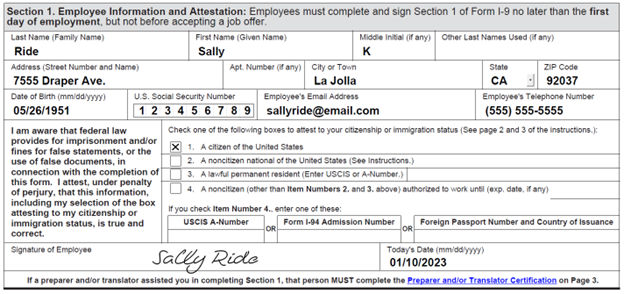
Employees must enter their current legal name and other last names that they have used in the past or present (such as a maiden name), if any.
- Employees with two last names (family names) must include both names in the Last Name field.
- Employees with only one name should enter it in the Last Name field and enter “Unknown” in the First Name field.
- Employees with two first names (given names) should include both in the First Name field.
- Employees whose first or last name includes a hyphen or apostrophe should include it.
- Examples of correctly entered last names include De La Cruz, O’Neill, Garcia Lopez, and Smith-Johnson.
- Examples of correctly entered first names include Mary Jo, John-Paul, Tae Young, and D’Shaun.
- Employees must enter their middle initial in the Middle Initial field. Employees who do not have a middle initial may leave this field blank.
- Employees must enter their maiden name or any other legal last name they may have used in the Other Last Names Used field. Employees who have not used other last names may leave this field blank.
Employees must enter their current address, apartment number (if any), city or town, state and ZIP code. If the residence is not located in a city or town, enter the village, county, township, reservation, etc. in the City or Town Field. Employees who do not have a street address should enter a description of the location of their residence, such as “Two miles south of I-81, near the water tower.” Employees who have no apartment number may leave this field blank. Border commuters from Canada or Mexico may enter their city; province or state; postal code; and their country abbreviation.
Employees must enter their date of birth as a two-digit month, two-digit day, and four-digit year (mm/dd/yyyy) in this field. For example, Jan. 8, 1980, should be entered as 01/08/1980.
Employees may voluntarily provide their Social Security number or leave this field blank. However, if you are enrolled in E-Verify, your employees must provide their Social Security number.
Employees who have not yet received their Social Security number and who can satisfy all other Form I-9 requirements may work while awaiting their Social Security number. Have them enter their Social Security number in Section 1 as soon as they receive it.
You cannot ask employees to provide a specific document with their Social Security number on it. To do so may constitute unlawful discrimination. For more information on E-Verify, see Section 1.2, E-Verify: The Web-Based Verification Companion to Form I-9. For more information on unlawful discrimination, see Section 11.0, Unlawful Discrimination and Penalties for Prohibited Practices.
Employees are not required to provide an email address or telephone number in Section 1. If they do not wish to enter an e-mail address or telephone number, they may leave these fields blank.
Employees must read the warning about penalties under federal law and attest to their citizenship or immigration status by checking one of the following boxes on the form:
- A citizen of the United States.
- A noncitizen national of the United States: An individual born in American Samoa, certain former citizens of the former Trust Territory of the Pacific Islands, and certain children of noncitizen nationals born abroad.
- A lawful permanent resident: This specific immigration status describes an individual who is not a U.S. citizen and who resides in the United States under legally recognized and lawfully recorded permanent residence as an immigrant. This term includes conditional residents, who should select this status. Employees who select this box should enter their seven- to nine-digit Alien Registration Number (A-Number) or USCIS Number in the space provided. The USCIS Number is the same as the A-Number without the “A” prefix. Asylees and refugees should NOT select this status, but should instead select “A noncitizen authorized to work.”
- A noncitizen (other than Item Numbers 2 or 3 above) authorized to work: An individual who is permitted to work in the United States, but is not a citizen or national of the United States, or a lawful permanent resident. For example, asylees, refugees, and certain citizens of the Federated States of Micronesia, the Republic of the Marshall Islands, or Palau should select this status. Employees who select box 4 must also enter the date their employment authorization expires. If it does not expire, the employee should enter N/A. If the employee’s employment authorization has been automatically extended, they should enter the expiration date of the automatic extension. Employees must also enter one of the following: Alien Registration Number (A-Number)/USCIS Number; Form I-94 Admission Number; or Foreign Passport Number and the Country of Issuance.
Employees must sign and date the form. Employees who cannot sign their name may place a mark in this field to indicate their signature.
If the employee uses a preparer and/or translator to help them complete and/or translate the form, each preparer and/or translator must complete a separate Preparer and/or Translator Certification block in Supplement A, Preparer and/or Translator Certification for Section 1.
Figure 1b: Completing Supplement A: Preparer and/or Translator Certification for Section 1
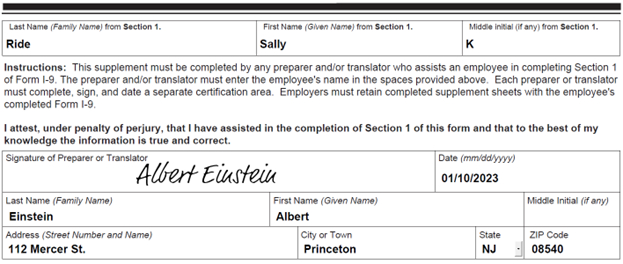
- Preparers and/or translators may not enter a P.O. box in place of a physical address.
- Employees who use a preparer and/or translator to complete the form must still sign or make their mark in the Signature Field in Section 1.
- Employers may provide the employee additional supplement pages as needed and attach them to the employee’s completed form.
- The certification must also be completed for certain minors and employees in special placement who require a representative, parent, or legal guardian to complete Section 1 for them. See Sections 4.2 and 4.3 for more information.
You must ensure that all parts of Form I-9 are properly completed; or you may be subject to penalties under federal law. The employee must complete Section 1 no later than the employee’s first day of employment. You may not ask an individual who has not accepted a job offer to complete Section 1. Before completing Section 2, you should review Section 1 to ensure the employee completed it properly. You may review the employee’s document(s) and fully complete Section 2 at any time between the date the employee accepts the job offer and completes Section 1 to within three business days of the hire. Review any possible errors with the employee. The employee must correct any confirmed errors, add their initials, and the date they made the correction. Employers may not ask for documentation to verify the information entered in Section 1.
4.0 Completing Section 2: Employer Review and Verification
Within three business days of the date employment begins, you or your authorized representative must complete Section 2 by examining original, acceptable, and unexpired documentation, or an acceptable receipt, the employee presents (see Table 1: Special Form I-9 Situations) to determine if it reasonably appears to be genuine and relates to the person presenting it. For example, if an employee begins employment on Monday, you must review the employee’s documentation and complete Section 2 on or before Thursday of that week. However, if you hire someone for less than three business days, you must complete Section 2 no later than the first day of employment.
In general, you or your authorized representative must review the employee’s documentation in their physical presence. However, if you participate in E-Verify, you may also be eligible to remotely examine the employee’s documents under the alternative procedure authorized by the secretary of homeland security. To see if you are eligible and for further guidance, please see Section 4.5, Remote Document Examination (Optional Alternative Procedure to Physical Document Examination), as well as I-9 Central and E-Verify.gov.
You must allow the employee to choose which documentation they will present from the Form I-9 Lists of Acceptable Documents and must accept documentation that reasonably appears to be genuine and relates to the person presenting it. You cannot specify which documentation an employee will present from the Form I-9 Lists of Acceptable Documents. When physically examining documents, copies, except for certified copies of birth certificates, are not acceptable. See Section 4.5, Remote Document Examination (Optional Alternative Procedure to Physical Document Examination) requirements.
You may terminate an employee who fails to present acceptable documentation (or an acceptable receipt for a document) within three business days after the date employment begins. If you fail to properly complete Form I-9, you risk violating section 274A of the INA and may be subject to civil money penalties.
Employees may choose to present either: 1) one document selected from List A or 2.) a combination of one selection from List B and one selection from List C.
- List A documentation shows both identity and employment authorization. Some documentation must be presented together to be considered acceptable List A documentation. If an employee presents acceptable List A documentation, do not ask them to present List B or List C documentation.
- Under certain circumstances, USCIS may automatically extend an employee’s employment authorization and/or employment authorization document beyond the expiration date on the document. An automatically extended document is considered unexpired for Form I-9. See Section 5.0, Automatic Extensions of Employment Authorization and/or Employment Authorization Documents (EADs) in Certain Circumstances.
List B documentation shows identity only and List C documentation shows employment authorization only. If an employee presents acceptable List B and List C documentation, do not ask them to present List A documentation.
- If you participate in E-Verify, and the employee presents a combination of List B and List C documentation, then the List B document must contain a photograph. For more information, visit e-verify.gov.
Table 1 Special Form I-9 Situations
|
Special Situation |
Solution |
Additional M-274 Guidance |
|
Employee presents a Social Security Card containing one of the following restrictions:
|
Because the restricted Social Security Card is not an acceptable List C document, ask the employee to provide a different document from List C or List A. |
|
|
Employee is a minor (individuals under age 18) and is unable to present an identity document from List B. |
Minor’s parent or legal guardian establishes identity for the minor by completing Section 1 on minor’s behalf and completing a Preparer and/or Translator Certification block in Supplement A. Minor must then only present an employment authorization document from List C. |
|
|
Employee who has a physical or mental impairment is placed in a job by a nonprofit organization, association, or as part of a rehabilitation program (special placement) and is unable to present an identity document for List B. |
Representative of the nonprofit organization, association, or rehabilitation program; parent; or legal guardian establishes identity for this employee by completing Section 1 on the employee’s behalf and completing a Preparer and/or Translator Certification. Employee must then only present an employment authorization document from List C. |
|
|
Employee has an expired EAD and/or employment authorization but qualifies for an automatic extension of employment authorization and/or Employment Authorization Document (EAD) by a Federal Register notice (FRN), a regulation, a Form I-797 or I-797C receipt notice, an individual letter/notice or a website notice. |
An EAD automatically extended by FRN or notice is an unexpired List A document for Form I-9. For more information on what the employee must present along with their EAD to complete Form I-9, please see Section 5. |
|
|
Employee presents an acceptable receipt in place of an unexpired List A, B, or C document. |
See Table 2 to determine how long each receipt is valid and what documents the employee must show once the receipt expires. |
Figure 2: Section 2: Employer or Authorized Representative Review and Verification
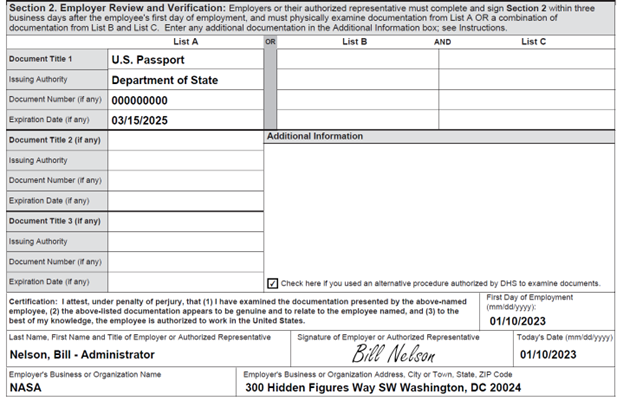
When completing Section 2, use information from the documentation the employee presented to enter the document title, issuing authority, document number, and expiration date (if any) in Section 2:
- Enter List A documents in the column on the left. If the employee presents List A documentation that consists of multiple documents, use the second and third List A areas, as well as the Additional Information area, if necessary, to enter those other documents. If you enter documents in the List A columns, you should leave the List B and C columns blank.
- Enter List B documents in the center column. If you enter a document in this column, you must also enter a document in the List C column. Leave the List A column blank.
- Enter List C documents in the column on the right. If the employee presents a List C document that consists of multiple documents, use the Additional Information area to enter those other documents. If you enter a document in this column, you must also enter a document in the List B column. Leave the List A column blank.
You may use either common abbreviations for states, document titles or issuing authorities, such as “DL” for driver’s license and “SSA” for Social Security Administration. Appendix A provides more abbreviation suggestions.
The “Additional Information” space is for Form I-9 notes, such as:
- Notations that describe extensions of employment authorization or a document’s expiration date for individuals in certain nonimmigrant categories or granted Temporary Protected Status (TPS). For more information, see Section 5.0, Automatic Extensions of Employment Authorization and/or Employment Authorization Documents (EADs) in Certain Circumstances, and Section 7, Evidence of Employment Authorization for Certain Categories.
- Information from additional documents that F-1 or J-1 nonimmigrant employees may present including the Student and Exchange Visitor (SEVIS) number and the program end date from Form I-20, Certificate of Eligibility for Nonimmigrant Student Status, or DS-2019, Certificate of Eligibility for Exchange Visitor (J-1) Status, as required.
- Replacement document information if a receipt was previously presented.
- Discrepancies that E-Verify participants must notate when participating in the IMAGE program.
- Any other optional comments or notations necessary for your business process, such as employee termination dates, form retention dates, and E-Verify case verification numbers.
Enter the first day of employment for wages or other remuneration in the space for “The employee’s first day of employment (mm/dd/yyyy).” Recruiters and referrers for a fee do not enter the employee’s first day of employment.
Staffing agencies may choose to use either the date an employee is assigned to the employee’s first job or the date the new employee is entered into the assignment pool as the first day of employment.
The same person who examined the employee’s documents must also complete the fields in the certification block, then sign and date Section 2, as shown in Figure 2 above. The employer or authorized representative signs and dates Section 2 in the spaces provided to attest to examining the documents the employee presented. Also enter title, last name, first name, and the employer’s business or organization name.
Enter the business’s physical street address, city or town, state, and ZIP code. If the location is not a city or town you may enter the name of the village, county, township, reservation, etc. that applies. Employers may not enter a P.O. box as their address. If your company has multiple locations, use the most appropriate address that identifies the location of the employer.
4.1 Retaining Copies of Documents Your Employee Presents
You may make copies (or electronic images) of the documentation you reviewed, but must return original documentation to the employee. If you make copies, they should be made consistently for all new hires and reverified employees, regardless of national origin, citizenship, or immigration status, or you may violate anti-discrimination laws.
Employers participating in E-Verify are required to retain a copy of certain documents if the employee chooses to present them. These documents include the U.S. Passport, passport card, Permanent Resident Card (also called a Green Card), or Employment Authorization Document (EAD). If you are an E-Verify employer who chooses to copy documentation other than those you are required to copy for E-Verify, you should apply this policy consistently with respect to Form I-9 completion for all employees.
If you choose to remotely examine employees’ documents, you must retain clear and legible copies of the front and back (if two-sided) of ALL Form I-9 documentation an employee presents remotely with the employee’s Form I-9. For further guidance on remotely examining documents, please see Section 4.5, Remote Document Examination (Optional Alternative Procedure to Physical Document Examination), I-9 Central and E-Verify.gov.
You must always complete Section 2 by reviewing original documentation, even if you copy an employee’s document(s) after reviewing the documentation. You are still responsible for completing and retaining Form I-9.
You must retain copies and present them with Forms I-9 in case of an inspection by DHS, the Department of Labor or the Department of Justice.
4.2 Minors (Individuals under Age 18)
Minors can complete Form I-9 as described in Section 4.0, Completing Section 2 of Form I-9, by presenting a List A document or a combination of List B and C documents. If a minor is unable to present an identity document from List B, a parent or legal guardian may establish identity for the minor by completing Form I-9 as shown in Figures 3a and 3b.
If you participate in E-Verify, parents or legal guardians cannot establish identity for a minor as described above. The minor must present either a List A document, or a combination of a List B document that contains a photograph and a List C document.
Figure 3a: Completing Section 1 of Form I-9 for Minors without List B Documents
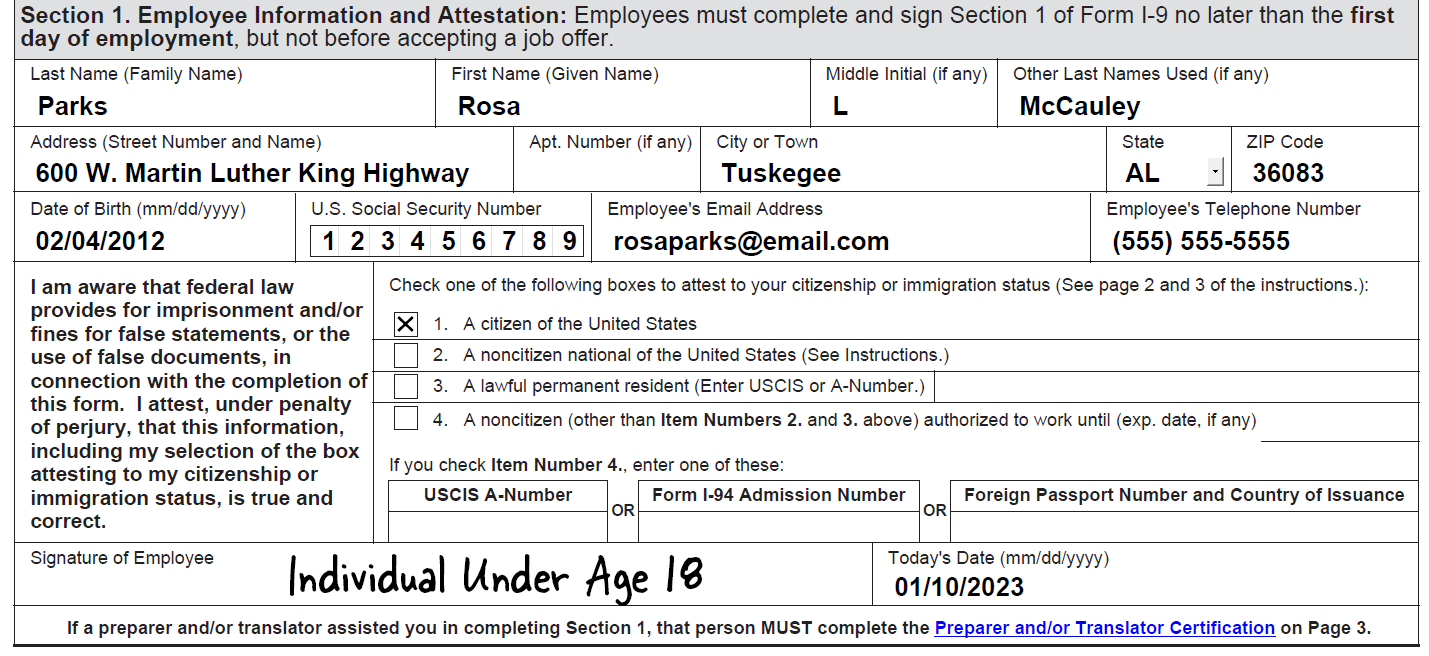
The minor’s parent or legal guardian completes Section 1 and enters “Individual under age 18” in the signature block. The parent or legal guardian completes a Preparer and/or Translator Certification block on Supplement A: Preparer and/or Translator Certification for Section 1.
Figure 3b: Completing Supplement A: Preparer and/or Translator Certification for Minors without List B Documents
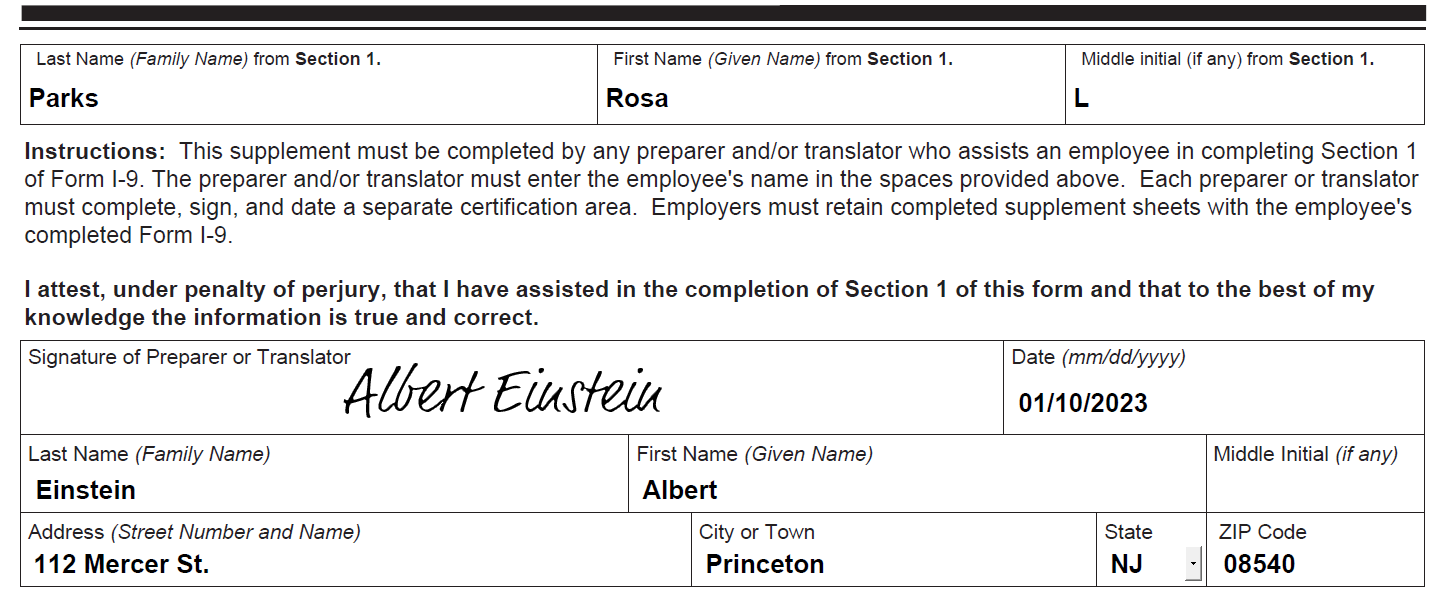
Figure 4: Completing Section 2 of Form I-9 for Minors without List B documents

- Enter “Individual under age 18” under List B and under List C, enter the document title, issuing authority, document number, and expiration date (if any) using information from the List C document the minor presented.
- Enter the date employment began.
- You or your authorized representative signs and dates Section 2 in the spaces provided to attest to examining the documents the employee presented. Also enter your title, last name and first name, as well as the employer’s business or organization name.
- Enter the business’s street address, city or town, state and ZIP code.
4.3 Employees with Disabilities (Special Placement)
Certain employees may have a physical or mental impairment which substantially limits one or more of their major life activities and are placed in jobs by a nonprofit organization, association, or as part of a rehabilitation program. Employees in this category who present List A documentation, or a combination of List B and C documentation, must complete Form I-9 as described in Section 4.0, Completing Section 2: Employer Review and Verification. If these employees are unable to present a List B document, they may establish identity under List B similar to minors, as shown in Figures 5a and 5b. These employees must still present a List C document.
If you participate in E-Verify, representatives of a nonprofit organization, association, or rehabilitation program; parents; and legal guardians cannot establish identity for an employee with disabilities as described above. This employee must present either List A documentation, or a combination of a List B document that contains a photograph and a List C document.
Figure 5a: Completing Section 1 of Form I-9 for Employees with Disabilities (Special Placement)
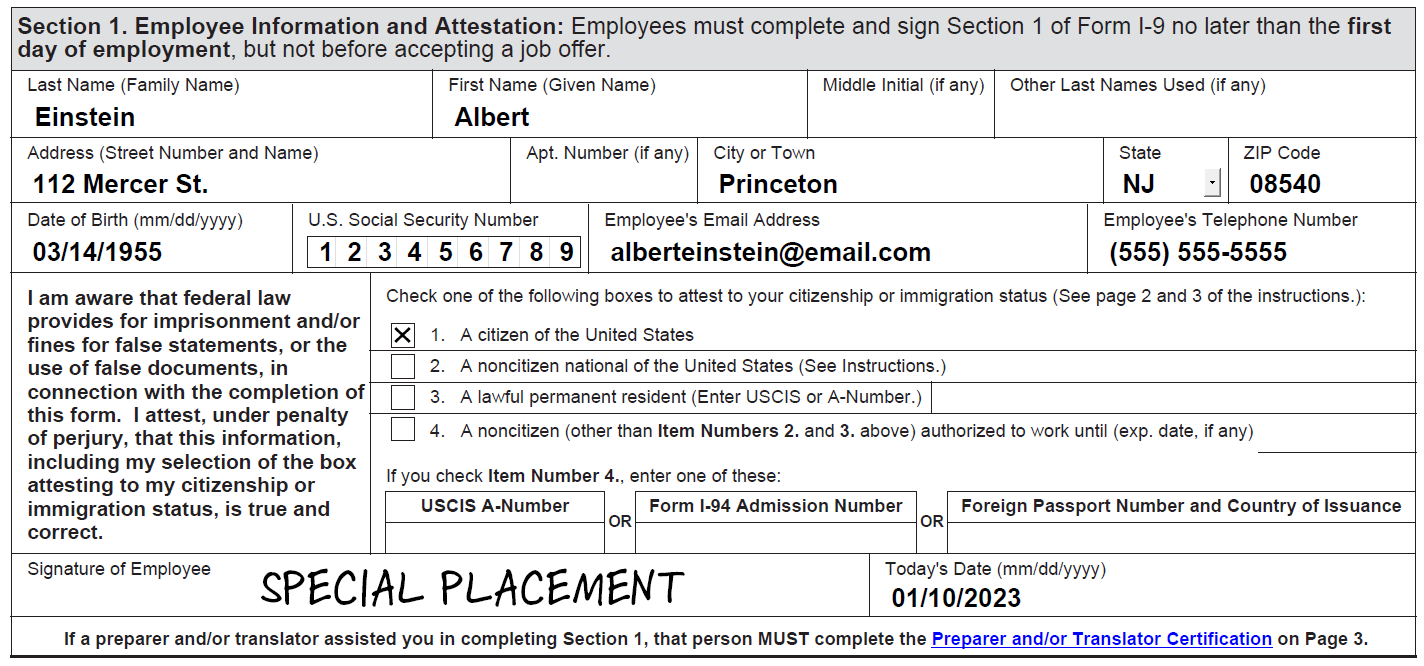
The representative of the nonprofit organization, association, or rehabilitation program; or the parent or legal guardian of the employee with a disability completes Section 1 and enters “Special Placement” in the Signature of Employee field and dates the form.
Figure 5b: Completing Supplement A for Employees with Disabilities (Special Placement)
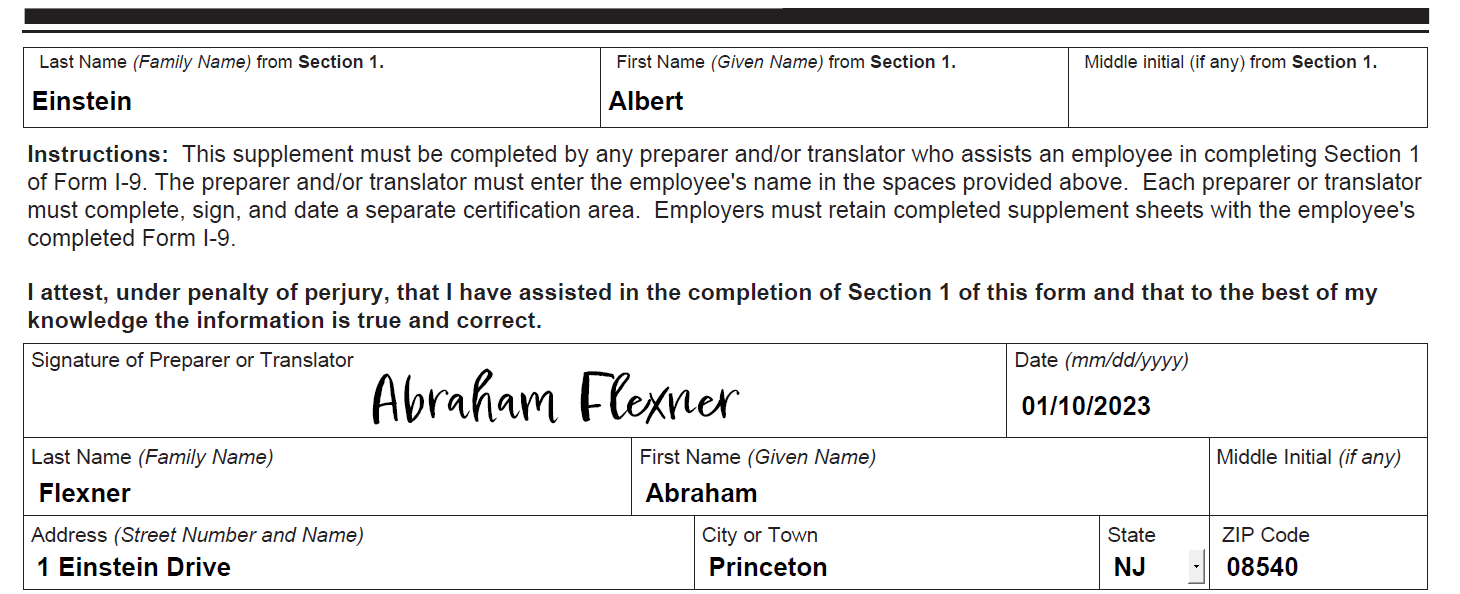
The same representative, parent, or legal guardian completes a Preparer and/or Translator Certification block on Supplement A: Preparer and/or Translator Certification for Section 1.
Figure 6: Completing Section 2 of Form I-9 for Employees with Disabilities (Special Placement)

- Enter “Special Placement” under List B and under List C, enter the document title, issuing authority, document number, and expiration date (if any) using information from the List C document the employee presented.
- Enter the date employment began.
- You or your authorized representative signs and dates Section 2 in the spaces provided to attest to examining the documents the employee presented. Whoever signs should also enter their title, last name, and first name, as well as the employer’s business or organization name.
- Enter the business’s street address, city or town, state, and ZIP code.
4.4 Acceptable Receipts
You must accept a receipt in place of List A, B, or C documentation if the employee presents one, unless employment will last less than three business days. New employees who choose to present a receipt must do so within three business days after their first day of employment, or for reverification or existing employees, by the date that their employment authorization expires.
Table 2 provides a list of acceptable receipts an employee can show. Enter the word “Receipt” followed by the title of the document in Section 2 under the list that relates to the receipt.
When your employee presents the original replacement document, cross out the word “Receipt,” then enter the information from the new documentation into the Additional Information field in Section 2, and initial and date the change.
Accepting a second receipt at the end of the initial receipt validity period is not permissible.
Table 2 Acceptable Receipts
|
Description of Receipt |
Who may present this receipt? |
Is this a List A, B, or C document? |
How long is this receipt valid for Form I-9 purposes? |
What document must the employee show at the end of the receipt validity period? |
|
The departure portion of a Form I-94, Arrival/Departure Record, with an unexpired refugee admission stamp or admission code of “RE.” |
Refugees |
List A |
90 days from date of hire or, for reverification, 90 days from the date employment authorization expires. |
An unexpired Employment Authorization Document (Form I-766), or a combination of a valid List B document and an unrestricted Social Security card. |
|
The arrival portion of a Form I-94, Arrival/Departure Record, containing a temporary I-551 (otherwise known as the Alien Documentation, Identification and Telecommunication (ADIT)) stamp and photograph. |
Lawful permanent residents |
List A |
Until the expiration date of the temporary I-551 (ADIT) stamp, or if there is no expiration date, one year from date of admission. |
The actual Form I-551, Permanent Resident Card, also known as a “Green Card.” |
|
A document that shows an employee applied to replace a lost, stolen, or damaged document. |
All employees |
Can be List A, B, or C, depending on which document the receipt relates to. |
90 days from date of hire or, for reverification, 90 days from the date employment authorization expires. |
The actual replacement document. You may also accept other Form I-9 documentation from the Lists of Acceptable Documents. If you accept documentation other than the actual replacement document, record the document information on Section 2 of a new Form I-9 and attach it to the original Form I-9. You should also note in the Additional Information box on the new Form I-9 the reason that documentation other than the replacement document was presented – for example, document delays, changes in status, or other factors – and sign and date the note.
|
|
Unexpired Form I-94, Arrival/Departure Record, containing a class of admission of UHP or OAR on the document or unexpired Form I-94 containing a class of admission of PAR and indicates Afghanistan as country of citizenship on the document
|
Certain Parolees |
List A |
90 days (or when the I-94 expires, if less) from date of hire or, for reverification, the date employment authorization expires. |
An unexpired Employment Authorization Document (EAD), or an unrestricted Social Security card and a List B identity document from the Form I-9 Lists of Acceptable Documents. |
|
An unexpired Form I-94, Arrival/Departure Record that contains a class of admission of DT issued between Feb. 24, 2022, and Sept. 30, 2023, and indicates Ukraine as the country of citizenship on the document
|
Ukrainian citizen parolees |
List A |
90 days (or when the I-94 expires, if less) from date of hire or, for reverification, the date employment authorization expires. |
An unexpired Employment Authorization Document (EAD), or an unrestricted Social Security card and a List B identity document from the Form I-9 Lists of Acceptable Documents. |
4.5 Remote Document Examination (Optional Alternative Procedure to Physical Document Examination)
Employers who participate in E-Verify in good standing are qualified to remotely examine their employee’s documentation using a DHS-authorized alternative procedure at their E-Verify hiring sites. This includes the use of an authorized representative acting on your behalf, such as a third-party vendor. If you choose to offer the alternative procedure to new employees at an E-Verify hiring site, you must do so consistently for all employees at that site. However, you may choose to offer the alternative procedure for remote hires only but continue to apply physical examination procedures to all employees who work onsite or in a hybrid capacity, so long as you do not adopt such a practice for a discriminatory purpose or treat employees differently based on their citizenship, immigration status, or national origin, such as by deciding that certain employees are not eligible for remote examination of their documentation. To examine your employee’s documentation remotely, you must be enrolled in good standing in E-Verify, and complete the following steps:
- Examine copies (front and back, if the document is two-sided) of Form I-9 documents or an acceptable receipt to ensure that the documentation presented reasonably appears to be genuine;
- Conduct a live video interaction with the individual presenting the document(s) to ensure that the documentation reasonably appears to be genuine and related to the individual. The employee must first transmit a copy of the document(s) to the employer (per Step 1 above) and then present the same document(s) during the live video interaction;
- Indicate on the Form I-9, by completing the corresponding box, that an alternative procedure was used to examine documentation to complete Section 2 or for reverification in Supplement B, as applicable; and
- Retain a clear and legible copy of the documentation (front and back if the documentation is two-sided).
In the event of a Form I-9 audit by a federal government official, make available the clear and legible copies of the identity and employment authorization documentation presented by the employee for document examination in connection with the employment eligibility verification process.
Figure 7: Checkbox in Section 2 to Indicate Remote Documentation Examination

Continue to complete the Form I-9 according to Form I-9 instructions and related guidance on I-9 Central and in the M-274, Handbook for Employers.
5.0 Automatic Extensions of Employment Authorization and/or Employment Authorization Documents (EADs) in Certain Circumstances
Some noncitizens with a pending Form I-765, Application for Employment Authorization, EAD renewal application filed under certain employment eligibility codes may be eligible to receive an up to 540-day automatic extension of their employment authorization and/or EAD if they meet the requirements stated in Sections 5.1 or 5.3. The increased automatic extension of employment authorization and/or EAD from up to 180 days to up to 540 days is authorized by two DHS temporary final rules published in the Federal Register:
- The first temporary final rule applies to eligible EAD renewal applications that were timely filed between May 4, 2022, and Oct. 26, 2023, and can be found at 87 FR 26614.
- The second temporary final rule applies to eligible EAD renewal applications that were timely filed between Oct. 27, 2023, and Sept. 30, 2025, and can be found at 89 FR 24628.
Under these temporary final rules, eligible employees with EADs that contain certain category codes are generally eligible for an automatic extension of their employment authorization and/or EADs for up to 540 days from the “Card Expires” date on the face of the EAD. See Figure 8 for an example that shows how to locate the category code and expiration date on an employee’s EAD.
Figure 8: Finding the Category Code and Expiration Date on an EAD (Form I-766)
The eligibility category appears on the EAD under “Category.” The expiration date appears to the right of “Card Expires,” see Figure 8 below:
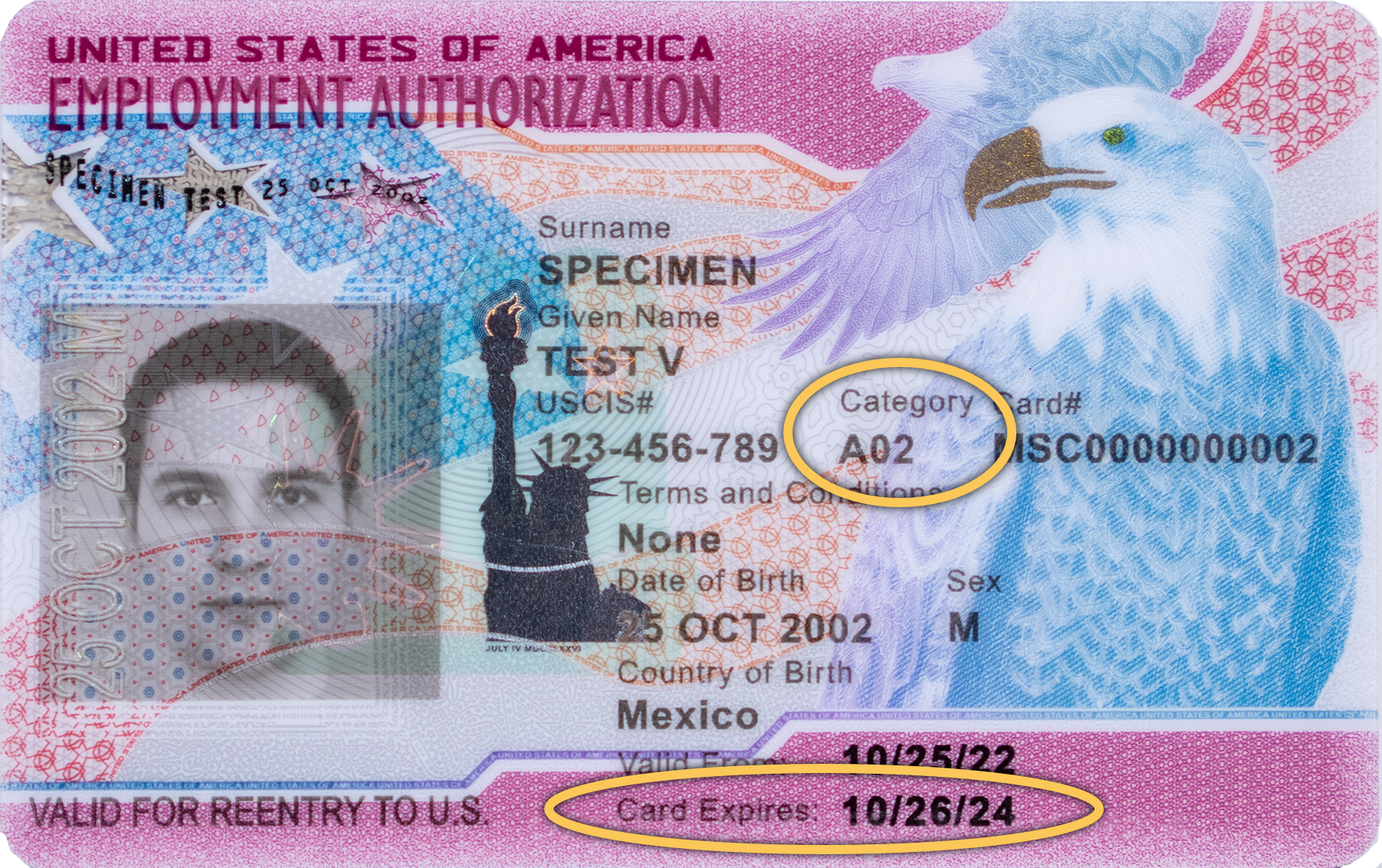
5.1 Automatic Extensions Based on a Timely Filed Application to Renew Employment Authorization and/or Employment Authorization Document
Some noncitizens in certain employment eligibility categories who timely file Form I-765, Application for Employment Authorization, to renew their employment authorization and/or EADs may receive automatic extensions of their employment authorization and/or EADs for up to 540 days while their renewal applications remain pending.
Those who timely and properly file(d) their EAD renewal applications between May 4, 2022, and Oct. 26, 2023, or between April 8, 2024, and Sept. 30, 2025, may be eligible to receive an extension of up to 540 days as provided by temporary final rules 87 FR 26614 and 89 FR 24628. Employees who timely filed their EAD renewal applications on or after Oct. 27, 2023, but before April 8, 2024, and whose applications remain pending on or after April 8, 2024, are also eligible to receive an extension of up to 540 days as provided by 89 FR 24628. The extension begins on the “Card Expires” date on face of their EAD and generally continues for up to 540 days as applicable, or until USCIS adjudicates the renewal application, whichever comes earliest. An automatic extension of employment authorization and/or EAD validity depends on these eligibility requirements:
- Employees must have timely and properly filed an application to renew their employment authorization and/or EAD on Form I-765, Application for Employment Authorization, before the EAD expires, and the Form I-765 EAD renewal application remains pending. Exception: Employees with EADs based on Temporary Protected Status (TPS) (A12 and C19), whose EAD renewal applications were filed during the re-registration period described in the Federal Register notice applicable to their country’s TPS designation, may receive the automatic extension, even if their renewal application was filed after the expiration date on the EAD.
- The eligibility category on the front of the employee’s EAD must have the same eligibility category as the employee’s Form I-797C, Notice of Action, issued for the corresponding EAD renewal application. Exceptions:
- In the case of an EAD and I-797C, Notice of Action, where each contains either an A12 or C19 TPS category code, the category codes do not have to match.
- For H-4 (C26), E (A17) and L-2 (A18) dependent spouses, an unexpired Form I-94 indicating H-4, E, or L-2 nonimmigrant status, including E-1S, E-2S, E-3S and L-2S class of admission codes, must accompany Form I-797C.
- Employees must have one of these qualifying eligibility categories to receive an automatic extension of their employment authorization and/or EAD validity: A03, A05, A07, A08, A10, A17*, A18*, C08, C09, C10, C16, C20, C22, C24, C26*, C31, and A12 or C19. The eligibility categories are published on the USCIS Automatic EAD Extension page. Some category codes on the EAD may include the letter ‘P’ such as C09P. Employers should disregard the letter ‘P’ when comparing the category code on the EAD with the category code on the Form I-797C, Notice of Action. *There are limitations on employees who file a Form I-765 renewal application within categories A17, A18, and C26 for an automatic extension. See A17, A18, and C26 guidance below.
If an employee is eligible for the automatic extension, acceptable proof of employment authorization and/or EAD validity during the automatic extension period includes: an EAD that appears expired on the face of the card presented with a Form I-797C, Notice of Action, that shows a timely filed EAD renewal application in the same employment eligibility category as the EAD (except TPS-based EADs and notices, which could have A12 or C19 category codes). See Automatic EAD Extensions for Temporary Protected Status (TPS) Beneficiaries in Section 5.3 for information on TPS-based EAD automatic extensions that may not require a Form I-797C, Notice of Action, and Guidance for Employees under Category Codes A17, A18, and C26 for information about the additional unexpired Form I-94 documentation that H-4, E, and L-2 dependent spouses need to present with a Form I-797C, Notice of Action.
Finding Information on Form I-797C: Sample A
I-797 RECEIPT NOTICE EXEMPLAR

The receipt number appears on Form I-797C, Notice of Action, in the Receipt Number field, as noted in number 1.
The filing date (the date USCIS received the application) appears in the Received Date field, as noted in number 2. Except as explained below for TPS beneficiaries, this date should be on or before the “Card Expires” date on the EAD. Also, if the “Received Date” is between May 4, 2022, and Sept. 30, 2025, the automatic extension period is up to 540 days from the “Card Expires” date on the face of the EAD. Certain TPS beneficiaries are eligible for this extension if they have timely and properly filed to renew their EAD during the re-registration period as directed in the Federal Register Notice applicable to their country’s TPS designation. Therefore, the filing date on a TPS beneficiary’s Form I-797C might be after the “Card Expires” date on their TPS-based EAD. For more information, go to https://www.uscis.gov/humanitarian/temporary-protected-status.
The category may appear on Form I-797C in the Class Requested field, as noted in number 3. If you do not see this field, see Sample B below.
Finding Information on Form I-797C: Sample B
I-797 RECEIPT NOTICE EXEMPLAR

The receipt number appears on Form I-797C in the Receipt Number field, as noted in number 1.
The filing date (the date USCIS received the application) appears in the Received Date field, as noted in number 2. This date should be on or before the “Card Expires” date on the EAD, unless the EAD renewal application and EAD are based on TPS. For TPS-based EADs, the date may be after the “Card Expires” date on the EAD (but must be during the re-registration period stated in the applicable TPS Federal Register Notice). See Section 5.3. The category may appear on Form I-797C in the Eligible Category field, as noted in number 3. The category may appear on Form I-797C in the Eligible Category field, as noted in number 3.
How to Complete Form I-9 for EADs Automatically Extended Based on a Pending Form I-765 Renewal Application
New Employees
New employees presenting an EAD that has been automatically extended must complete Section 1 as follows:
- Select “A noncitizen authorized to work until;” and
- Enter the date that is 540 days from the “Card Expires” date on the EAD as the expiration date of employment authorization. Employees whose status does not expire, such as refugees or asylees, should enter “N/A” as the expiration date.
In Section 2, in the List A column, the employer must:
- Enter “EAD” in the Document Title field.
- Enter the Card Number from the EAD in the Document Number field.
- In the Expiration Date field, enter the date 540 days from the “Card Expires” date on the EAD if the “Received Date” on Form I-797C is between May 4, 2022, and Sept. 30, 2025.
For automatic extensions the employer should enter “EAD EXT” in the Additional Information field. Additionally, since your employee’s extension is for up to 540 days, you may keep a copy of the USCIS webpage describing the temporary extension of up to 540 days with the employee’s Form I-9.
You may use the Employment Authorization Document (EAD) Automatic Extension Calculator to determine extended expiration dates.
Rehired Employees
For employees rehired within three years from the date you completed the employee’s previous Form I-9 and who qualify for this extension, you must complete Form I-9 following the process described above or in Section 6.2. If the employee’s original Form I-9 was completed on a Form I-9 that is no longer valid, you must either complete the latest version of Form I-9 or Supplement B, Reverification and Rehire, and attach it for this employee.
Current Employees
For a current employee whose employment authorization and/or EAD has been automatically extended and who presents a Form I-797C, Notice of Action, you must update Form I-9 enter the appropriate automatic extension expiration date in the Section 2 Additional Information field. Employers should also enter “EAD EXT” in the Additional Information field and may keep a copy of the USCIS webpage describing the temporary extension of up to 540 days with the employee’s Form I-9, if applicable. If the employee’s original Form I-9 was completed on a Form I-9 that is no longer valid, enter EAD EXT and the new expiration date in the Additional Information field in Section 2 of the latest version of Form I-9 and retain it with the employee’s original Form I-9.
Guidance for Employees under Category Codes A17, A18, and C26
Employees with EADs with category codes A17, A18, and C26 require additional documentation supplementing the Form I-797C, Notice of Action, to show that the EAD has been automatically extended. These employees must present a Form I-94, Arrival/Departure record indicating unexpired nonimmigrant status (E-1, E-1S, E- 2, E-2S, E-3, E-3S, H-4, L-2 or L-2S), along with a Form I-797C, Notice of Action, that shows a timely-filed EAD renewal application stating the “Class requested” as “(A17),” “(A18),” or “(C26),” and the EAD that appears expired on the face of the card as having been issued under the same category (that is, Category A17, A18, or C26).
For a new employee, in Section 2, in the List A column, the employer must:
- Enter “EAD” in the Document Title field.
- Enter the Card Number from the EAD in the Document Number field.
- In the Expiration Date field, enter the date that is 540 days from the “Card Expires” date on the EAD if the “Received Date” on Form I-797C is between May 4, 2022, and Sept. 30, 2025, or the end date of the Form I-94, whichever is earlier.
- Enter the Form I-94 document information in the second set of List A Document entry fields.
To calculate the new expiration date:
- Add 540 to the EAD “Card Expires” date.
- Compare the 540-day auto-extended date to the Form I-94 end date.
- Whichever date is earlier is the new EAD expiration date.
The employer should enter “EAD EXT” in the Additional Information field in Section 2. If applicable, you may keep a copy of the USCIS webpage describing the temporary EAD extension of up to 540 days with the employee’s Form I-9. Employers must reverify employment authorization at the end of the automatic extension period.
Updating Form I-9 for an Employee with An Existing 180-Day Automatic Extension
If your employee’s Form I-797, Notice of Action, for their EAD renewal application has a Received Date of Oct. 27, 2023, through April 7, 2024, and refers to a 180-day extension, and the EAD renewal application is still pending on or after April 8, 2024, the employee is eligible to receive an additional extension of 360 days as provided in the temporary final rule (FR 24628), for a total of 540 days counted from the “Card Expires” date stated on the face of the EAD. Employees whose EAD Category Codes are A17, A18, and C26 may not necessarily receive the full 360-day extension, and this is explained below in the For Category Codes A17, A18, and C26 guidance.
You must update the Additional Information field in Section 2 of the employee’s Form I-9 to include the new EAD expiration date no later than the date the employee’s 180-day automatic extension will end. Employers are not required to re-examine documents; however, your employee may present a Form I-797C, Notice of Action, EAD and, if applicable, Form I-94 again if you need to re-examine the “Card Expires” date and the category code(s) to determine eligibility and/or accurately calculate the increased automatic extension.
Your employee’s Form I-797C, Notice of Action, that refers to an automatic EAD extension of up to 180 days is acceptable evidence of the extension of up to 540 days, provided the above-described eligibility requirements are satisfied.
You should update the employee’s original Form I-9 to add 360 days to the employee’s EAD 180-day automatic extension date located in Section 2. You could also determine the automatic extension date by adding 540 days to the “Card Expires” date shown on the EAD. If the employee’s original Form I-9 was completed on a Form I-9 version that is no longer valid, you should enter the new EAD expiration date in the Additional Information field in Section 2 of a new Form I-9 and retain it with the employee’s original Form I-9.
Employers may keep a copy of the USCIS webpage describing the temporary EAD extension of up to 540 days with the employee’s Form I-9.
For Category Codes A17, A18, and C26
This guidance applies to employees who fall within category codes A17, A18, or C26 and therefore are either H-4, E, or L-2 dependent spouses, including E-1S, E-2S, E-3S and L-2S class of admission codes listed on Form I-94. Your employee’s automatic extension period cannot exceed the Form I-94 end date. Under this circumstance, your employee could have an extension that is greater than 180 days but less than the additional 360 days.
Your employee’s Form I-797C, Notice of Action, may refer to an automatic EAD extension of up to 180 days and is acceptable evidence of the 540-day extension, but cannot exceed the Form I-94 end date, provided the above-described eligibility requirements are satisfied.
In the Additional Information field of Section 2, you should enter either the Form I-94 end date or the EAD “Card Expires” date plus up to 360 days, whichever date is earlier. Note that if the employee’s original Form I-9 was completed on a Form I-9 version that is no longer valid, you should enter the new expiration date in the Additional Information field in Section 2 of a new Form I-9, initial and date the notation, and retain it with the employee’s original Form I-9.
Reverification
You must reverify employees’ employment authorization when the automatic extension of their employment authorization and/or EAD ends (whichever is earlier). You can reverify temporary employment authorization before the automatic extension ends if an employee presents any acceptable, unexpired document that shows employment authorization, such as any acceptable document from List A or C.
5.2 Temporary Increase of Automatic Extension of EADs from 180 Days to 540 Days
You must reverify employees’ employment authorization when the automatic extension of their employment authorization and/or EAD ends (whichever is earlier). You can reverify temporary employment authorization before the automatic extension ends if an employee presents any acceptable, unexpired document that shows employment authorization, such as any acceptable document from List A or C.
Updating Form I-9 for an Employee with An Existing 180-Day Automatic Extension
If your employee’s Form I-9 was completed on or after May 4, 2022, showed an EAD that was automatically extended by 180 days, the employee was eligible to receive an additional extension of 360 days as provided in the temporary final rule (87 FR 26614), for a total of 540 days counted from the “Card Expires” date stated on the face of the EAD. Employees whose EAD Category Codes are A17, A18 and C26 may not necessarily receive the full 360-day extension, and this is explained below in the For Category Codes A17, A18, and C26 guidance.
You must have updated the Additional Information field in Section 2 of the employee’s Form I-9 to include the new expiration date no later than the date the employee’s 180-day automatic extension ended. Employers were not required to re-examine documents; however, your employee may have presented a Form I-797C, Notice of Action, EAD and, if applicable, Form I-94 again if you needed to re-examine the “Card Expires” date and the category code(s) to determine eligibility and/or accurately calculate the increased automatic extension.
Your employee’s Form I-797C, Notice of Action, may have referred to an automatic EAD extension of up to 180 days and was acceptable evidence of the extension of up to 540 days, provided the above-described eligibility requirements are satisfied.
You should have updated the employee’s original Form I-9 to add 360 days to the employee’s EAD 180-day automatic extension date located in Section 2. You could have also determined the automatic extension date by adding 540 days to the “Card Expires” date shown on the EAD. Note that if the employee’s original Form I-9 was completed on a Form I-9 version that was no longer valid, you should have entered the new EAD expiration date in the Additional Information field in Section 2 of a new Form I-9 and retained it with the employee’s original Form I-9.
Employers may keep a copy of the USCIS webpage describing the temporary EAD extension of up to 540 days with the employee’s Form I-9.
For Category Codes A17, A18, and C26
This guidance applied to employees who fell within category codes A17, A18, or C26 and therefore were either H-4, E, or L-2 dependent spouses, including E-1S, E-2S, E-3S and L-2S class of admission codes on Form I-94. Your employee’s automatic extension period could not exceed the Form I-94 end date. Under this circumstance, your employee could have had an extension that was greater than 180 days but less than the additional 360 days.
Your employee’s Form I-797C, Notice of Action, may have referred to an automatic EAD extension of up to 180 days but was acceptable evidence of the extension of up to 540 days, but could not exceed the Form I-94 end date, provided the above-described eligibility requirements were satisfied.
In the Additional Information field of Section 2, you should have entered either the Form I-94 end date or the EAD “Card Expires” date plus up to 360 days, whichever date was earlier. Note that if the employee’s original Form I-9 was completed on a Form I-9 version that is no longer valid, you should have entered the new expiration date in the Additional Information field in Section 2 of a new Form I-9, initialed and dated the notation, and retained it with the employee’s original Form I-9.
Employment Authorization Resumption for Certain Categories Whose 180-Day Extension Had Expired as of May 4, 2022
(This guidance no longer applies to newly hired employees.) At its inception, the temporary final rule sought to reinstate expired EADs for certain categories who had a 180-day automatic extension that had passed without having received a new EAD. Beginning May 4, 2022, employment eligibility and/or EAD validity resumed for a period not to exceed 540 days from the “Card Expires” date on the EAD for qualifying noncitizens with a pending renewal Form I-765, Application for Employment Authorization, who experienced a gap in employment authorization and/or the validity of their EAD because their 180-day automatic extension ended prior to May 4, 2022.
The rule did not cure any unauthorized employment that may have accrued prior to issuance of the rule. To calculate whether there was any automatic extension time remaining, employers counted 540 days from the expiration date stated on the front of the EAD. If an employee fell within category codes A17, A18, or C26 and therefore were either H-4, E, or L-2 dependent spouses, including E-1S, E-2S, E-3S and L-2S class of admission codes on Form I-94, employers counted up to either 540 days or the expiration date on Form I-94, whichever was earlier. The last possible automatic extension based on this resumption of employment authorization was valid through April 28, 2023.
Your employee’s Form I-797C, Notice of Action, may have referred to an automatic EAD extension of up to 180 days and when combined with their EAD, was acceptable evidence of the extension of up to 540 days, provided that the above-described eligibility requirements were satisfied.
Reverification
You should have reverified employees’ employment authorization when their automatic extension ended, and no later than the date their employment authorization expired.
5.3 Automatic EAD Extensions for Temporary Protected Status (TPS) Beneficiaries
DHS may extend the expiration date of a TPS beneficiary’s EAD either by Federal Register notice or an individual notice mailed to the beneficiary. Based on the temporary final rule (89 FR 24628), certain TPS beneficiaries are eligible for an EAD extension based on the timely and proper filing to renew their EAD. For TPS-based EADs, timely filing under the temporary final rule means the EAD renewal application is filed during the TPS re-registration period indicated in the Federal Register notice for their country’s designation (for more information, see Section 5.1 Automatic Extensions Based on a Timely Filed Application to Renew Employment Authorization and/or Employment Authorization Document). You may not ask employees to prove they are nationals of a country that DHS has designated for TPS.
Automatic Extensions by Federal Register Notice (FRN)
FRNs announcing TPS actions generally include an automatic extension of the expiration date of all associated TPS EADs that contain a specific “Card Expires” date and a category code of A12 or C19. The FRNs provide detailed instructions for completing or updating Form I-9. For TPS EAD automatic extension information, check the USCIS TPS webpage.
How to Complete Form I-9 for EADs Extended by FRN
In Section 1, new employees presenting an EAD automatically extended by FRN must:
- Select “A noncitizen authorized to work;” and
- Enter the EAD automatic extension date provided in the appropriate FRN as the expiration date. Employees can find a link to their TPS country’s FRN on the USCIS TPS webpage.
In Section 2, in the List A column, the employer must:
- Enter “EAD” in the Document Title field.
- Enter the document number from the EAD with Category A12 or C19, as applicable.
- Enter the automatic extension date provided in the FRN as the document expiration date.
For a current employee whose EAD has been automatically extended by FRN, employers must provide updated information on Form I-9. They should enter “EAD EXT” and the EAD automatic extension date from the FRN in the Additional Information field in Section 2. For example, EAD EXT mm/dd/yyyy. If the employee’s original Form I-9 was completed on a Form I-9 version that is no longer valid, complete the latest version of Form I-9 as described above and retain it with the employee’s original Form I-9.
Automatic Extensions by Individual Notice
DHS may extend the EAD expiration date for some or all TPS beneficiaries of a certain country by issuing an individual notice that contains the new EAD expiration date. Check the USCIS TPS webpage for the latest information on TPS countries whose beneficiaries may have been issued individual notices.
New employees who are TPS beneficiaries may present the individual notice, along with their EAD with a Category Code of A12 or C19, to complete Form I-9. Employers should ensure the employee’s name and A-Number or USCIS Number on the EAD matches the name and A-Number or USCIS Number, provided in the individual notice.
How to Complete Form I-9 for EADs Extended by Individual Notices
In Section 1, new employees presenting an EAD automatically extended by an individual notice must:
- Select “A noncitizen authorized to work until;” and
- Enter the EAD automatic extension date provided in the individual notice as the expiration date.
In Section 2, in the List A column, the employer must:
- Enter EAD in the Document Title field.
- Enter the document number from the EAD with Category A12 or C19, as applicable.
- Enter the automatic extension date provided in the individual notice as the document expiration date.
For a current employee whose EAD has been automatically extended by individual notice, you must provide updated information on Form I-9. You should enter “EAD EXT” and the EAD automatic extension date from the individual notice in the Additional Information field in Section 2. For example, EAD EXT mm/dd/yyyy. Note that if the employee’s original Form I-9 was completed on a Form I-9 version that is no longer valid, enter “EAD EXT” and the new expiration date in the Additional Information field in Section 2 of the latest version of Form I-9 and retain it with the employee’s original Form I-9.
Reverification
You must reverify employees’ employment authorization when their automatic extension ends, and no later than the date their employment authorization expires. You can reverify temporary employment authorization before the automatic extension ends if an employee presents any unexpired document that shows employment authorization, such as any acceptable document from List A or C.
6.0 Completing Supplement B, Reverification and Rehire of Form I-9
Reverification is never required for U.S. citizens or noncitizen nationals. Reverification is also never required when the following documents expire: U.S. passports, U.S. passport cards, Permanent Resident Cards (also known as Green Cards), and List B documents. Other noncitizens may require reverification
6.1 Reverifying Employment Authorization for Current Employees
You must reverify an employee’s employment authorization no later than the date employment authorization expires. The employee must present a document that shows current employment authorization, such as any documentation from List A or C, including an unrestricted Social Security card. You must reject a restricted Social Security card and ask the employee to provide a different document from List A or C. You can also accept certain receipts for reverification; see the Acceptable Receipts table in Section 4.4, Acceptable Receipts, for more information. You cannot continue employing a person who does not provide proof of current employment authorization.
When you must reverify an employee, you will complete one block of Supplement B, Reverification and Rehire (formerly Section 3) and attach it to the employee’s original Form I-9. You may use additional blocks on this supplement for subsequent reverifications or updates, attaching additional supplement sheets as needed. If the employee’s previous update or reverification was completed on a Form I-9 version that is no longer valid, you must also complete Supplement B, Reverification and Rehire and attach it to the employee’s original Form I-9. Please check uscis.gov/i-9 for the current Form I-9.
To reverify your employee using Supplement B, Reverification and Rehire:
- Enter the employee’s full name from the original Form I-9 at the top of the supplement.
- If the employee’s name has changed, enter the new name in the appropriate New Name fields in one block of the supplement. Enter only the part of the name that has changed. For example, for employees who changed only their last name, enter the last name in the Last Name field and leave the First Name and Middle initial fields blank.
- Enter the document title, number and expiration date in that block of the supplement.
- You must sign, date and enter your name in the appropriate fields in that block. Keep this supplement page with the original Form I-9.
Some employees may have entered N/A in the expiration date field in Section 1 if they are noncitizens whose employment authorization does not expire, such as asylees, refugees, or certain citizens of the Federated State of Micronesia, the Republic of the Marshall Islands, or Palau. Reverification does not apply for such individuals unless they choose to present evidence of employment authorization in Section 2 that contains an expiration date and requires reverification, such as Form I-766, Employment Authorization Document. Employees with expiring immigration status, employment authorization, or employment authorization documents should have the necessary application or petition filed well in advance to ensure they maintain continuous employment authorization and/or valid documents. USCIS provides employment authorization extensions under certain conditions. See Section 7.0, Evidence of Employment Authorization for Certain Categories, for more information.
6.2 Reverifying or Updating Employment Authorization for Rehired Employees
If you rehire employees within three years from the date you completed their previous Form I-9, you may complete a block on Supplement B, Reverification and Rehire, or you instead complete a new Form I-9.
Figure 9: Completing Supplement B, Reverification and Rehires

If completing a Supplement B block for a rehired employee, follow these guidelines:
- If they are still authorized to work, they do not need to provide any additional documents. This includes U.S. citizens, noncitizen nationals, and lawful permanent residents who presented a Form I-551. For these employees, you must:
- Enter the employee’s full name from the original Form I-9 at the top of the supplement. Enter any name change in the New Name fields. Enter only the part of the name that has changed. For example, for employees who changed only their last name, enter the last name in the Last Name field and leave the First Name and Middle Initial fields blank.
- Enter their rehire date in the Date of Rehire field.
- Enter your name and sign and date the supplement block.
- If their employment authorization has expired, you must:
- Enter the employee’s full name from the original Form I-9 at the top of the supplement.
- Enter any name change in the New Name fields.
- Enter the rehire date in the Date of Rehire field.
- Reverify their employment authorization in the Expiration Date fields.
- Enter your name and sign and date the supplement block.
- If the previous Form I-9 is an old version of the form, you must complete a new block in Supplement B on the current version of the form. Please check uscis.gov/i-9 for the current Form I-9.
- If you already used a block in Supplement B of the employee’s previous Form I-9, but are rehiring them within three years of the date the original Form I-9 was completed, complete a subsequent block on the supplement. Employees rehired three years after you originally completed their Form I-9 must complete a new Form I-9.
- Enter the employee’s new name, if applicable.
- Enter the employee’s date of rehire, if applicable
- Enter the List A or C document title, number, and expiration date (if any)
- Sign and date the block of the supplement you completed.
Note: If you need to reverify the employment authorization of an existing employee who completed an earlier version of Form I-9, the employee may choose any List A or C document(s) from the Lists of Acceptable Documents for the most current version of Form I-9. Enter the information from the new document(s) in Supplement B, Reverification and Rehire of the current version of Form I-9 and keep it with the previously completed Form I-9. Visit uscis.gov/i-9 for the most current version of Form I-9.
6.3 Recording Changes of Name and Other Identity Information for Current Employees
During reverification or rehire, if an employee has had a legal name change (such as by getting married), you must enter their new legal name in the New Name fields of a block of Supplement B, Reverification and Rehire, as described in Sections 6.1 and 6.2. If they legally changed their name at any other time, we recommend you update the New Name fields in a subsequent block on the original supplement page or a new supplement page as needed, as soon as you learn of the change, so that you maintain correct information on the form.
To enter a legal name change in Supplement B, Reverification and Rehire without reverification or rehire:
- Enter the employee’s new name in the New Name fields.
- Enter your name and sign and date the block you completed on Supplement B, Reverification and Rehire.
In either situation, you should take steps to ensure the employee’s name change is accurate. This may include asking them to provide legal documentation showing the name change, such as a marriage certificate. Make a copy of that document to keep with Form I-9 in the event of an inspection.
You may encounter situations other than a legal name change where an employee informs you (or you have reason to believe) that their identity is different from what they used to complete their Form I-9. For example, an employee may have been working under a false identity, has subsequently obtained work authorization in their true identity, and wishes to regularize their employment records. In that case, you should complete a new Form I-9. Write the original hire date in Section 2 and attach the new Form I-9 to the previously completed Form I-9 and include a written explanation.
In cases where an employee has worked for you using a false identity but demonstrates current authorization to work in the United States, Form I-9 rules do not require termination of employment.
In addition, there may be other laws, contractual obligations, or company policies that you should consider before taking action. For example, the INA prohibits discrimination based on citizenship, immigration status, and national origin. See Section 11.0, Unlawful Discrimination and Penalties for Prohibited Practices, for more information.
For E-Verify employers:
- Your employees should record their legal name change with the SSA to avoid mismatches in E- Verify. For more information, visit www.e-verify.gov.
- If you complete a new Form I-9 based on a non-legal name change, you should confirm the new Form I-9 information through E-Verify. If you do not complete a new Form I-9, you should not create a new E-Verify case.
- Federal contractors who are subject to the Federal Acquisition Regulation (FAR) E-Verify clause and who choose to verify existing employees by updating an already-completed Form I-9 are subject to special rules regarding when they must complete a new Form I-9. If you choose to update Form I-9 for existing employees, you must complete a new Form I-9 when an employee changes their name. For more information, see the E-Verify Supplemental Guide for Federal Contractors, at e-verify.gov.
7.0 Evidence of Employment Authorization for Certain Categories
This section includes multiple subsections that provide guidance on the evidence of employment authorization that certain categories of immigrants and non-immigrants can present when completing Form I-9, including lawful permanent residents, Native Americans, refugees and asylees, exchange visitors and students, H-1B and H-2A workers, extensions of stay for other nonimmigrant categories, T and U nonimmigrants, and other temporary workers.
7.1 Lawful Permanent Residents (LPR)
You must allow employees to choose which document(s) they will present from the Lists of Acceptable Documents. In Section 2, an LPR may choose to present a List A document (such as Form I-551, Permanent Resident Card, commonly referred to as a Green Card) or a List B and C document combination (such as a state-issued driver’s license and unrestricted Social Security card). You are not required to reverify the employment eligibility of a lawful permanent resident who presented these documents and you should not reverify their employment authorization.
Forms I-551 may have:
- No expiration date. We issued these cards from January 1977 to August 1989.
- A 10-year expiration date.
- A two-year expiration date.
LPRs may also present an expired or expiring PRC in combination with either of these receipt notices as a List A document:
- Form I-797, Notice of Action, receipt notice for Form I-90, Application to Replace Permanent Resident Card.
- Form I-797C, Notice of Action, receipt notice for Form N-400, Application for Naturalization, that contains an automatic extension of the Permanent Resident Card.
The receipt notice extends the Permanent Resident Card’s validity beyond the date on the front of the card. The receipt notice will specify the length of the automatic extension.
Reverification is never required when any of the documents listed above in this section expire.
Temporary Form I-551 Requires Reverification
If an LPR or conditional resident presents one of the temporary Forms I-551 listed below, you must reverify their employment authorization using Supplement B, Reverification and Rehire:
- List A receipt: The arrival portion of Form I-94, Arrival/Departure Record, containing an unexpired temporary I-551 (ADIT) stamp and a photograph of the employee. The employee must present their Form I-551 to you no later than when the stamp expires, or one year after U.S. Customs and Border Protection issues the Form I-94 if the stamp does not contain an expiration date.
- List A document: A foreign passport with either a temporary I-551 (ADIT) stamp or I-551 printed notation on a machine-readable immigrant visa (MRIV). The employee must present a List A or List C document to you when the stamp expires, or one year after the admission date if the stamp does not contain an expiration date.
- Most MRIVs contain the following language on the visa: “UPON ENDORSEMENT SERVES AS TEMPORARY I-551 EVIDENCING PERMANENT RESIDENCE FOR 1 YEAR.” The one-year time period begins on the date of admission. If the employee receives an MRIV without the statement “FOR 1 YEAR,” you should treat the MRIV as evidence of permanent residence status for one year from the date of admission.
- If the stamp in the passport is endorsed “CR-1” and is near but not on the MRIV, it is still a valid endorsement.
- Enter the number in red font under the MRIV “Expires On” date as the document number.
- List C document: An expired PRC with a Form I-797, Notice of Action, receipt notice for either a Form I-751, Petition to Remove Conditions or a Form I-829, Petition by Investor to Remove Conditions on Permanent Resident Status, that indicates USCIS has extended the card’s validity. You must reverify the employee’s employment authorization before their extension ends.
7.2 Native Americans
Native Americans may present a List A document or List B and C document for Form I-9.
A Native American tribal document is an official tribal or community membership document issued by a Native American Indian tribe, or an Alaska Eskimo or Aleut community, that is recognized by the U.S. federal government. A tribal or community membership document that is issued by a tribe or community that is not recognized by the U.S. federal government is not an acceptable Native American tribal document for Form I-9 purposes. Because federal recognition of tribes and communities can change over time, you should check the Department of Interior’s Bureau of Indian Affairs website to determine if the tribe or community that issued the tribal or community membership document is federally recognized. Use the following guidance to determine if the document is acceptable as evidence of both identity and employment authorization, or only for identity purposes.
Table 3 Native American Tribal Documents
| If your employee presents a Native American tribal document and in Section 1 selects: | The document is acceptable as: |
|---|---|
|
Citizen of the United States |
List B and List C |
|
Lawful permanent resident |
List B and List C |
|
Noncitizen authorized to work |
List B only |
The following documents are not considered Native American tribal documents for Form I-9 purposes and are not acceptable as a List A, List B or List C document:
- A tribal membership document issued by a Canadian First Nation; and
- A Certificate of Indian Status (commonly referred to as an "INAC card") issued by Indigenous and Northern Affairs Canada.
While individuals who have these documents might qualify for employment authorization under INA section 289 (and, if applicable, 8 CFR 289.2), a tribal membership card issued by a Canadian First Nation, or INAC card issued by the Government of Canada cannot, by itself, establish employment authorization.
If you participate in E-Verify, all List B documents presented by employees, including Native American tribal documents, must contain a photograph. This includes Native American tribal documents presented as a List B document. If the employee's Native American tribal document does not contain a photograph, you should request the employee provide a different List B document with a photograph. The Native American tribal document may be acceptable as the employee's List C document, see table above. Your employee may also choose to provide a List A document instead of a List B and List C document.
7.3 Refugees and Asylees
Refugees and asylees are employment eligible incident to their status and are authorized to work indefinitely because their immigration status does not expire. They may present any List A document or a combination of List B and List C documents from the Form I-9 Lists of Acceptable Documents to demonstrate identity and employment authorization. Employees may also present an acceptable receipt instead of the List A, B or C document. For more information about receipts, including the receipts refugees and asylees may present, see the information below in this section or Section 4.4, Acceptable Receipts.
Refugees
Upon admission to the United States, DHS provides refugees with a Form I-94, Arrival/Departure Record, which does not expire.
When completing Form I-9, refugees should check “A noncitizen authorized to work” and enter “N/A” on the Expiration Date field in Section 1, even if they have an EAD with an expiration date.
The departure portion that contains an unexpired refugee admission stamp or an electronic Form I-94 with an admission class of “RE” is an acceptable receipt establishing both employment authorization and identity for 90 days. If the refugee presents this receipt, at the end of the 90-day receipt period, the refugee must present either an EAD or a document from List B, such as a state-issued driver’s license, with a document from List C, such as an unrestricted Social Security card.
Refugees may also present an expired EAD with a Form I-797C, Notice of Action, if the notice lists the same employment authorization category as the expired EAD. This combination is considered an unexpired List A document and is valid for up to 540 days after the “Card Expires” date on the EAD. For more information, see Section 5.0, Automatic Extensions of Employment Authorization and/or Employment Authorization Documents (EADs) in Certain Circumstances.
Table 4: Documentation Refugees May Present
This table provides examples of documentation refugees may present to complete Form I-9 and whether the reverification of employment authorization is required.
| Document | Additional Guidance | Is Reverification Required? |
|---|---|---|
| Form I-766, Employment Authorization Document (EAD) (List A) | Yes, employee may present a List A or List C document or receipt for reverification. | |
| Form I-766, Employment Authorization Document (EAD) that appears expired on the face of the card with a Form I-797C issued for a Form I-765 renewal application (List A) | Section 5.0 Automatic Extensions of Employment Authorization and/or Employment Authorization Documents (EADs) in Certain Circumstances for eligibility requirements and extension period. | Yes, employee may present a List A or List C document or receipt for reverification. |
Form I-94 with:
Note: Form I-94 does not expire. |
No passport is needed. While the I-94 does not expire, this document is an acceptable receipt that is valid for 90 days. At the end of the 90-day receipt period, the employee must present an unexpired Form I-766, Employment Authorization Document (EAD) or a valid List B document and an unrestricted Social Security card. | If the employee presents an EAD at the end of the receipt period, you must reverify the employee’s employment authorization when that EAD expires.
If the employee presents an unrestricted Social Security card and List B document, you may not reverify this employee’s employment authorization. |
| Receipt for a lost, stolen or damaged Form I-766, Employment Authorization Document (EAD) (List A) | Acceptable receipt for 90 days. At the end of the receipt period the employee should show the replacement document. Alternatively, you may accept other Form I-9 documentation from the Lists of Acceptable Documents. | If the employee presents an EAD at the end of the receipt period, you must reverify the employee’s employment authorization when that EAD expires.
If the employee presents an unrestricted Social Security card and List B document, you may not reverify this employee’s employment authorization. |
| Form I-571, Refugee Travel Document (List C) | Can be presented with any List B identity Document | Yes, employee may present a List A or List C document or a receipt for reverification. |
Asylees
After being granted asylum in the United States, DHS issues a Form I-94, Arrival/Departure Record, to asylees. Form I-94 will contain a stamp or notation, such as “asylum granted indefinitely” or the appropriate provision of law (8 CFR 274a.12(a)(5) or INA 208) to show their employment authorization. The asylee does not need to present a foreign passport with this Form I-94. An asylee can also present an electronic Form I-94 with an admission class of “AY.” Form I-94 is an acceptable List C document and does not expire or require reverification. Asylees who choose to present this document must also present a List B identity document, such as a state-issued driver’s license or identification card.
When completing Form I-9, asylees should indicate “a noncitizen authorized to work” and enter “N/A” on the expiration date line in Section 1, even if they have an EAD with an expiration date.
USCIS issues EADs to asylees. These are acceptable List A documents; however, decisions from immigration judges or the Board of Immigration Appeals granting asylum are not acceptable List C documents because they are not issued by DHS.
Table 5: Documentation Asylees May Present
This table provides examples of documentation asylees may present to complete Form I-9 and whether reverification of employment authorization is required.
| Document | Additional Guidance | Is Reverification Required? |
|---|---|---|
| Unexpired Form I-766, Employment Authorization Document (EAD) (List A) | Yes, employee may present a List A or List C document or receipt for reverification. | |
| Form I-766, Employment Authorization Document (EAD) that appears expired on the face of the card with a Form I-797C issued for a Form I-765 renewal application (List A) | See Section 5.0 Automatic Extensions of Employment Authorization and/or Employment Authorization Documents (EADs) in Certain Circumstances
for eligibility requirements and extension period. |
Yes, employee may present a List A or List C document or receipt for reverification. |
| Receipt for a lost, stolen or damaged Form I-766, Employment Authorization Document (EAD) (List A) | Acceptable receipt for 90 days. At the end of the receipt period, the employee should show the replacement document. Alternatively, you may accept other Form I-9 documentation from the Lists of Acceptable Documents. | If the employee presents an EAD at the end of the receipt period, you must reverify the employee’s employment authorization when that EAD expires.
If the employee presents an unrestricted Social Security card and List B document, you may not reverify this employee’s employment authorization. |
Form I-94 (List C) that contains either:
|
No passport is needed.
Can be presented with any List B identity Document Note: Form I-94 does not expire. |
7.4 Exchange Visitors and Students
Each year, thousands of exchange visitors, international students, and their dependents come to the United States to study and work.
7.4.1 Exchange Visitors (J-1)
Exchange visitors may work in the United States if the work is part of the participants’ approved program (for example, J-1 teachers, professors, summer camp counselors, summer work travel, au pairs) or when the official program sponsor approves their employment (for example, J-1 students). Employers may not employ a J-1 participant knowing that the exchange visitor is performing work outside of their approved program.
The Department of State (DOS) administers exchange visitor programs and designates the sponsors. Program sponsors issue Form DS-2019, Certificate of Eligibility for Exchange Visitor (J-1) Status to participants. Exchange visitors come to the United States for a specific period of time to participate in a particular program or activity, as described on their Form DS-2019. Only J-1 exchange visitors with employment authorized under the terms of their program may use Form DS-2019 as documentation when completing Form I-9.
Currently, DOS designates public and private entities to act as exchange sponsors for the following programs.
Exchange Visitor Programs
- Professors and research scholar
- Short-term scholars
- Trainees and interns
- College and university students
- Teachers
- Secondary school students
- Specialists
- Physicians
- International visitors
- Government visitors
- Camp counselors
- Au pairs
- Summer work travel
Memorandum of Understanding (MOU) Programs
- Summer work/travel: Australia and New Zealand
- WEST (Work/English Study/Travel): South Korea
- Intern work/travel: Republic of Ireland
- Intern/trainee (Innovative Programs): Portugal
- Intern program (Sciences, engineering, architecture, mathematics, and industrial occupations) Mexico
High school or secondary school students and international visitors are not authorized to work.
Responsible officers may authorize other J-1 students for part-time on-campus employment according to the terms of a scholarship, fellowship, assistantship, or off- campus employment based on serious, urgent, or unforeseen economic circumstances. Responsible officers may also authorize J-1 students for a maximum of 18 months (or, for Ph.D. students, a maximum of 36 months) of practical training during or immediately after their studies. J-1 practical training includes paid off- campus employment and/or unpaid internships that are part of the student’s program of study. Their responsible officer must authorize employment in writing for practical training. Special rules apply to student interns.
Employment for other J-1 exchange visitors is sometimes job- and site-specific or limited to a few months.
For more information about these categories and their employment authorization, contact the responsible officer whose name and telephone number are on the employee’s Form DS-2019 or go to the DOS website at j1visa.state.gov.
DHS issues exchange visitors Forms I-94 indicating J-1 nonimmigrant status. DOS-designated program sponsors issue Form DS-2019 endorsed by a responsible officer, which indicates the type of work an exchange visitor is authorized to perform. For J-1 students, the responsible officer prepares additional informal documentation (a letter) that verifies employment authorization.
The J-1 exchange visitor must enter the DS-2019 Program End Date in Section 1 as the date employment authorization expires. A J-1 student must enter in Section 1 the end date from their responsible officer letter authorizing employment or the program end date on the DS-2019 if issued for academic training.
In Section 2, you may enter:
- A List A document, including the combination of: A foreign passport;
- Form I-94 indicating J-1 nonimmigrant status; and
- Form DS-2019 with the responsible officer’s endorsement.
- Enter the Student and Exchange Visitor Information System (SEVIS) number as the document number and the program end date as the document expiration date.
- A J-1 student must also provide a letter from the responsible officer. Enter the document information in the Additional Information field.
or
List B and C documents:
- For example, a state driver’s license (List B) and a Form I-94 indicating J-1 nonimmigrant status with a properly endorsed Form DS-2019 (List C #7).
- Enter the SEVIS number as the document number and the program end date as the expiration date.
- A J-1 student must also provide a letter from the responsible officer. Enter the information in the Additional Information field.
If the J-1 exchange visitor transfers to a different program or changes their sponsor, their Form DS-2019 must indicate the new program or sponsor.
Some exchange visitors may extend their status. If you have questions about any exchange visitor’s continued employment authorization, contact the responsible officer whose name and telephone number are listed on the employee’s Form DS-2019.
Dependents of a J-1 exchange visitor are classified as J-2 nonimmigrants and are only authorized to work if USCIS issued an EAD to them. A J-2 nonimmigrant’s foreign passport and Form I-94 are not evidence of identity and employment authorization for Form I-9 purposes.
7.4.2 F-1 and M-1 Nonimmigrant Students
Foreign students pursuing academic studies and/or language training programs are classified as F-1 nonimmigrants, while foreign students pursuing nonacademic or vocational studies are classified as M-1 nonimmigrants. Designated school officials (DSO) at certified schools issue Form I-20, Certificate of Eligibility for Nonimmigrant (F-1)/(M-1) Students. Foreign academic or vocational students may work in the United States under certain circumstances. DHS issues documents showing employment authorization based on the type of student they are and the type of employment they have.
Academic Students in F-1 Nonimmigrant Status
F-1 students may not work off-campus during the first academic year but may accept on-campus employment subject to certain conditions and restrictions. After the first academic year, F-1 students may seek off-campus employment through a variety of programs. The following table shows where students can locate their “Authorized to Work Until” date for Section 1, as well as the types of documents they may receive and could present to you for Form I-9 purposes.
|
F-1 Employment Type |
Students: Where to Find Your “Authorized to work until” Date for Section 1 |
Employers: Section 2 Acceptable Documents |
|
On campus |
Form I-20, Certificate of Eligibility for Nonimmigrant Student Status, program end date |
Unexpired foreign passport and Form I-94, Arrival/Departure Record Or List B and List C document (unexpired Form I-94) |
|
Curricular practical training (CPT) |
Form I-20, Certificate of Eligibility for Nonimmigrant Student Status, CPT end date from the employment authorization field |
Unexpired foreign passport, Form I-94, and Form I-20 Or List B and List C documents (unexpired Form I-94 with Form I-20) |
|
Off campus, severe economic hardship |
Form I-766, Employment Authorization Document (EAD) “Card Expires” date |
EAD |
|
Off campus, sponsored by an international organization |
Form I-766, Employment Authorization Document (EAD) “Card Expires” date |
EAD |
|
Optional practical training (OPT) |
Form I-766, Employment Authorization Document (EAD) “Card Expires” date |
EAD |
|
OPT science, technology, engineering, and math (STEM) |
Form I-766, Employment Authorization Document (EAD) “Card Expires” date |
EAD |
|
STEM OPT extension |
Form I-766, Employment Authorization Document (EAD) “Card Expires” date Or Expired EAD “Card Expires” date plus 180 days. |
EAD or Expired EAD* with Form I-20 endorsed by a designated school official for STEM extension. |
|
Cap-gap F-1 with pending H-1B petition |
Enter Sept. 30 and the year the H‑1B petition was filed. |
Form I-766, Employment Authorization Document (EAD) and Form I-797C, Notice of Action for Form I-129, Petition for a Nonimmigrant Worker |
*In limited circumstances, employers may accept an EAD that appears to be expired for Form I-9 verification. See F-1 STEM OPT Extension below.
On-Campus Employment
Subject to certain conditions, F-1 students may work on campus without approval from USCIS until they complete their course of study. The F-1 nonimmigrant admission notation on their Form I-94 usually states “D/S” indicating duration of status. The F-1 student’s Form I-20 provides a Program End Date field, which is the latest date they can complete the academic program stated on the Form I-20 . The student must enter the program end date in Section 1 as the date employment authorization expires.
In Section 2, you may enter:
- A List A document, including the combination of:
- A foreign passport; and
- Form I-94 indicating F-1 nonimmigrant status
or
- List B and List C documents:
- For example, a state driver’s license (List B document) and, under List C #7, a Form I-94 indicating F-1 nonimmigrant status.
We do not require you to record information from the student’s Form I-20 in Section 2 for on-campus employment.
F-1 students may work:
- On the school’s premises, including on-location commercial firms that provide services for students on campus, such as the school bookstore or cafeteria; and
- At an off-campus location that is educationally affiliated with the school.
Employment that does not provide direct services to students is not on-campus employment. For example, an on-campus commercial firm, such as a construction company that builds a school building, does not provide direct student services. Guidelines for on-campus employment are available at ice.gov/sevis/employment.
On-campus employment is limited to 20 hours a week when school is in session. An exception to this limitation applies in cases of emergent circumstances that DHS announces in a Federal Register notice.
Curricular Practical Training
Curricular practical training (CPT) allows students to accept paid alternative work/study, internship, cooperative education, or any other type of required internship or practicum that sponsoring employers offer through cooperative agreements with the school. The CPT program must be an integral part of the student’s degree program curriculum. The DSO must authorize CPT on the student’s Form I-20. The student should enter the CPT employment end date from the employment authorization section of their Form I-20 in Section 1 as the date employment authorization expires.
In Section 2, you may enter:
- A List A document, including the combination of:
- A foreign passport;
- Form I-94 indicating F-1 nonimmigrant status; and
- Form I-20 with the DSO endorsement for employment
or
- List B and List C documents:
- For example, a state driver’s license (List B document) and, under List C #7, a Form I-94 indicating F-1 nonimmigrant status with a properly endorsed Form I-20. You should enter the additional List C document in the Additional Information box.
An acceptable Form I-20 for CPT must have all Employment Authorization fields completed. These fields include employment status, employment type, start and end date of employment, and the employer’s name and location. Use the CPT Employment End Date on Form I-20 as the expiration date in Section 2.
Border commuter students who enter the United States as an F-1 nonimmigrant may only work as part of their CPT or post-completion OPT.
Optional Practical Training (OPT) for F-1 Students – EAD Required
OPT provides practical training experience that directly relates to an F-1 nonimmigrant’s major area of study on the Form I-20. An F-1 student authorized for OPT may work up to 20 hours per week while school is in session and full-time when school is not in session. After completing their degree program, USCIS may authorize an F-1 student up to 12 months of OPT. Certain F-1 students may be eligible to extend their OPT; see F-1 STEM OPT Extension below for more information.
The designated school official must update Form I-20 to indicate an OPT recommendation. F-1 students must obtain an EAD from USCIS before they are authorized to work pursuant to OPT. The student may not begin employment until the date indicated on the EAD. The EAD establishes the student’s identity and employment authorization for Form I-9 purposes.
When completing Section 1, the student must enter the EAD Card Expires date in the Authorized to Work Until field in Section 1. When completing Section 2 for this student, you should enter the EAD’s card number and Card Expires date under List A. When the student’s EAD expires, you must reverify the student’s employment authorization using Supplement B, Reverification and Rehire.
F-1 STEM OPT Extension
An F-1 student who received a bachelor’s, master’s, or doctoral degree in science, technology, engineering, or mathematics from an accredited and Student and Exchange Visitor Program (SEVP)-certified school may apply for a 24-month extension of their OPT before their current OPT employment authorization expires. Employment must be directly related to their major area of study, and you must be enrolled in and be in good standing with E-Verify.
Your E-Verify company identification number is required for the student to apply to USCIS for the STEM extension using Form I-765, Application for Employment Authorization. A STEM student may change employers or work at a different hiring site for the same employer, but any new employer or new hiring site must be enrolled in and be in good standing with E-Verify before the student begins employment. Moreover, new employers or hiring sites must timely report any change in the student’s employment information, as described below.
The EAD issued to the F-1 STEM OPT student states “STU: STEM OPT ONLY.” The following documents establish a student’s identity and employment authorization for Form I-9:
- An unexpired EAD; or
- An expired EAD presented with Form I-20 endorsed by the student’s designated school official recommending a STEM extension if the student timely filed their Form I-765 but their application is still pending. If the student has changed employers, this Form I-20 must also contain the new employer’s information.
- In this case, you should enter the following information under List A in Section 2:
- Enter EAD in the Document Title field;
- Enter EAD number in the Document Number field;
- Enter the date 180 days from the Card Expires date on the EAD in the Expiration Date field; and
- Enter “EAD EXT” in the Additional Information field.
- In this case, you should enter the following information under List A in Section 2:
To update Section 2 for a current employee with a STEM OPT extension:
- Review the employee’s Form I-20 endorsed by the student’s designated school official recommending a STEM extension.
- Enter “EAD EXT” and the date 180 days from the Card Expires date on the EAD in the Additional Information field. For example, EAD EXT mm/dd/yyyy. If the employee’s original Form I-9 was completed on a Form I-9 that is no longer valid, enter this information in the Additional Information field in Section 2 of a new valid version of Form I-9, initial and date the notation, and retain it with the employee’s original Form I-9.
You must reverify this student’s employment authorization on the date you entered in Section 2.
The student’s Form I-20 for STEM OPT must have all Employment Authorization fields completed. These fields include employment status, employment type, start and end date of employment, and your name and location.
You have specific responsibilities when providing practical training opportunities to STEM OPT students, including:
- Enrolling in E-Verify and remaining in good standing before employing an F-1 STEM OPT student.
- Implementing a formal training plan to augment the student’s academic learning through practical experience.
- Completing the employer’s portion and certifying Form I-983, Training Plan for STEM OPT Students.
- Reporting to the DSO and updating Form I-983 if there are any changes to or material deviations from the student’s formal training plan.
- Reporting a student’s termination of employment or departure to the DSO within five business days.
Additional requirements and information on your responsibilities are available at studyinthestates.dhs.gov.
Cap-Gap
The term “cap-gap” refers to the period between the time a nonimmigrant’s F-1 student status would ordinarily end and their H-1B status begins. F-1 students who seek to change to H-1B status may be eligible for a cap-gap extension of status and employment authorization through Sept. 30 of the calendar year you filed Form I- 129, Petition for Nonimmigrant Worker (H-1B petition) but only if the student’s H-1B status begins on Oct. 1.
If you employ an F-1 nonimmigrant student in OPT and you timely filed an H-1B petition for that student, they may be able to continue working beyond the expiration date on their OPT EAD while waiting for the start date of an approved or pending H-1B petition.
There are two types of cap-gap extensions:
- Extensions of F-1 status only (without OPT): If a student is in F-1 status when you file an H-1B petition with an Oct. 1 start date, but the student is not currently participating in OPT, they will receive a cap-gap extension of their F-1 status but will not be authorized to work until we approve the petition and their H-1B status begins on Oct. 1.
- Extensions of F-1 status and OPT: If a student is in F-1 status when you file an H-1B petition with an Oct. 1 start date and is currently participating in post-completion OPT, they will receive an automatic cap-gap extension of both their F-1 student status and their authorized period of post-completion OPT. If we select their petition and it remains pending or we approve it, the student will remain authorized to work as an F-1 student with OPT through Sept. 30.
Cap-Gap Automatic Extension Based on Timely Requests to Change Status
For an eligible F-1 student to receive an automatic EAD extension, you must:
- Timely file a petition to change the student’s status to H-1B; and
- State the student’s employment start date is Oct. 1 of the year you filed the H-1B petition.
The employee’s expired EAD in combination with your Form I-797C, Notice of Action, showing the above requirements is an unexpired EAD under List A. This automatic extension ends if the H-1B petition is rejected, denied, revoked, or withdrawn.
Timely filed means you submitted the H-1B petition (indicating change of status rather than consular processing) during the acceptance period while the student’s authorized F-1 duration of status admission was still in effect. This includes any period of time during the academic course of study, any authorized periods of post completion OPT, and the 60-day departure preparation period.
In Section 1, a new employee should:
- Select “A noncitizen authorized to work until;” and
- Enter “Sept. 30” and the year the H-1B change of status petition was filed as the expiration date.
In Section 2, you should:
- Enter “EAD” as the document title;
- Enter the Form I-797C receipt number in the Document Number field;
- Enter “Sept. 30” and the year you filed the petition in the Expiration Date field; and
- Enter “CAP-GAP” in the Additional Information field.
To update Section 2 for a current employee eligible for a cap-gap extension once you receive Form I-797C, enter CAP-GAP and Sept. 30 and the year you filed the petition in the Additional Information field. For example, CAP-GAP 09/30/yyyy. If the employee’s original Form I-9 was completed on a Form I-9 that is no longer valid, enter this information in the Additional Information field in Section 2 of a new valid version of Form I-9 and retain it with the employee’s original Form I-9.
Cap-Gap Reverification
If an employee’s EAD automatic extension expires on Oct. 1, you must reverify their employment authorization in Supplement B, Reverification and Rehire by Sept. 30 of the year you filed the petition. When we approve the H-1B petition you will receive a Form I-797 with your employee’s new Form I-94. Enter the Form I-94 document title, number, and expiration date in one block of Supplement B to complete reverification. The employee may also present any document from List A or C, or an acceptable List A or C receipt described in Section 4.4, Acceptable Receipts, to reverify their employment authorization. If the employee’s original Form I-9 was completed on a Form I-9 that is no longer valid, reverify the employee’s employment authorization using a block of Supplement B: Reverification and Rehire of a new valid version of Form I-9 and retain it with the employee’s original Form I-9.
E-Verify employers may create a case in E-Verify for a new employee with a cap-gap extension using the information provided on their Form I-9.
Vocational Students in M-1 Nonimmigrant Status
Foreign students pursuing nonacademic or vocational studies are classified as M-1 nonimmigrants. M-1 students may only accept employment after completion of their course of study and if it is part of a practical training program. The student must receive an EAD before working and can only work for a maximum of six months of practical training. Enter the M-1 student’s EAD information under List A in Section 2 of Form I-9.
Dependents of M-1 students who have M-2 status are not eligible for employment authorization.
7.5 H-1B Specialty Occupations
U.S. businesses use the H-1B program to temporarily employ foreign workers in a specialty occupation that requires theoretical or technical expertise in a certain field, such as science, engineering, or computer programming. As a U.S. employer, you may submit a Form I-129, Petition for a Nonimmigrant Worker, to USCIS for nonimmigrants who have certain skills, provided they meet established requirements. You must also include an approved Form ETA 9035, Labor Condition Application, with Form I-129 and other documentation.
- A Newly Hired Employee with H-1B Classification. If USCIS approves your petition, you will receive Form I-797, Notice of Action, which indicates that the foreign worker has been approved for H-1B classification. Once your employee begins working for you, you must both complete Form I-9.
- H-1B Extensions. USCIS can approve H-1B petitions for an initial period of up to three years and can grant extensions for up to an additional three years. Under certain circumstances, USCIS may extend an H-1B worker’s employment authorization beyond the six-year limit.
- H-1B Continuing Employment with the Same Employer. For an H-1B worker to continue working for you beyond the expiration of their current H-1B status (as indicated by the expiration date on their Form I-797), you must request an extension of stay before the end date of their approved H-1B status . If you timely file a Form I-129 to extend their status, they are authorized to continue working for up to 240 days while USCIS processes the petition, or until USCIS makes a decision on your petition, whichever comes first. When your employee’s work authorization expires, you should write “240-Day Ext.” and enter the date you submitted Form I-129 to USCIS in the Additional Information field in Section 2. You must reverify the employee’s employment authorization using Supplement B, Reverification and Rehire once you receive USCIS’s decision, or by the end of the 240-day period, whichever comes first. See Section 7.7, Extensions of Stay for Other Nonimmigrant Categories.
- H-1B Employees Changing Employers (Porting). An H-1B employee who is changing H-1B employers may begin working for the new employer as soon as the employer files a Form I-129 petition on behalf of the employee, however, the employer must do this before the employee’s period of authorized stay expires. You must also complete a new Form I-9 for this newly hired employee. An H-1B employee’s unexpired Form I-94 issued for employment with the previous employer, along with their foreign passport, qualifies as a List A document. You should write “AC-21” and enter the date you submitted Form I-129 to USCIS in the Additional Information field in Section 2. See Section 7.7, Extensions of Stay for Other Nonimmigrant Categories.
For more information about employing H-1B workers, please visit our H-1B webpage. You may also read the Form I-129 Instructions for more information on filing extensions of stay.
7.6 H-2A Temporary Agricultural Worker Program
The H-2A program allows U.S. employers to bring foreign workers to the United States to fill temporary or seasonal agricultural jobs (usually lasting no longer than one year) if U.S. workers are not available. Before filing a petition with USCIS, you must first obtain a valid temporary labor certification for H-2A workers from the U.S. Department of Labor (DOL). Once certified, you can request H-2A classification for multiple workers by filing a Form I-129, Petition for a Nonimmigrant Worker with USCIS. If we approve your petition, you can hire the foreign workers you petitioned for.
- Newly Hired Employee in H-2A Classification. An H-2A worker’s unexpired Form I-94 indicating H-2A status, along with his or her foreign passport qualifies as a List A document. Enter information from these documents in Section 2 under List A, along with the expiration date found on Form I-94.
- H-2A Continuing Employment with the Same Employer. You may extend your worker’s H-2A status in increments of no longer than one year by timely filing a new Form I-129 petition on behalf of the worker. In most cases, a new temporary labor certification from DOL is required before you can file Form I-129. To avoid disruption of employment, you should file a petition to extend the employee’s status and employment authorization well before it expires. When your H- 2A employee’s work authorization expires, you must update their Form I-9 by writing “240-Day Ext.” and entering the date you submitted Form I-129 to USCIS in the Additional Information box in Section 2. USCIS may extend a single H-2A petition for up to two weeks without an additional approved labor certification under certain circumstances. In this case, write “two-week extension” and enter the date you submitted Form I-129 to USCIS in the Additional Information box in Section 2.
If you timely file a Form I-129 to extend your H-2A employee’s status, they are authorized to continue working for up to 240 days while USCIS processes the petition, or until USCIS makes a decision on your petition, whichever comes first. You must reverify the employee’s employment authorization using Supplement B, Reverification and Rehire once you receive USCIS’s decision, on the H-2A petition or by the end of the 240-day period, whichever comes first.
See Section 7.7, Extensions of Stay for Other Nonimmigrant Categories.
- H-2A Extension with a New Employer. In most cases, an H-2A worker may not begin working for a new employer until USCIS approves the petition requesting a change of employer. However, if you have enrolled in E-Verify, you may employ an H-2A worker beginning on the “Received Date” on the Form I-797 USCIS sends you. The H-2A worker is authorized to work for up to 120 days while USCIS processes the petition, or until USCIS makes a decision on your petition, whichever comes first. You and your newly hired employee must complete Form I-9. The employee’s unexpired Form I-94 indicating his or her H-2A status, along with the employee’s unexpired foreign passport, qualifies as a List A document. You should write “120-Day Ext.” and enter the “Received Date” from Form I-797 in the Additional Information box in Section 2.
If USCIS denies the new petition before the 120-day period expires, USCIS will automatically terminate the H-2A worker’s employment authorization within 15 calendar days of its denial decision. USCIS may also terminate employment authorization if you fail to remain an E-Verify employer in good standing. You must reverify the employee’s employment authorization using Supplement B: Reverification and Rehire either by the end of the 120-day period or once you receive our decision on the H-2A petition, whichever comes first. If USCIS denies your petition, count 15 days from the date of the denial to determine the date the employee’s employment authorization expires.
See Section 7.7, Extensions of Stay for Other Nonimmigrant Categories. For more information about employing H-2A workers, please visit our H-2A webpage.
7.7 Extensions of Stay for Other Nonimmigrant Categories
Nonimmigrants in other categories may receive extensions of stay if their employers timely file Form I-129 (or Form I-129CW, Petition for a CNMI-Only Nonimmigrant Transitional Worker for CW-nonimmigrants) with USCIS. These employees are authorized to continue working for up to 240 days while USCIS processes their petition, or until USCIS makes a decision on your petition, whichever comes first. You should write “240-day Ext.” and the date you submitted Form I-129 to USCIS in the Additional Information box in Section 2.
Other categories include: CW-1, H-1B, H-1B1, H-2A, H-2B (see below for temporary portability guidance), H-3, L-1, O-1, O-2, P-1, P-2, P-3, R-1, TN, A-3, E-1, E-2, E-3, G-5, and I. Individuals in the E-1 and E-2 categories may be employers or employees. As a reminder, employers are only required to have Forms I-9 for employees.
You may read the Form I-129 Instructions for more information on filing extensions of stay.
Form I-9 Requirements When Requesting Extensions of Stay
Keep the following documents with the employee’s existing Form I-9 to show that you filed for an extension of stay on their behalf:
- A copy of the new Form I-129 or Form I-129CW;
- Proof you paid the filing fee; and
- Proof you mailed the new petition to USCIS.
After submitting the petition to USCIS, USCIS will send you Form I-797C acknowledging that we have received your petition. Once you receive the Form I-797C, you should keep it with the employee’s Form I-9 and you no longer need to keep a copy of the Form I-129 application, proof of payment, and mailing receipt with the Form I-9.
If USCIS approves the petition for an extension of stay, you will receive Form I-797 that includes an expiration date and an attached Form I-94. Enter the document title, number, and expiration date using Supplement B: Reverification and Rehire of Form I-9. You must give your employee the Form I-94, which is evidence of their employment-authorized nonimmigrant status.
Form I-9 Requirements for H-2B Portability
DHS and Department of Labor joint temporary final rules (87 FR 30334 and 87 FR 76816) provide temporary portability flexibility for H-2B workers already in the U.S. to begin work immediately with a new employer after an H-2B petition (supported by a valid temporary labor certification (TLC)) is received by USCIS and before it is approved. This H-2B portability is authorized for beneficiaries of extension of stay petitions received by USCIS on or after January 25, 2023, as well as for beneficiaries of petitions pending as of January 25, 2023. The provisions related to portability are only available to petitioners and H-2B nonimmigrant workers initiating employment through the end of January 24, 2024.
The H-2B worker is authorized to begin employment with you, the new employer, for a period not to exceed 60 days beginning on the Received Date on Form I-797C (Notice of Action) acknowledging receipt of the petition requesting an extension of stay or if the start date occurs after the I-797C Received Date, for a period up to 60 days beginning on the employment start date on the petition.
Note: The H-2B employee's unexpired Form I-94, Arrival/Departure Record, indicating his or her H-2B status, along with the employee's foreign passport, qualify as a Form I-9 List A document.
To complete Section 2, enter under List A:
- The unexpired foreign passport information;
- Unexpired Form I-94 information; and
- In the Additional Information field, "60-Day Ext." and the date you submitted the Form I-129 to USCIS.
If USCIS denies the new petition, or if you withdraw the new petition before the 60-day period expires, USCIS will automatically terminate the H-2B worker's employment authorization 15 calendar days after the denial decision or the date the new petition is withdrawn.
You must reverify the employee's employment authorization by the end of the 60-day period described above or once you receive a decision on the H-2B petition, whichever comes first. If your petition is denied or withdrawn, count 15 days from the date of the denial or withdrawal request for the date the employee's employment authorization expires.
7.8 T and U Nonimmigrant Status
The statuses of T and U nonimmigrants (victims of human trafficking and certain other crimes) are granted for up to four years and may be extended under certain circumstances. Family members of T and U nonimmigrants may also qualify for these statuses. T and U nonimmigrants are either authorized to work incident to their immigration status or are eligible to seek authorization for employment by USCIS, depending on their class of admission. USCIS issues work authorized T and U nonimmigrants Form I-766, Employment Authorization Document (EAD), though not all classes of T and U nonimmigrants must have an EAD before they start working.
When completing Section 1 of Form I-9, employees with T or U nonimmigrant status should check “A noncitizen authorized to work” and enter their EAD “Card Expires” date or their Form I-94, Arrival/ Departure Record “Admit Until” or “Valid Until” date in the Expiration Date field.
For Section 2, employees with T or U nonimmigrant status may choose to present their EAD, which is an acceptable List A document. Employees whose Form I-94 indicates a class of admission of T-1, U-1, U-2, U-3, U-4, or U-5 may instead choose to present their Form I-94 as a List C #7 document and must also present a List B identity document. These employees are employment authorized incident to status. However, Forms I-94 containing an admission of T-2, T-3, T-4, T-5, or T-6 are not acceptable as a List C document. These employees are eligible to apply for work authorization and receive an EAD.
You must reverify the employee’s employment authorization using Supplement B, Reverification and Rehire no later than the date on which the employee’s employment authorization or employment authorization document expires, whichever date comes first. See Section 6.1, Reverifying Employment Authorization for Current Employees for more information.
Extension of Status Based on Pending Form I-485
T and U nonimmigrants may apply for lawful permanent resident status by filing a Form I-485, Application to Register Permanent Residence or Adjust Status, provided they meet the eligibility requirements. Once the Form I-485 application is properly filed, USCIS will issue a Form I-797C, Notice of Action, for the adjustment of status application and extension of current T or U nonimmigrant status.
If the Form I-485 is timely filed, this notice, when presented in combination with a T-1, U-1, U-2, U-3, U-4, or U-5 nonimmigrant employee’s Form I-94 admission record, is an acceptable List C #7 document to show employment authorization. For T-1 nonimmigrants, this document combination shows employment authorization for two years from the “Admit Until” or “Valid Until” date on the Form I-94 admission record (unless the Form I-485 application is denied or withdrawn, whichever is earlier). For a U-1, U-2, U-3, U-4, or U-5 nonimmigrant, this document combination shows employment authorization for one year from the “Admit Until” or “Valid Until” date on the Form I-94 admission record (unless the Form I-485 application is denied or withdrawn, whichever is earlier). To determine if the I-485 was timely filed, the “Received Date” on the Form I-797C should be on or before the Form I-94 “Admit Until” or “Valid Until” date. Note that the Form I-797C and Form I-94 document combination does not apply to T-2, T-3, T-4, T-5, and T-6 nonimmigrants. Instead, they may seek employment authorization through the Form I-765 application process.
In Section 1, employees who are T-1, U-1, U-2, U-3, U-4, or U-5 nonimmigrants should:
- Select “A noncitizen authorized to work until;” and
- Enter the extended Form I-94 “Admit Until” or “Valid Until” date as the expiration date.
The employee may choose to present an EAD as a List A document, or the combination of a List B and List C document, to demonstrate identity and employment eligibility. If the employee presents List B and C documents such as a driver’s license for List B and a Form I-797C for List C in combination with the Form I-94 admission record, as described above, you should do the following to complete Section 2:
- Enter the employee’s List B document information;
- Under List C, enter “Employment auth. document (DHS)” as the document title;
- Enter the receipt number from the Form I-797C as the document number;
- Enter the extended Form I-94 “Admit Until” or “Valid Until” date in the Expiration Date field; and
- Enter “Pending I-485” in the Additional Information field.
If a current employee’s Form I-9, Section 2 was completed with Form I-94 as a List C document, you may update Section 2. Enter “Pending I-485” and the extended Form I-94 “Admit Until” or “Valid Until” date in the Additional Information field. You must reverify the employee’s employment authorization by the date you entered in the “Additional Information” field.
If the employee presents, in combination, a Form I-797C and Form I-94 to complete Supplement B, Reverification and Rehire, you should:
- Enter “Employment auth. Document (DHS)” as the document title;
- Provide the receipt number from the Form I-797C as the document number; and
- Enter the extended Form I-94 “Admit Until” or “Valid Until” date in the Expiration Date field.
- Enter “Pending I-485” in the Additional Information field.
Extension of Status Based on Law Enforcement or Exceptional Circumstances
T or U nonimmigrants may request an extension of status based on law enforcement need or exceptional circumstances by properly filing Form I-539, Application to Extend/Change Nonimmigrant Status. The Form I-797C, Notice of Action, received after filing a Form I-539 is not an acceptable document for Form I-9 purposes.
However, such individuals may file a Form I-765 application to request EAD renewal when they file a Form I-539 application, as described above.
7.9 Other Temporary Workers
This subsection includes guidance on the evidence of employment authorization that other temporary workers with E and L nonimmigrant status can present when completing Form I-9.
7.9.1 E Nonimmigrant Status
The E category includes treaty traders (E-1), treaty investors (E-2), and certain nonimmigrant employees of such individuals (and their dependent spouses and children) who come to the U.S. under a treaty of commerce and navigation between the U.S. and their country of nationality. This category also includes Australian specialty occupation workers and their dependent spouses and children (E-3).
The nonimmigrant employee of a treaty trader is admitted in E-1 status, and the employee of a treaty investor is admitted in E-2 status. Certain E nonimmigrant spouses are employment authorized incident to status. As of January 30, 2022, with limited exceptions noted below, these spouses receive a Form I-94, Arrival/Departure Record with a Class of Admission (COA) of E-1S, E-2S or E-3S when they are admitted into the U.S. or if USCIS approves their application for extension or change of status as an E nonimmigrant spouse. Prior to January 30, 2022, these E nonimmigrant spouses received Forms I-94 with a COA of E-1, E-2, E-3, E-3D, or E-3R.
Other than those who are self-employed, E nonimmigrants who work in the U.S. are required to complete Form I-9. For example, an E-2 treaty investor who is not working for an employer is not required to complete a Form I-9 but is required to complete a Form I-9 for their employees, which includes employees in E-2 nonimmigrant status.
When completing Form I-9, the E nonimmigrant employee should check, "A noncitizen authorized to work" and enter their Form I-94 end date on the expiration date line in Section 1. For Section 2, the employee's Form I-94 and unexpired foreign passport together are an acceptable List A document. Refer to the note below for those who must first obtain authorization and an EAD from USCIS before engaging in employment in the U.S.
Dependent Spouse of E-1, E-2 or E-3 Workers
In Section 1, employees with Forms I-94 with a COA of E-1S, E-2S, or E-3S should check "A noncitizen authorized to work" and enter the Form I-94 end date on the expiration date line in Section 1. For Section 2, the employee's Form I-94 with E-1S, E-2S, or E-3S nonimmigrant status is acceptable evidence of employment authorization as a List C #7 document. They must also present a List B identity document.
If the Form I-94 was issued before Jan. 30, 2022, and shows E-1, E-2, E-3, E-3D, or E-3R COA, the employee's Form I-94 in combination with the Form I-797A, Notice of Action, indicating that USCIS identified the individual as a dependent spouse in one of the nonimmigrant classifications (E-1, E-2, E-3, E-3D, or E-3R) whose status renders the individual employment authorized incident to status, is acceptable as a List C #7 document. USCIS sent these Forms I-797A, Notices of Action, in 2022 to dependent spouses whose Forms I-94 were issued before Jan. 30, 2022.
If the employee presents List B and C documents such as a driver's license for List B and a Form I-94 admission record combined with the Form I-797A identifying the individual as a dependent spouse whose status of E-1, E-2, E-3, E-3D, or E-3R indicates employment authorization incident to status as described above, for List C, you should complete Section 2 as follows:
- Enter the employee's List B document information;
- Under List C, enter "Form I-94" as the document title;
- Enter the Form I-94 admission number as the document number;
- Enter the Form I-94 end date in the Expiration Date field; and
- In the Additional Information field, enter "Form I-797A" and its receipt number.
If the employee presents, in combination, a Form I-797A described above and Form I-94 to complete Supplement B, Reverification and Rehire, you should:
- Enter "Form I-94" as the document title;
- Provide the Form I-94 admission number as the document number;
- Enter the Form I-94 end date in the Expiration Date field; and
- In the Additional Information field, enter "Form I-797A" and its receipt number.
E nonimmigrant dependent spouses are employment authorized incident to their status. Such dependent spouses may choose to apply for a Form I-766, Employment Authorization Document (EAD) and present it as a List A document for Form I-9 completion but are not required to do so. Under certain circumstances, their EADs may be automatically extended. See Section 5.0 of the M-274 for more information.
Note: A Form I-94 from a spouse of a Long-Term Investor in the Commonwealth of the Northern Mariana Islands (E-2C), Dependent of Taipei Economic and Cultural Representative Office (TECRO)(E-1) or Taipei Economic and Cultural Offices (TECO) is not acceptable to show employment authorization. Instead, nonimmigrant spouses of TECRO and TECO E-1 principal nonimmigrants must apply for and obtain an EAD to be employment authorized per 8 CFR 274a.12(c)(2) and under 8 CFR 274a.12(c)(12) for E-2C spouses. Additionally, as noted in 8 CFR 214.2(e)(23)(x)(B), spouses of E-2 CNMI investors who obtained such status based upon a Foreign Retiree Investment Certificate are not eligible for work authorization.
For more information on treaty traders, treaty investors and Australian specialty workers, visit our Temporary Worker page or call our Employer, Business, Investor and School Services information line at 800-357-2099.
7.9.2 L Nonimmigrant Status
The L nonimmigrant classifications enable a U.S. employer to transfer an executive (L-1A), manager (L-1A), or professional employee with specialized knowledge (L-1B) from one of its affiliated foreign offices to one of its offices in the United States. This classification also enables a foreign company that does not yet have an affiliated U.S. office to send an executive or manager to the United States with the purpose of establishing one.
The transferring employee may be accompanied or followed by their dependent spouse and unmarried children who are under 21 years of age. Dependent spouses and children may seek admission in the L-2 nonimmigrant classification. As of January 30, 2022, these spouses receive a Form I-94, Arrival/Departure Record with a Class of Admission (COA) of L-2S when they are admitted into the U.S. or if USCIS approves their application for extension or change of status as an L nonimmigrant dependent spouse. Prior to January 30, 2022, L nonimmigrant dependent spouses received Forms I-94 with L-2.
Only L nonimmigrants that are employed in the U.S. are required to complete Form I-9. When completing Form I-9, the L nonimmigrant, should check, "A noncitizen authorized to work" and enter their Form I-94 end date on the expiration date line in Section 1. For Section 2, the employee's Form I-94 and unexpired foreign passport are an acceptable List A document.
Dependent Spouse of L-1A and L-1B Workers
In Section 1, employees with Forms I-94 with COAs of L-2S should check "A noncitizen authorized to work" and enter the Form I-94 end date on the expiration date line in Section 1. For Section 2, the employee's Form I-94 with L-2S nonimmigrant status is acceptable evidence of employment authorization as a List C #7 document.
They must also present a List B identity document.
If the Form I-94 was issued before Jan. 30, 2022, and shows a COA of L-2, the employee may present the Form I-94 in combination with the Form I-797A, Notice of Action, indicating that USCIS identified the individual as an L-2 dependent spouse whose status renders the individual employment authorized incident to status, is acceptable as a List C #7 document. USCIS sent these Forms I-797A, Notices of Action, in 2022 to dependent spouses whose Forms I-94 were issued before Jan. 30, 2022.
If the employee presents List B and C documents such as a driver's license for List B and a Form I-94 combined with the Form I-797A identifying the individual as an L-2 dependent spouse whose status indicates employment authorization incident to status as described above, for List C, you should complete Section 2 as follows:
- Enter the employee's List B document information;
- Under List C, enter "Form I-94" as the document title;
- Enter the Form I-94 number as the document number;
- Enter the Form I-94 end date in the Expiration Date field; and
- In the Additional Information field, enter "Form I-797A" and its receipt number.
If the employee presents, in combination, a Form I-797A described above and Form I-94 to complete Supplement B, Reverification and Rehire, you should:
- Enter "Form I-94" as the document title;
- Provide the Form I-94 admission number as the document number;
- Enter the Form I-94 end date in the Expiration Date field; and
- In the Additional Information field, enter "Form I-797A" and its receipt number.
L nonimmigrant dependent spouses are employment authorized incident to their status. Such dependent spouses may choose to apply for a Form I-766, Employment Authorization Document (EAD) and present it as a List A document for Form I-9 completion but are not required to do so. Under certain circumstances EADs may be automatically extended. See Section 5.0 of the M-274 for more information.
For more information on Intracompany Transferees visit our Temporary Worker page or call our Employer, Business, Investor and School Services information line at 800-357-2099.
8.0 Rules for Continuing Employment and Other Special Rules
You must complete a new Form I-9 when a hire takes place, unless you are rehiring an employee within three years of the date the employee’s previous Form I-9 was completed. However, in certain situations, a hire is not considered to have taken place despite an interruption in employment. In case of an interruption in employment, you should determine whether the employee is continuing in his or her employment and has a reasonable expectation of employment at all times.
These situations constitute continuing employment:
- Approved paid or unpaid leave on account of the employee’s illness or pregnancy; maternity or paternity leave; vacation; study, union business; a family member’s illness or disability or other temporary leave that you have approved.
- Promotions, demotions, or pay raises.
- Temporary layoff for lack of work.
- Strikes or labor disputes.
- Reinstatement after disciplinary suspension for wrongful termination found unjustified by any court, arbitrator, or administrative body, or otherwise resolved through reinstatement or settlement.
- Transfer from one distinct unit of an employer to another distinct unit of the same employer; you may transfer the employee’s Form I-9 to the receiving unit.
- Seasonal employment.
- Continuing employment with a related, successor, or reorganized employer, as long as the employer obtains and maintains records and Forms I-9, where applicable, from the previous employer. A related, successor, or reorganized employer includes:
- The same employer at another location;
- An employer who continues to employ any employee of another employer’s workforce, where both employers belong to the same multi-employer association and the employee continues to work in the same bargaining unit under the same collective bargaining agreement. For these purposes, any agent designated to complete and maintain Form I-9 must enter the employee’s date of hire and/or termination each time the employee is hired and/or terminated by an employer of the multi-employer association.
- Employers who have acquired or merged with another company have two options:
- Option A: Treat all acquired employees as new hires and complete a new Form I-9 for every individual. Enter the effective date of acquisition or merger as the employee’s first day of employment in Section 2 of the new Form I-9. If you choose Option A, you must complete a new Form I-9 for all of your acquired employees.
- Option B: Treat all acquired individuals as employees who are continuing in their uninterrupted employment status and retain the previous owner’s Form I-9 for each acquired employee. You will be liable for any errors or omissions on the previously completed Form I-9. You and/or the employee should make any corrections to the acquired employee’s existing Form I-9. For more information, see Section 9, Correcting Errors or Missing Information on Form I-9.
Employees hired on or before Nov. 6, 1986, who are continuing in their employment and have a reasonable expectation of employment at all times are exempt from completing Form I-9 and cannot be verified in E-Verify. For help with making this determination, see 8 CFR 274a.2(b)(1)(viii) and 8 CFR 274a.7. If you determine that an employee hired on or before Nov. 6, 1986, is not continuing in their employment or does not have a reasonable expectation of employment at all times, the employee may be required to complete a Form I-9.
Federal contractors with the FAR E-Verify clause are subject to special rules regarding the verification of existing employees. For more information, see the E-Verify Supplemental Guide for Federal Contractors at e-verify.gov.
To determine whether an employee continuing their employment had a reasonable expectation of employment at all times, you should consider several factors, including (but not limited to) whether:
- The individual was employed on a regular and substantial basis. You can determine “regular and substantial basis” by comparing other workers who are similarly employed by the employer.
- The individual complied with the employer’s established and published policy regarding his or her absence.
- The employer’s past history of recalling absent employees for employment indicates it is likely that the individual in question will resume employment with the employer within a reasonable time.
- Another worker has not permanently taken the individual’s former position.
- The individual has not sought or obtained benefits during their absence from employment that are inconsistent with an expectation of resuming employment within a reasonable time.
- Your financial condition allows the individual to resume employment within a reasonable time.
- The oral and/or written communication between you, your supervisory employees, and the individual indicates the individual will likely resume employment within a reasonable time.
Inspect the previously completed Form I-9 (and, if necessary, update the form or reverify the employee) and store the form as if there were no interruption in employment.
If you determine that your employee was terminated and is now rehired, and the rehire occurs within three years from the date the original Form I-9 was completed, you have an option to complete a new form or rely on the original one.
8.1 Other Special Rules for Certain Employers
Members of Employer Associations
Special rules apply to employers who are members of an association of two or more employers that have entered into a collective bargaining agreement with one or more employee organizations. In this case, you will comply with the employment eligibility verification requirements for your employee if:
- The employee is a member of a collective bargaining unit and is employed under a collective bargaining agreement as described above; and
- Another employer that is a member of the same employer association (or an agent of the employer association) has previously complied with the employment eligibility verification requirements for this individual within three years (or, if less, the period of time the individual is authorized to be employed in the United States).
Penalties for knowingly employing noncitizens who are unauthorized to work in the United States still apply.
State Employment Agencies
A state employment agency, also known as state workforce agency, is defined in 8 CFR 274a.1 as any state government unit designated to cooperate with the U.S. Employment Service in the operation of the public employment service system.
State employment agencies have the option to complete Form I-9 for individuals they refer for employment. Agencies that do so must issue an employment eligibility certificate to you, as the employer, so it is received within 21 business days of the date the referred individual is hired. The referred individual cannot present the certificate.
Form I-9
To complete Form I-9, the agency should follow the guidance in this handbook, except that the agency should leave the employee’s first day of employment blank in Section 2 and must not accept receipts in place of documents.
The agency is not required to complete Form I-9 and issue a certificate to you for a referred individual who is hired for three days or less. If the agency chooses to complete Form I-9 for these individuals, they must be consistent and complete Form I-9 for all individuals hired for three days or less. The agency should notify you of their policy under these circumstances. If the agency chooses not to verify employment eligibility or issue certifications, they should tell you that you must complete Form I-9 for these individuals. This notification may be included in the job order or referral form you receive from the agency.
Referral
After the agency and the referred individual complete Form I-9, the agency should provide you with a job order or other appropriate referral on behalf of the referred individual. The job order serves as evidence that the agency completed Form I-9 for the referred individual. The agency may provide you the job order telephonically.
Job order or other referrals, including telephonic authorizations provide the:
- Name of referred individual;
- Referral date;
- Job order number or other identifying number;
- Agency official’s name and title; and
- Agency’s address and telephone number
Certification Standards
Agencies must issue a certificate on official agency letterhead and a designated official must sign it. Certificates must include the following information:
- Date of issuance;
- Employer’s name and address;
- Referred individual’s name and date of birth;
- Position or type of employment for referred individual;
- Job order number;
- Form I-9 Section 2 document(s), including title and number;
- Certification that the agency complied with 8 CFR 274(a)(1)(B) for verifying the referred individual’s identity and employment eligibility, and determining to the best of the agency’s knowledge that the individual is authorized to work in the United States;
- Any restrictions, conditions, expiration dates, or other limitations that relate to the individual’s employment authorization or a statement affirming that there are no restrictions;
- A statement that the employer is not required to verify the individual’s identity or employment eligibility, but that you must retain the certification in place of Form I-9;
- A space or line for the referred individual, under penalty of perjury, to sign his or her name in front of the employer when the employer receives the certification; and
- A statement that counterfeiting, falsification, unauthorized issuance or alteration of the certification constitutes a violation of federal law under Title 18, U.S.C. 1546.
If a previously referred and certified individual returns within three years of completing Form I-9, the agency should review the employee’s Form I-9. If the individual is still employment authorized, the agency does not need to complete a new Form I-9 before issuing a new certificate. A new certificate is not required when an individual is referred and rehired by the same employer. The agency must reverify the individual’s employment authorization using Supplement B, Reverification and Rehire if it is expired before issuing a new certificate. See Section 6.1, Reverifying Employment Authorization for Current Employees, for more information.
Document Retention
The agency must have a Form I-9 and certificate copy for each referral on an employer’s payroll.
The state employment agency must retain Form I-9 and the certificate for three years from the date that the individual was last referred by the agency and hired by the employer. A copy of the certificate must be retained by the employer for three years after the referred individual is hired or one year after the individual stops working for the employer, whichever is later.
Employers of Individual Referred by a State Employment Agency
If an agency refers a potential employee to you with a job order, other appropriate referral form or telephonically authorized referral, and the agency sends you a certificate within 21 business days of the referral, you do not have to check documents or complete a Form I-9 if you hire that person.
Certification
After hiring a referred individual and upon receiving the certificate issued by the state employment agency, you must:
- Review the identifying information to ensure it relates to the person hired;
- Observe the individual sign the certificate at the time you receive it;
- Comply with reverification requirements by:
- Updating the certificate upon expiration of the employment authorization date if required; or
- No longer employing the individual upon expiration of their employment authorization date on the certificate.
See Section 6.1, Reverifying Employment Authorization for Current Employees, for reverification information. As a reminder, reverification will take place on your employee’s certificate and not in Supplement B of Form I-9.
Your state’s agency is not required to complete Form I-9 or issue certificates for your employees who are hired for three days or less. If this is your state agency’s policy, you are required to complete Form I-9 for these employees.
Rehire/Reverification
You do not need to reverify an employee if you:
- Rehire the employee within three years of the issue date of their initial certificate; and
- Determine that the certificate pertains to the employee and they remain employment authorized.
If you review the certificate and determine the employee does not appear to be employment authorized, reverify the employee by updating the certificate. This means the employee must present additional documents to show they are employment authorized. See Section 13.1, List A Documents That Establish Identity and Employment Authorization, or Section 13.3, List C Documents that Establish Employment Authorization, for acceptable documents for reverification.
Do not reverify the following documents after they expire:
- U.S. passports;
- U.S. passport cards;
- Form I-551, Alien Registration/Permanent Resident Cards; and
- List B documents.
If you do not timely reverify an employee’s employment authorization and continue to employ the individual after their employment authorization has expired, you may have violated INA 274A(a)(2) and could be subject to penalties as provided in Section 11.0, Unlawful Discrimination and Penalties for Prohibited Practices.
Document Retention
You should document any telephonic authorized job referral as evidence of the job order. Retain job referrals where you retain your Forms I-9.
You must have a certificate for each referred individual who is on your payroll and retain it for a certain amount of time after they stop working for you. Retention of certificates for a rehired referred individual are calculated from the last date of hire. To calculate how long to keep a certificate:
- If the referred individual worked for less than two years, retain the certificate for three years after the date of hire.
- If the referred individual worked for more than two years, retain their certificate for one year after the date they stop working for you.
9.0 Correcting Errors or Missing Information on Form I-9
Employers must ensure that all parts of the Form I-9 are properly competed and may be subject to penalties under federal law if the form is not completed correctly.
If you discover an error or missing information in Section 1 of an employee’s Form I-9, you should ask the employee to correct the error or add the missing information. Only employees, or their preparer and/or translator, may correct errors or omissions made in Section 1.
Have the employee:
- Draw a line through the incorrect information;
- Enter the correct or missing information; and
- Initial and date the correction.
You should attach a written explanation of why information was missing or needed correcting. If the employee’s employment has ended, a signed and dated statement identifying the error or omission attach to the existing form and explain why corrections could not be made, for example, the employee no longer works for you.
If the employee is remotely located, you should develop the appropriate business process to allow them to correct or enter missing information.
Corrections by a Preparer and/or Translator Who Helped with Section 1
Upon discovering an error or missing information, the preparer and/or translator should:
- Draw a line through the incorrect information;
- Enter the correct or missing information; and
- Initial and date the correction;
Or
- Draw a line through the incorrect information;
- Have the employee provide the correct or missing information; and
- Have the employee initial and date the correction.
If the preparer and/or translator is the same person who completed a Preparer and/or Translator Certification block in Supplement A, Preparer and/or Translator Certification for Section 1 when the employee initially completed Form I-9, they should not complete a second certification block. If the preparer and/or translator did not previously complete a certification block, they should:
- Complete a certification block in Supplement A; or
- If a certification block was previously completed by a different preparer and/or translator:
- Enter the new preparer and/or translator information (and indicate “for corrections”) in the next certification block on the Supplement.
Correcting Section 2 and Supplement B, Reverification and Rehire
Only the employer (or their authorized representative) may make corrections in Section 2 or Supplement B, Reverification and Rehires. If you discover an error or missing information, you should:
- Draw a line through incorrect information;
- Enter the correct or missing information; and
- Initial and date the correction or missing information.
You should attach a written explanation of why information was missing or needed correcting. If you failed to enter the date you completed Section 2 and/or Supplement B, Reverification and Rehires, you should not back date the form. Instead, enter the current date and initial by the date field.
To correct multiple errors in one section, you may redo the section on a new Form I-9 and attach it to the old form. You can also complete a new Form I-9 if it contains substantial errors (such as entire sections that were left blank or you completed Section 2 based on unacceptable documents). You should attach a written explanation to the employee’s Form I-9 describing why you made changes to an existing Form I-9 or why you created a new Form I-9.
If you make any changes on the form, do NOT conceal them by, for example, erasing text or using correction fluid. Doing so may lead to increased liability under federal immigration law. If you made these types of changes, we recommend you attach a signed and dated written explanation for the changes to the Form I-9.
If you use an electronic Form I-9, your audit trail should reflect all corrections and additions made to Sections 1 and 2, and Supplements A and B.
10.0 Retaining Form I-9
How Long Must I Keep a Form I-9?
You must keep a completed Form I-9 on file for each employee on your payroll (or otherwise receiving remuneration) who was hired after Nov. 6, 1986 (or on or after Nov. 27, 2009, if employed in the CNMI). Never dispose of a current employee’s Form I-9 and any copies (or electronic images) you made of the employee’s Form I-9 documentation; you must keep these records for as long as the employee works for you, and for a certain amount of time after they stop working for you. This requirement applies even if the employee ends employment shortly after the date of hire.
Never mail Form I-9 to USCIS or U.S. Immigration and Customs Enforcement.
Only when an employee stops working for you should you calculate how much longer you must keep their Form I-9. Federal regulations state you must retain a Form I-9 for each person you hire for three years after the date of hire, or one year after the date employment ends, whichever is later.
To calculate how long to keep a former employee’s Form I-9:
- If they worked for less than two years, retain their form for three years after the date you entered in the First Day of Employment field.
- If they worked for more than two years, retain their form for one year after the date they stop working for you.
You can retain Form I-9 on paper, microfilm or microfiche, or electronically. You only need to retain pages that you and your employee wrote information on: You do not need to keep the Lists of Acceptable Documents on page 2, the instructions or blank supplement pages.
Insufficient or incomplete documentation is a violation of section 274A (a)(1)(B) of the INA (8 CFR Part 274a .2(f)(2)).
Retaining Paper Form I-9
You may retain completed paper forms with original handwritten signatures on-site or at an off-site storage facility for the required retention period, as long as you are able to present Forms I-9 within three business days of an inspection request from DHS, the Department of Justice’s Civil Rights Division, Immigrant and Employee Rights Section (IER), or U.S. Department of Labor (DOL) officers.
Retaining Form I-9 on Microfilm and Microfiche
You may retain copies of completed paper forms with original handwritten signatures on microfilm or microfiche. When using microfilm or microfiche, you should:
- Select film stock that will preserve the image and allow its access and use for the entire retention period, which could be more than 20 years, depending on the employee and your business;
- Use well-maintained equipment to create and view clear, readable Forms I-9 and reproduce legible paper copies for officials who inspect your forms;
- Place indexes either in the first frames of the first roll of film or in the last frames of the last roll of film of a series. For microfiche, place them in the last frames of the last jacket of a series.
10.1 Form I-9 and Storage Systems
Create Your Own Form I-9
USCIS offers a Form I-9 that can be completed on a computer but does not have full electronic capabilities. You may create your own electronic Form I-9 if you:
- Provide employees instructions for completing the form;
- Create a legible form;
- Do not make changes to the name, content, or sequence of the data elements and instructions we provide on our website;
- Do not insert additional data elements or language; and
- Retain generated forms according to the standards specified in 8 CFR 274a.2(e), (f), (g), (h) and (i), as applicable.
You may also use any commercial computer program or automated data processing system that complies with these standards. Ensure that the program or system does not restrict access or use by a U.S. government agency.
Using an Electronic Storage System for Form I-9
You may retain Form I-9 using either a paper or electronic system, or a combination of both. If you complete a paper Form I-9, you may scan and upload the original signed form, correction or update, and retain it electronically. You may destroy the original paper form after you have securely stored it in an electronic format. Any electronic system you use to generate Form I-9 or retain completed Forms I-9 must include:
- Reasonable controls to ensure the system’s integrity, accuracy, and reliability;
- Reasonable controls designed to prevent and detect the unauthorized or accidental creation of, addition to, alteration of, deletion of, or deterioration of an electronically completed or stored Form I-9, including the electronic signature, if used;
- An inspection and quality assurance program that regularly evaluates the system and includes periodic checks of electronically stored Form I-9, including the electronic signature, if used;
- An indexing system that allows users to identify and retrieve records maintained in the system; and
- The ability to reproduce legible and readable paper copies.
If you choose to complete or retain Form I-9 electronically, you may use one or more electronic generation or storage systems, as long as any Form I-9 retained in the system remains fully accessible and meets the regulations. You may change systems as long as each electronic system used meets regulatory performance requirements. For each electronic system used, you must maintain and make available upon request complete descriptions of:
- The system, including all procedures relating to its use; and
- The indexing system that identifies and retrieves relevant documents and records. You do not need to maintain separate indexing databases for each system if you can achieve comparable results without doing so.
Documenting Your Form I-9 Business Processes
If you choose to complete or retain Form I-9 electronically, you must maintain (and make available upon request) documentation of the business processes that:
- Create, or generate, the retained Form I-9;
- Modify and maintain the retained Form I-9; and
- Establish the authenticity and integrity of the forms, such as audit trails.
Electronically Signing Form I-9
If you complete Form I-9 electronically using an electronic signature, your system for capturing electronic signatures must:
- Allow individuals to acknowledge that they read the attestation;
- Attach the electronic signature to an electronically completed Form I-9;
- Affix the electronic signature at the time of the transaction;
- Create and preserve a record verifying the identity of the person producing the signature;
- Upon the employee’s request, provide a printed confirmation of the transaction; and
- Include a method to acknowledge you have attested to the required information in Section 2.
If you choose to use an electronic signature to complete Form I-9 but do not comply with these standards, DHS may determine that you have not properly completed Form I-9 and are in violation of section 274A(a)(1)(B) of the INA (8 CFR Part 274a.2(b)(2)).
Retaining Electronic Form I-9 Securely
If you retain Form I-9 electronically, you must implement an effective records security program that ensures:
- Only authorized personnel have access to electronic records;
- You have a backup plan to recover records to protect against information loss;
- Authorized personnel are trained to minimize the risk of wrongfully or accidentally altering or erasing electronic records; and
- The system creates a secure and permanent record when an individual creates, completes, updates, modifies, alters, or corrects an electronic file. This record should include the date of access, the identity of the individual who accessed the electronic record, and the particular action(s) they took.
If your action or inaction results in an electronic record being altered, lost, or erased, and you knew, or reasonably should have known, that the action or inaction could have that effect, you may be found in violation of section 274A(b)(3) of the INA (8 CFR 274a.2(g)(2)).
10.2 Retaining Copies of Form I-9 Documents
If you choose to copy or scan documents an employee presents when completing Form I-9, you must retain the copies (or electronic images) with their Form I-9 or their employee record.
Making copies of an employee’s documents does not take the place of completing Form I-9. Even if you retain copies of documents, you are still required to fully complete and retain Form I-9. If you choose to retain copies of an employee’s documents for reasons unrelated to E-Verify requirements, you must do so for all employees, regardless of actual or perceived national origin, citizenship, or immigration status, or you may violate anti-discrimination laws.
Copies or electronic images of documents must be retrievable consistent with DHS’s standards on electronic retention, documentation, security, and electronic signatures for employers and employees, as specified in 8 CFR 274a.2(b)(3).
If you make copies or electronic images of the employee’s documents, you must retain them with the corresponding Form I-9 or with the employee’s records according to the electronic records retention standards specified in 8 CFR 274a.2(b)(3). However, if you make copies or electronic images of the employee’s documents, you must make them available at the time of a Form I-9 inspection by DHS, DOJ or DOL.
If you are an E-Verify participant and choose to use an alternative procedure to remotely examine your employee’s Form I-9 documentation, you must retain clear and eligible copies of all documents you examine with the employee’s Form I-9. For more information, see Section 4.1, Retaining Copies of Documents Your Employee Presents.
10.3 Inspection
The INA specifically authorizes DHS, IER, and DOL officers to inspect Forms I-9, including any copies of employees’ documents retained with the corresponding Form I-9. Officers will give you a minimum of three business days’ notice before starting an inspection. You must make Forms I-9 available upon request at the location where DHS, IER, or DOL officers request to see them. You may also send Forms I-9 and supporting documents to the agency in electronic format or hard copy, if requested.
If you store Form I-9 records at an off-site location, tell the inspecting officer where the location is and make arrangements for the inspection. The inspecting officers may perform an inspection at an office of an authorized agency of the United States if previous arrangements are made. Recruiters or referrers for a fee who designate an employer to complete employment verification procedures may present copies or printed electronic images of Forms I-9 at an inspection. If you refuse or delay an inspection, you may be found to have failed to comply with the statutory and/or regulatory requirements above.
During an inspection, you must:
- Retrieve and present only the Forms I-9 and supporting documents the inspecting officer specifically requests. Supporting documents include copies of Form I-9 documents stored with Forms I-9 and associated audit trails that show the actions performed within or on the system during a given period of time.
- Provide the inspecting officer the appropriate hardware, software, personnel, and documents necessary to locate, retrieve, read, and reproduce any electronically stored Form I-9, any supporting documents, and their associated audit trails, reports, and other data used to maintain the authenticity, integrity, and reliability of the records.
- If requested, give the inspecting officer any reasonably available or obtainable electronic summary files (such as spreadsheets) containing all of the information fields on any electronically stored Form I-9.
If you are an E-Verify employer and you receive a request for inspection, you should provide Forms I-9 that contain E-Verify case verification numbers. If you did not include the E-Verify case numbers on Form I-9, provide the E-Verify Case Detail Pages during the inspection.
11.0 Unlawful Discrimination and Penalties for Prohibited Practices
This section includes multiple subsections that provide guidance on the definition and types of unlawful discrimination; how to avoid discrimination in recruiting, hiring, and the Form I-9 process; the procedures for filing charges of employment discrimination; and the penalties for unlawful discrimination. It also includes guidance on penalties for prohibited practices.
11.1 Unlawful Discrimination
Discriminating in the Form I-9 and E-Verify verification processes can violate federal law. This section describes prohibited discrimination and how to prevent it while verifying an individual’s employment eligibility.
11.1.1 Overview of Federal Employment Discrimination Laws
The anti-discrimination provision of the Immigration and Nationality Act (INA), as amended, prohibits four types of unlawful conduct:
- Unfair documentary practices;
- Citizenship or immigration status discrimination in hiring, firing, and recruiting;
- National origin discrimination in hiring, firing, and recruiting; and
- Retaliation or intimidation.
The Department of Justice’s Civil Rights Division, Immigrant and Employee Rights Section (IER), enforces this law. You can find more information on how to avoid discrimination at www.justice.gov/IER.
The U.S. Equal Employment Opportunity Commission (EEOC) enforces federal equal employment opportunity laws that prohibit employment discrimination against applicants, employees, and former employees. These laws include Title VII of the Civil Rights Act of 1964 (Title VII), the Equal Pay Act (EPA), the Age Discrimination in Employment Act (ADEA), Americans with Disabilities Act (ADA), and the Genetic Information Nondiscrimination Act (GINA). Title VII prohibits employment discrimination based on race, color, national origin, religion, or sex (including pregnancy, sexual orientation, and gender identity), including in Form I-9 and E-Verify employment eligibility verification processes.
Each of the federal laws enforced by the EEOC also protects workers from retaliation for reasonably opposing discrimination or for participating in a discrimination investigation or proceeding. EEOC laws apply regardless of an individual’s citizenship or immigration status.
11.2 Types of Employment Discrimination Prohibited Under the INA
Unfair Documentary Practices
The INA prohibits you from committing unfair documentary practices, which means discriminating when you verify someone’s identity and employment authorization (generally, the Form I-9 and E-Verify processes). Unfair documentary practices generally occur when employers treat individuals differently on the basis of national origin, citizenship or immigration status in the Form I-9 or E-Verify process, or any other process an employer may use to verify employment eligibility. This can be broadly categorized into three types of unlawful conduct:
- Requesting that someone produce more or different documents than are required by Form I-9 to establish their identity and employment authorization;
- Requesting that someone present a particular document, such as a Form I-551, Permanent Resident Card, to establish identity and/or employment authorization; and
- Rejecting documents that reasonably appear to be genuine and to relate to the person presenting them.
These practices may constitute unfair documentary practices if they are committed based on citizenship, immigration status, or national origin.
Citizenship Status Discrimination
Citizenship or immigration status discrimination occurs when an employer treats someone differently when hiring, firing, or recruiting because of the person’ real or perceived citizenship or immigration status. The INA prohibits this type of discrimination if the employer has four or more employees. Asylees, refugees, recent lawful permanent residents, U.S. citizens and U.S. nationals are protected from this type of discrimination.
Note: There are limited situations where an employer can take an individual’s citizenship or immigration status into account, such as when a law, executive order, regulation, or government contract requires employers to limit a position to a particular citizenship status. This is rare and doesn’t apply to the vast majority of jobs.
National Origin Discrimination
National origin discrimination generally occurs when an employer treats someone differently when hiring, firing, or recruiting because of the person’s national origin. A person’s national origin can relate to many things, such as place of birth, country of origin, ethnicity, ancestry, native language, accent, or the perception that they look or sound “foreign.” The INA’s national origin discrimination prohibition, enforced by IER, generally covers employers with 4 to 14 employees and protects all employment-authorized individuals. The EEOC generally has jurisdiction over national origin claims involving employers with 15 or more employees, regardless of the work authorization status of the discrimination victims. The EEOC also covers discrimination in other aspects of employment, including terms or conditions.
Retaliation
An employer or other covered entity cannot intimidate, threaten, coerce, or otherwise retaliate against a person because that person has engaged in protected activity, such as when someone:
- Files a charge (a formal complaint) with IER;
- Participates in an IER investigation or lawsuit;
- Opposes action that may be discrimination under the INA; or
- Asserts another person’s rights under the INA’s anti-discrimination provisions.
You can find more information on how to avoid discrimination at www.justice.gov/IER.
11.3 Types of Discrimination Prohibited by Title VII and Other Federal Anti-Discrimination Laws
Title VII covers all private employers, state and local governments, and education institutions that employ 15 or more employees for 20 or more weeks in the preceding or current calendar year and prohibits unlawful discrimination in all aspects of employment, including but not limited to hiring and firing as well as Form I-9 and E-Verify processes.
11.4 Avoiding Discrimination in Recruiting, Hiring, and the Form I-9 Process
You should treat people equally when verifying employment authorization and identity.
For example:
- Don’t have different rules or requirements because of someone’s national origin, citizenship, or immigration status. You must allow each person to choose which documents to present from the Lists of Acceptable Documents. For example, you cannot request that non-U.S. citizens present DHS-issued documents. Both U.S. citizens and non-U.S. citizens may present a driver’s license (List B) and an unrestricted Social Security card (List C) to establish identity and employment authorization if they wish. However, you must reject documents that do not reasonably appear to be genuine or to relate to the person presenting them, regardless of their citizenship status or national origin.
- Don’t request to see employment eligibility verification documents before hiring an employee or having them complete Form I-9 before hire because they look or sound “foreign,” or because they state they’re not a U.S. citizen.
- Don’t refuse to accept a document or refuse to hire someone because their document has a future expiration date.
- Don’t request specific documents from someone to create an E-Verify case or because of an E-Verify Tentative Nonconfirmation (mismatch).
- Don’t request that someone create a Self Check case and/or provide proof that they confirmed employment eligibility with Self Check.
- Don’t request that someone who presented an unexpired Permanent Resident Card present a new document when the Permanent Resident Card expires.
- Don’t request specific documents for reverification. For example, you should allow an employee who presented an unexpired Form I-766, Employment Authorization Document, during initial verification to present any document from either List A or C during reverification.
- Don’t limit jobs to U.S. citizens or other statuses unless U.S. citizenship is required for the specific position by law; regulation; executive order; or federal, state, or local government contract.
If you do any of the actions above based on a worker’s citizenship, immigration status, or national origin, then your actions may violate federal discrimination laws.
11.5 Procedures for Filing Charges of Employment Discrimination
Immigrant and Employee Rights Section (IER)
An individual, or a person acting on behalf of an individual may file a discrimination charge with IER within 180 days of the alleged discriminatory act.
If someone files a charge against you as an employer, IER will send a letter within 10 days to notify you about the charge and will start its investigation. If you refuse to cooperate with the investigation, IER can obtain a subpoena to compel you to produce the requested information and documents or to appear for an investigative interview or deposition.
U.S. Equal Employment Opportunity Commission (EEOC)
An applicant, employee, or former employee, or any individual, organization, or agency filing on behalf of such individual, who believes that unlawful employment discrimination based on race, color, national origin, religion, sex (including pregnancy, sexual orientation, or gender identity), age (40 or over), disability, genetic information, or retaliation has occurred may file a charge with the EEOC. In general, a charge must be filed with the EEOC within 180 calendar days from the date of the alleged discrimination. For race, color, national origin, religion, sex, disability, or genetic information charges, this 180-day filing deadline is extended to 300 days if a state or local agency enforces a law that prohibits employment discrimination on the same basis. For age discrimination charges, the 180-day filing deadline is only extended to 300 days if there is a state law prohibiting age discrimination in employment and a state agency or authority enforcing that law.
The EEOC will notify you, as the employer, within 10 days that someone has filed a charge. A charge does not constitute a finding that you engaged in unlawful discrimination. The EEOC has authority to investigate whether there is reasonable cause to believe unlawful discrimination occurred.
11.6 Penalties for Unlawful Discrimination
If an investigation reveals that you engaged in unfair immigration-related employment practices under the INA, IER may file a lawsuit. The charging party may also file a lawsuit. Settlements or lawsuits may result in one or more corrective steps, including:
- Receiving a cease and desist order from the court;
- Hiring or reinstating, with or without back pay, the person or people directly affected by the discrimination;
- Paying civil penalties;
- Changing unlawful rules or practices to prevent future discrimination;
- Posting notices to employees about their rights and about your obligations; or
- Educating all personnel involved in the recruiting, hiring, and onboarding processes, about the proper procedures for verifying an individual’s employment eligibility and complying with anti-discrimination laws.
The court may award attorneys’ fees to prevailing parties other than the United States under certain circumstances.
Under Title VII, compensatory damages may be awarded in cases involving intentional unlawful discrimination. Compensatory damages pay victims for out-of-pocket expenses caused by the discrimination (such as costs associated with a job search or medical expenses) and compensate them for any emotional harm suffered (such as mental anguish, inconvenience, or loss of enjoyment of life). Punitive damages, attorneys’ fees, expert witness fees, and court costs may also be available.
11.7 Additional Information
For more information about discrimination based on national origin, citizenship, or immigration status, contact IER’s employer hotline at 800-255-8155 (TTY for the deaf or hard of hearing: 800-237-2515) open Monday through Friday, 9 a.m. to 5 p.m. Eastern Time; or visit its website at justice.gov/ier.
For more information on Title VII and EEOC policies and procedures, call 800-669-4000, 800-669-6820 (TTY), or 844-234-5122 (ASL Video Phone), email info@eeoc.gov, or visit EEOC’s website at eeoc.gov.
11.8 Penalties for Prohibited Practices
Unlawful Employment Civil Penalties
DHS considers you to have knowingly hired an unauthorized noncitizen if, after Nov. 6, 1986, you enter into, renegotiate, or extend a contract or subcontract to obtain the labor of a noncitizen you know is not authorized to work in the United States.
DHS or an administrative law judge may impose penalties if an investigation reveals that you knowingly hired or knowingly continued to employ an unauthorized noncitizen, or failed to comply with the employment eligibility verification requirements with respect to employees hired after Nov. 6, 1986.
DHS will issue a Notice of Intent to Fine (NIF) when it intends to impose penalties. If you receive an NIF, you may request a hearing before an administrative law judge. If DHS does not receive your hearing request within 30 days, DHS will impose the penalty and issue a Final Order, which cannot be appealed.
Hiring or Continuing to Employ Unauthorized Noncitizens
If DHS or an administrative law judge determines that you have knowingly hired unauthorized noncitizens (or are continuing to employ noncitizens knowing they are or have become unauthorized to work in the United States), they may order you to cease and desist from such activity and pay a civil money penalty for each offense.
Failing to Comply With Form I-9 Requirements
If you fail to properly complete, retain, and/or make Forms I-9 available for inspection as required by law, you may face civil money penalties for each violation. In determining the amount of the penalty, DHS considers:
- The size of your business;
- Your good faith;
- The seriousness of the violation;
- Whether the individual was an unauthorized noncitizen; and
- The history of your previous violations, if any.
Requiring Indemnification
If an administrative law judge finds that you required an employee to pay a bond or indemnity in the event you are held liable for violating employer sanctions laws, the judge may order you to pay a civil money penalty for each bond or indemnity you required, as well as return the bond or indemnity, either to the person who you required to pay it, or, if that person cannot be located, to the U.S. Treasury.
Penalties for Repeated Violations
If the attorney general has reasonable cause to believe you engaged in a pattern or practice of employment, recruitment, or referral that violates INA section 274A (a)(1)(A) or (2) (which can be found at 8 U.S.C. 1324a (a)(1)(A) or (2)), they may bring civil action in the appropriate U.S. District Court requesting relief, including a permanent or temporary injunction, restraining order, or other order against you or your business. A pattern or practice is engaging in regular, repeated, and intentional activities, but does not include isolated, sporadic, or accidental acts.
Good Faith Defense
If you can show that you have, in good faith, complied with Form I-9 requirements, then you may have established a “good faith” defense with respect to a charge of knowingly hiring an unauthorized noncitizen, unless the government can show that you had actual knowledge that the employee was not authorized to work.
A good faith attempt to comply with the paperwork requirements of INA section 274A(b) may be adequate, notwithstanding a technical or procedural failure to comply, unless you fail to correct a violation within 10 days of DHS notifying you.
Unlawful Employment Criminal Penalties
Engaging in a Pattern or Practice of Knowingly Hiring or Continuing to Employ Unauthorized Noncitizens
If you or your business are convicted of having engaged in a pattern or practice of knowingly hiring unauthorized noncitizens (or continuing to employ noncitizens knowing they are or have become unauthorized to work in the United States) after Nov. 6, 1986, you may face fines and/or six months imprisonment.
Engaging in Fraud or False Statements, or Otherwise Misusing Visas, Immigration Permits, and Identity Documents
You may be fined and/or imprisoned for up to five years if you:
- Make a false statement or attestation to satisfy the employment eligibility verification requirements;
- Use fraudulent identification or employment authorization documents; or
- Use documents that were lawfully issued to another person.
Other federal criminal statutes may provide higher penalties in certain fraud cases.
Civil Document Fraud
If a DHS investigation reveals that you have knowingly committed or participated in acts relating to document fraud, DHS may take action. DHS will issue an NIF when it intends to impose penalties. If you receive an NIF, you may request a hearing before an administrative law judge. If DHS does not receive a request for a hearing within 30 days, it will impose the penalty and issue a Final Order, which is final and cannot be appealed.
If DHS or an administrative law judge finds that you have violated INA section 274C, they may order you to cease and desist from such behavior and to pay a civil money penalty.
12.0 Instructions for Agricultural Recruiters and Referrers for a Fee
Under the INA, it is unlawful for an agricultural association, agricultural employer, or farm labor contractor to hire, recruit, or refer for a fee an individual for employment in the United States without complying with employment eligibility verification requirements. This provision applies to agricultural associations, agricultural employers, and farm labor contractors who recruit persons for a fee, and those who refer persons or provide documents or information about persons to employers in return for a fee.
“Recruiter or referrer for a fee” is limited to agricultural associations, agricultural employers, or farm labor contractors as defined in Section 3 of the Migrant and Seasonal Agricultural Worker Protection Act, Pub. L. 97-470 (29 U.S.C. 1802).
This limited class of recruiters and referrers for a fee must complete Form I-9 when you hire a person they refer. You and the employee must fully complete Form I-9 within three business days of the date employment begins, or, in the case of an individual hired for less than three business days, at the time employment begins.
Recruiters and referrers for a fee may designate agents, such as national associations or employers, to complete the verification procedures on their behalf. If they designate you as the agent, you should provide the recruiter or referrer with a copy of Form I-9. However, recruiters and referrers for a fee are still responsible for complying with the law and may be found liable for violations of the law.
Recruiters and referrers for a fee must have a Form I-9 for each individual they recruit or refer that is on an employer’s payroll. The Form I-9 must be retained for three years after the individual stops working for the employer. They must also make Form I-9 available for inspection by a DHS, DOL, or IER officer.
If DHS or DOL suspects that you have violated employment eligibility verification requirements, they may obtain warrants based on probable cause to enter your premises without advance notice.
The penalties for failing to comply with Form I-9 requirements and for requiring indemnification apply to this limited class of recruiters and referrers for a fee. All recruiters and referrers for a fee are still liable for knowingly recruiting or referring for a fee noncitizens not authorized to work in the United States.
13.0 Acceptable Documents for Verifying Employment Authorization and Identity
This section provides many samples of documents from the Form I-9 Lists of Acceptable Documents that an employee might present to establish their employment authorization and identity. However, this section does not provide all of the variations of a particular document, and new versions of a document may become available after we publish this handbook. We do not expect you to be a document expert, but we do expect you to accept documents that reasonably appear to be genuine and to relate to the person presenting them.
An employee must present a document or combination of documents from List A (which shows both identity and employment authorization) or one document from List B (which shows identity) and one document from List C (which shows employment authorization) or an acceptable receipt for those documents within three business days of the date work for pay begins. Do not require an employee who presents a List A document to present List B and List C documents. Do not require an employee who presents List B and List C documents to present a List A document.
You cannot accept a receipt showing the employee has applied for an initial grant of employment authorization. You also cannot accept receipts if employment is for less than three business days. For a list of acceptable receipts for Form I-9, see below as well as Table 2 in Section 4.4, Acceptable Receipts. For examples of acceptable employment authorization documents issued by the Department of Homeland Security (List C #7), please see 13.3 List C Documents That Establish Employment Authorization.
Some employees (including lawful permanent residents, asylees, and refugees) may present documents with an expiration date. You may need to reverify the employee’s authorization to work when certain List A or List C documents expire. See 6.0 Completing Supplement B, Reverification and Rehire (formerly Section 3) of Form I-9, for more information on reverification. USCIS includes expiration dates on some documents issued to individuals with permanent employment authorization. If your employee’s document contains a future expiration date:
- It does not preclude continuous employment authorization;
- It does not mean USCIS will not grant them subsequent employment authorization; and
- Do not consider the expiration date when determining whether an individual is qualified for a particular position. If you do, you may be found to have violated employment discrimination laws.
For more information on unlawful discrimination, see Section 11.0, Unlawful Discrimination and Penalties for Prohibited Practices.
LIST A: Documents That Establish Both Identity and Employment Authorization
All documents must be unexpired.
- U.S. passport or U.S. passport card
- Form I-551, Permanent Resident Card or Alien Registration Receipt Card (commonly called a Green Card.) See Section 7.1, Lawful Permanent Residents for when a Permanent Resident Card is considered unexpired past the “Card Expires” date.
- Foreign passport that contains a temporary I-551 (ADIT) stamp or temporary I-551 printed notation on a machine-readable immigrant visa (MRIV).
- Form I-766, Employment Authorization Document (EAD) that contains a photograph. However, in certain circumstances, an EAD past its “Card Expires” date qualifies as an unexpired EAD. See Section 5.0, Automatic Extensions of Employment Authorization and/or Employment Authorization Documents (EADs) in Certain Circumstances, for more information.
- For nonimmigrant noncitizens authorized to work for a specific employer because of their status. This means they are authorized to be employed based on their nonimmigrant status and may present a foreign passport with Form I-94 bearing the same name as the passport and an endorsement of their nonimmigrant status, as long as the period of endorsement has not yet expired and the proposed employment is not in conflict with any restrictions or limitations identified on the form.
- Passport from the Federated States of Micronesia (FSM) or the Republic of the Marshall Islands (RMI) with Form I-94 indicating nonimmigrant admission under the Compact of Free Association Between the United States and the FSM or RMI.
LIST B: Documents That Establish Identity
All documents must be unexpired.
- Driver’s license or ID card issued by a state or outlying possession of the United States, provided it contains a photograph or information such as name, date of birth, gender, height, eye color, and address
- ID card issued by federal, state, or local government agencies or entities, provided it contains a photograph or information such as name, date of birth, gender, height, eye color, and address (This selection does not include the driver’s license or ID card issued by a state or outlying possession of the United States in Item 1 of this list.)
- School ID card with a photograph
- Voter’s registration card
- U.S. military card or draft record
- Military dependent’s ID card
- U.S. Coast Guard Merchant Mariner Card
- Native American tribal document
- Driver’s license issued by a Canadian government authority
For persons under age 18 who are unable to present a document listed above:
- School record or report card
- Clinic, doctor, or hospital record
- Day care or nursery school record
LIST C: Documents That Establish Employment Authorization
All documents must be unexpired.
- A Social Security Account Number card, unless the card includes one of the following restrictions:
- NOT VALID FOR EMPLOYMENT
- VALID FOR WORK ONLY WITH INS AUTHORIZATION
- VALID FOR WORK ONLY WITH DHS AUTHORIZATION
- Certification of report of birth issued by the U.S. Department of State (Forms DS-1350, FS-545, FS-240)
- Original or certified copy of a birth certificate issued by a state, county, municipal authority or outlying territory of the United States bearing an official seal
- Native American tribal document
- Form I-197, U.S. Citizen Identification Card
- Form I-179, Identification Card for Use of Resident Citizen in the United States
- Employment authorization document issued by the Department of Homeland Security. For examples, see 13.3 List C Documents That Establish Employment Authorization. (This does not include Form I-766, Employment Authorization Document, from List A.)
Acceptable Receipts
Employees may present the following receipts in lieu of certain documents for a temporary period. See Section 4.4 Acceptable Receipts for receipt validity dates.
List A Receipts
- Receipt for a replacement of a lost, stolen, or damaged List A document;
- Form I-94 issued to a lawful permanent resident that contains an I-551 (ADIT) stamp and a photograph of the individual; or
- Form I-94 with “RE” notation or refugee stamp issued to a refugee.
OR
List B and C Receipts
- Receipt for a replacement of a lost, stolen, or damaged List B document; or
- Receipt for a replacement of a lost, stolen, or damaged List C document.
13.1 List A Documents That Establish Identity and Employment Authorization
The illustrations do not reflect the actual size of the documents.
The U.S. Department of State issues the U.S. passport to U.S. citizens and noncitizen nationals. A small number of versions still in circulation may differ from the main versions shown here.
Current U.S. passport cover and interior
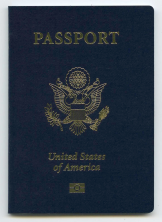
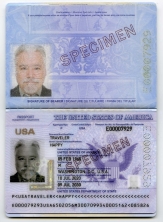
U.S. Passport Card
The U.S. Department of State began issuing the passport card in July 2008. The passport card is a wallet-size card that can only be used for land and sea travel between the United States and Canada, Mexico, the Caribbean, and Bermuda.
Passport card front and back
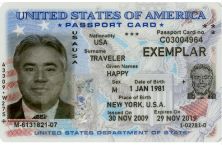
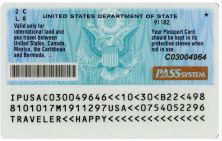
To reduce the risk of fraud and counterfeiting, USCIS redesigns the Permanent Resident Card (PRC) every three to five years. Introduction of new card designs does not mean that cards with previous designs are invalid. Both current and previous cards remain valid until the expiration date shown on the card (unless otherwise noted, such as through an automatic extension of the validity period of a PRC as indicated on a Form I-797, Notice of Action, or in a Federal Register notice). These cards are also known as “Green Cards.”
Current Form I-551, front and back
USCIS began issuing this version of the Permanent Resident Card on January 30, 2023. Some cards issued after that date may still display the previous design because USCIS uses existing card stock until supplies are depleted. This version contains the bearer’s photo on the front and back, name, USCIS number/A-Number, date of birth, and card expiration date, along with updated artwork of the Statue of Liberty, holographic images on the front and back of the card, a new layer-reveal feature with a partial window on the back photo box, and data fields displayed in different places than on previous versions.
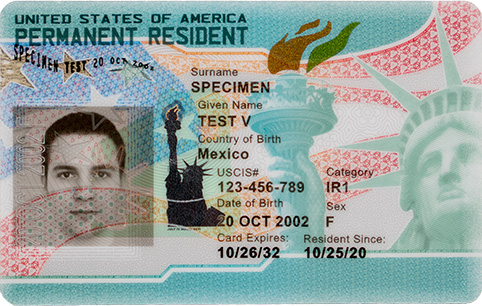
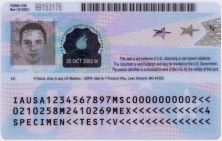
Previous Form I-551, front and back
Starting on May 1, 2017, USCIS issued this version of Form I-551, which contains the bearer’s photo on the front and back, name, USCIS number/A-Number, date of birth, laser-engraved fingerprint, and card expiration date. This card does not have a signature or a black stripe on the back.
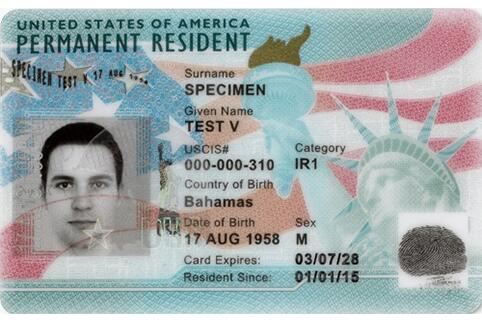
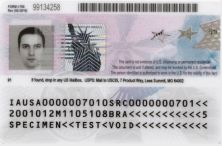
Older Form I-551, front and back
USCIS began issuing this version of Form I-551 in May 2010. This redesign changed the card color to green. The card contains the bearer’s photo, name, USCIS number/A-Number, date of birth, laser-engraved fingerprint, and card expiration date. The USCIS/A-Number is also located on the back of the card.
These cards may or may not contain a signature. A signature is not required for the card to be acceptable for Form I-9 purposes.
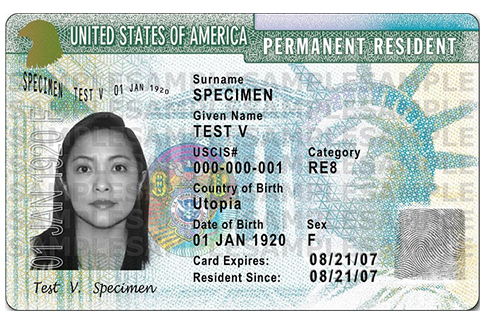
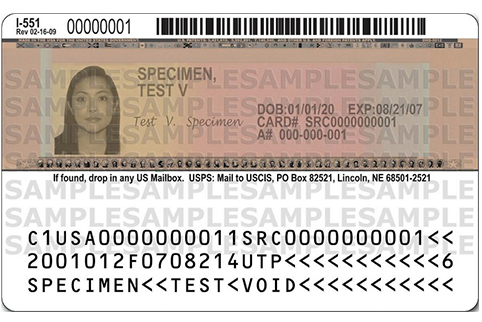
Older Form I-551, front and back
Another older version of the Form I-551 shows the DHS seal and contains a detailed hologram on the front of the card. Each card is personalized with an etching showing the bearer’s photo, name, fingerprint, date of birth, A-Number, and the card expiration date.
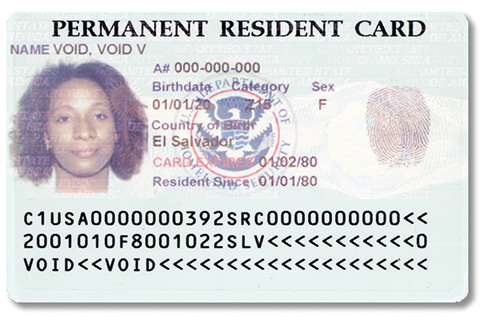
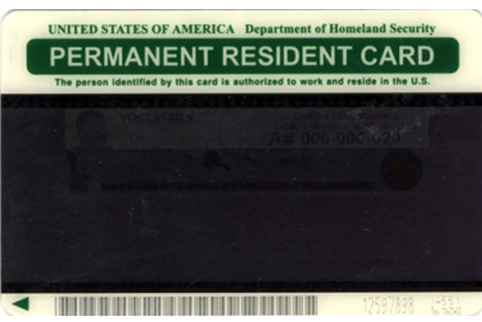
Some employees may also have older Resident Alien cards, issued by the U.S. Department of Justice, Immigration and Naturalization Service, which do not have expiration dates and are valid indefinitely. These cards are peach in color and contain the bearer’s fingerprint and photograph.
USCIS uses either an I-551 (ADIT) stamp or a temporary I-551 printed notation on a machine-readable immigrant visa (MRIV) to indicate temporary evidence of lawful permanent residence. Sometimes, if no foreign passport is available, USCIS will place the I-551 stamp on a Form I-94 and affix a photograph of the bearer to the form. This document is considered a receipt.
Unexpired Foreign Passport with I-551 Stamp
The temporary Form I-551 MRIV is evidence of permanent resident status for one year from the date of admission.

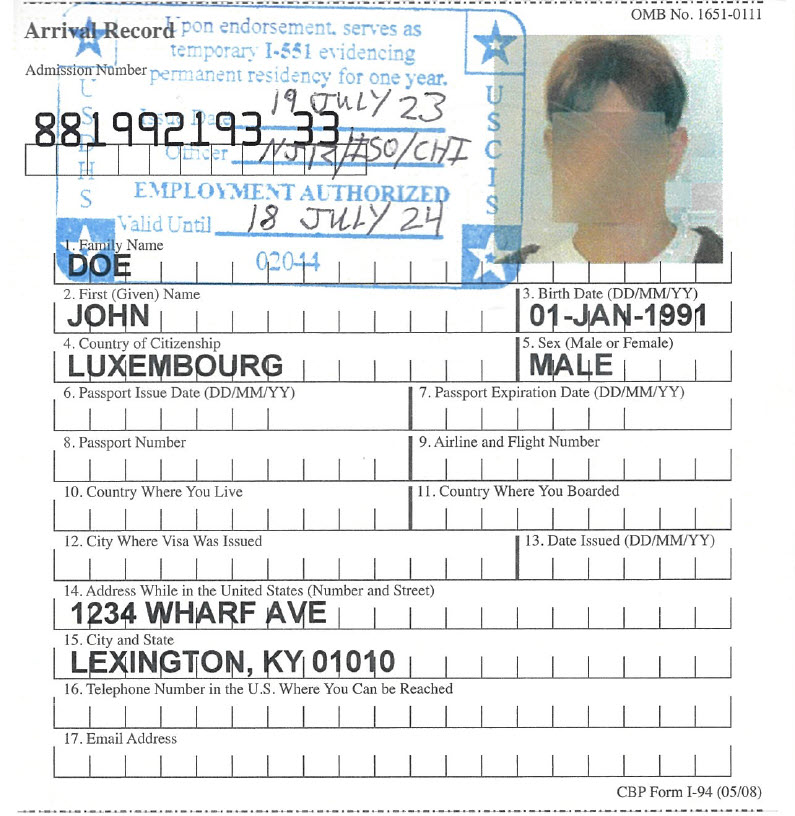
Temporary I-551 printed notation on a machine-readable immigrant visa (MRIV)
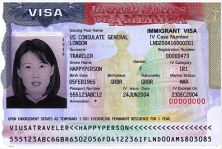
USCIS began issuing this design of the Employment Authorization Document (EAD) on January 30, 2023. Some cards issued after that date may still display the previous design because USCIS uses existing card stock until supplies are depleted. Both the current and previous EADs will remain valid until the expiration date shown on the card (unless otherwise noted, such as through an automatic extension of the validity period of the EAD as indicated on a Form I-797, Notice of Action, or in a Federal Register notice).
This version contains the bearer’s photo on the front and back, name, USCIS number, date of birth, and card expiration date along with updated artwork of the Statue of Liberty, holographic images on the front and back of the cards, a new layer-reveal feature with a partial window on the back photo box; and data fields displayed in different places than on previous versions.
Cards may contain one of the following notations below the expiration date:
- “Not Valid for Reentry to U.S.;”
- “Valid for Reentry to U.S.;” or
- “Serves as I-512 Parole.”
Current EAD, front and back
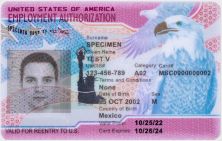

Previous EAD, front and back
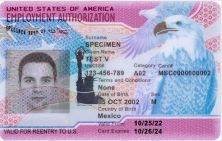

CBP and USCIS issue Form I-94, Arrival/Departure Record, to nonimmigrants. This document indicates the bearer’s class of admission, date of entry, and date their immigration status expires. Generally, employees download it from cbp.gov. If an employee presents a paper Form I-94, it may show a stamped or handwritten date. They may present Form I-94 with documents that Form I-9 specifies are valid as a combination of documents, such as Form I-94 presented with a foreign passport, and Form DS-2019 or Form I-20.
Electronic Form I-94
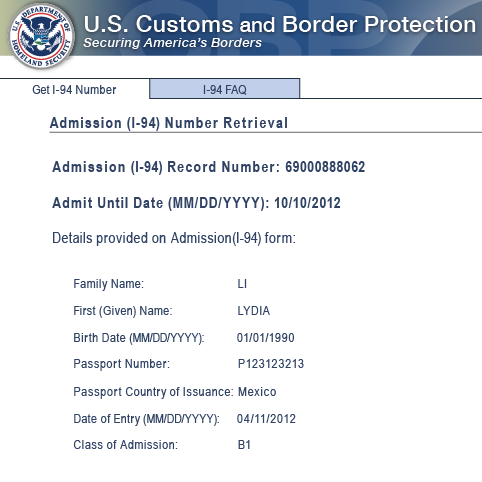
Form I-94, Arrival/Departure Record
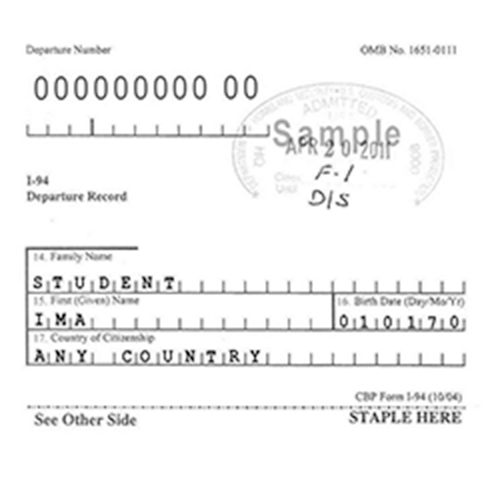
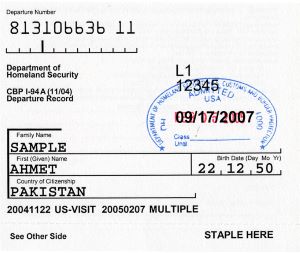
Form I-20 accompanied by Form I-94
For curricular practical training, F-1 nonimmigrant students with a Form I-94, Arrival/Departure Record, must also have Form I-20, Certificate of Eligibility for Nonimmigrant Students, endorsed with employment authorization by the designated school official. USCIS issues an EAD to all F-1 students who are authorized for optional practical training (OPT) and M-1 students authorized for practical training. See Section 7.4.2, F-1 and M-1 Nonimmigrant Students, for more information on Form I-20.
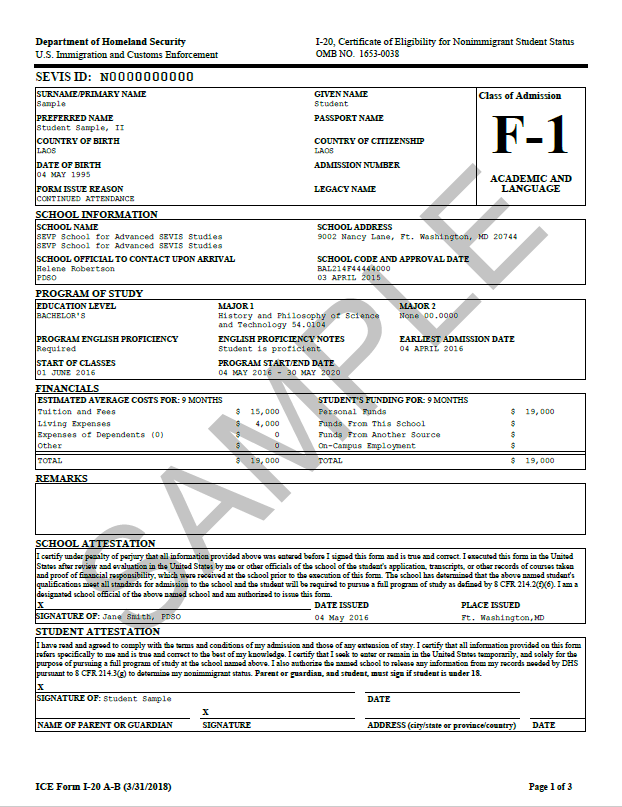
See Form I-94 above.
Form DS-2019 accompanied by Form I-94
J-1 nonimmigrant exchange visitors must have a Form I-94, Arrival/Departure Record, accompanied by an unexpired Form DS-2019, Certificate of Eligibility for Exchange Visitor (J-1) Status, issued by the U.S. Department of State, that specifies the sponsor. J-1 exchange students also need a letter from their responsible officer authorizing their employment. See Section 7.4.1, Exchange Visitors (J-1), for more information on DS-2019.
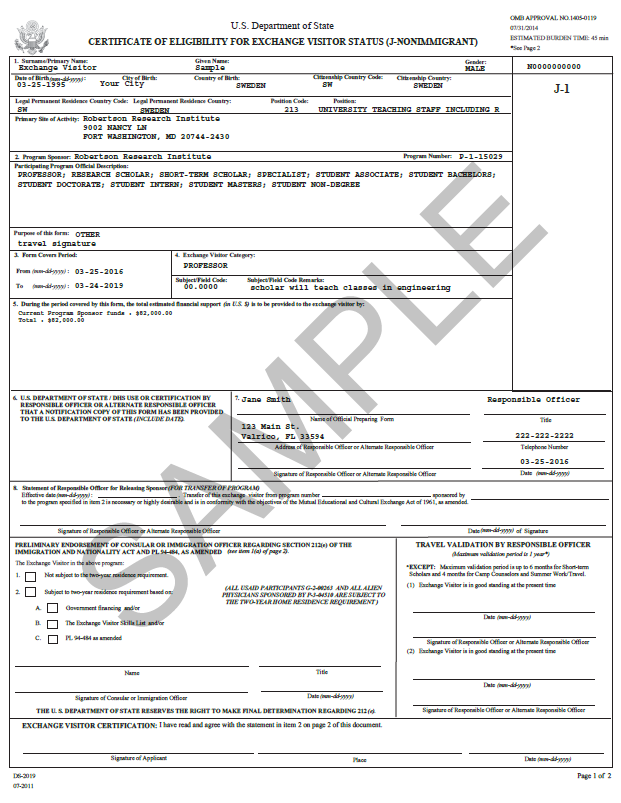
See Form I-94 above.
In 2003, Compacts of Free Association (CFA) between the United States and the Federated States of Micronesia (FSM) and Republic of the Marshall Islands (RMI) were amended to allow citizens of these countries to work in the United States without obtaining an EAD.
For Form I-9 purposes, citizens of these countries may present FSM or RMI passports accompanied by a Form I-94 indicating nonimmigrant admission under the CFA, which are acceptable documents under List A. The exact notation on Form I-94 may vary and is subject to change. The notation on Form I-94 typically states “CFA/FSM” for an FSM citizen and “CFA/MIS” for an RMI citizen.
Passport of the Federated States of Micronesia and the Republic of the Marshall Islands
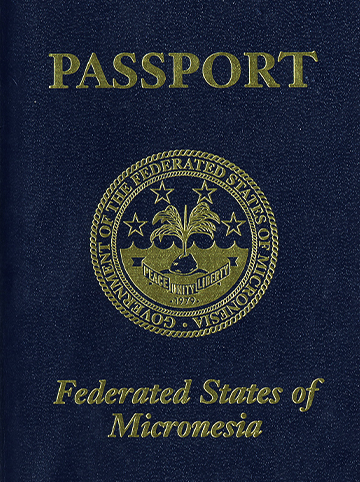
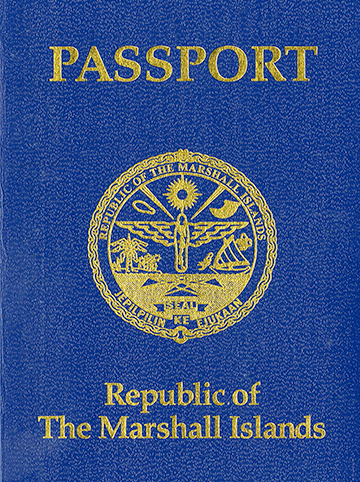
- Receipt for a replacement of a lost, stolen, or damaged List A document.
- Form I-94 issued to a lawful permanent resident that contains an I-551 stamp and a photograph of the individual.
- Form I-94 with “RE” notation or refugee stamp issued to a refugee.
May be presented in lieu of a document listed above for a temporary period. For receipt validity dates, see the M-274, Section 4.4 Acceptable Receipts.
13.2 List B Documents That Establish Identity
The illustrations do not reflect the actual size of the documents.
A driver’s license can be issued by any state or territory of the United States (including the District of Columbia, Puerto Rico, the U.S. Virgin Islands, Guam, American Samoa, and the Commonwealth of the Northern Mariana Islands) or by a Canadian government authority. You may accept a driver's license if it contains a photograph or, if it does not contain a photograph, it includes identifying information such as name, date of birth, gender, height, eye color, and address.
Some states may place restrictive notations on their licenses. For Form I-9 purposes, you may accept these licenses.
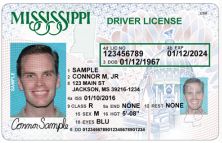
An ID card can be issued by any state (including the District of Columbia, Puerto Rico, the U.S. Virgin Islands, Guam, American Samoa, and the Commonwealth of the Northern Mariana Islands) or local government. You may accept an ID card if it contains a photograph or, if it does not contain a photograph, it includes identifying information, such as name, date of birth, gender, height, eye color, and address.
Some states may place restrictive notations on their ID cards. For Form I-9 purposes, you may accept these cards.
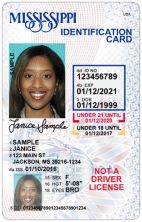
Example image not available.
Example image not available.
ID card issued to active-duty U.S. military personnel, selected reserve, Department of Defense civilian employees and eligible contractor personnel.
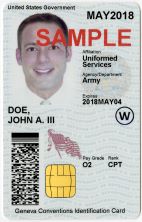
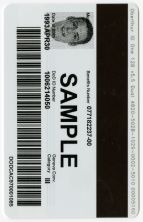
ID Card for U.S. military family members and U.S. military retirees.
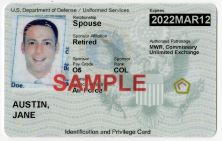
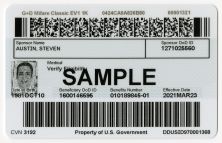
Example image not available.
Example image not available.
Example image not available.
Example images not available.
10. School record or report card
11. Clinic, doctor, or hospital record
12. Day-care or nursery school record
Receipt for a replacement of a lost, stolen, or damaged List B document may be presented in lieu of a document listed above for a temporary period.
For receipt validity dates, see the M-274, Section 4.4 Acceptable Receipts.
13.3 List C Documents That Establish Employment Authorization
The illustrations do not reflect the actual size of the documents.
U.S. Social Security account number card that is unrestricted. A laminated card is acceptable. A card that includes any of the following restrictive wording is not an acceptable List C document:
- NOT VALID FOR EMPLOYMENT
- VALID FOR WORK ONLY WITH INS AUTHORIZATION
- VALID FOR WORK ONLY WITH DHS AUTHORIZATION
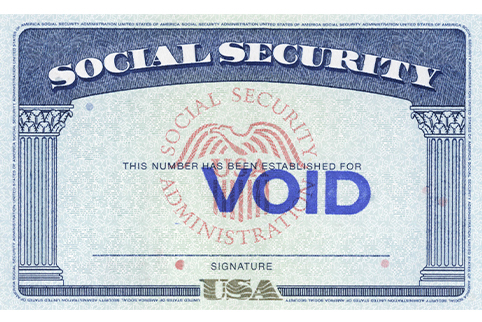
These documents may vary in color and paper used. All will include a raised seal of the office that issued the document, and may contain a watermark and raised printing.
F-545, Certification of Birth Abroad, issued by the U.S. Department of State
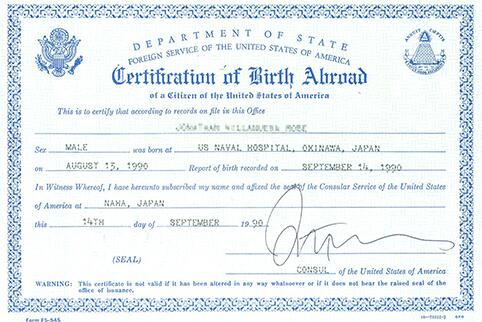
DS-1350, Certification of Report of Birth, issued by the U.S. Department of State
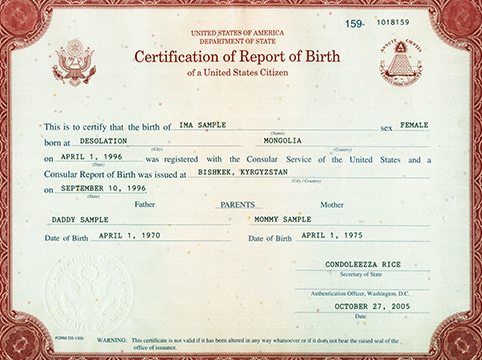
FS-240, Consular Report of Birth Abroad, issued by the U.S. Department of State
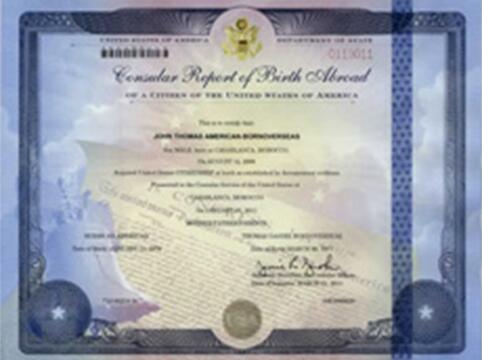
You may only accept an original or certified copy of a birth certificate issued by a state, county, municipal authority, or outlying possession of the United States that bears an official seal. Versions will vary by state and year of birth.
You may only accept a Puerto Rico birth certificate issued on or after July 1, 2010.
Birth Certificate
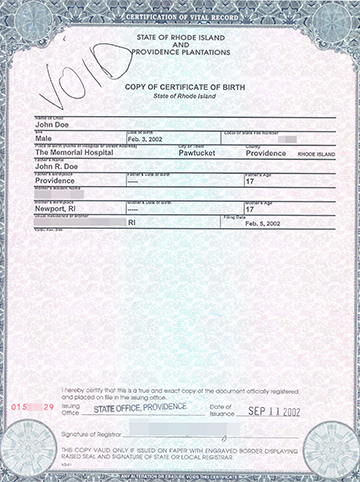
Example images not available.
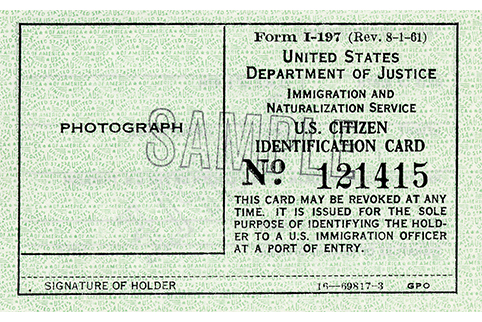
INS issued Forms I-179 to U.S. citizens who are residents of the United States. This card does not contain an expiration date, and is valid indefinitely.
Form I-179, Identification Card for Use of Resident Citizen in the United States
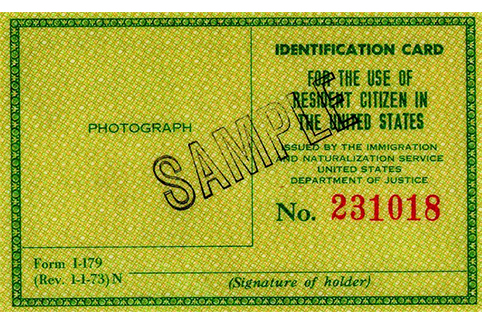
Some employment authorization documents issued by DHS include but are not limited to:
- Form I-94 Arrival/Departure Record issued to asylees or work-authorized nonimmigrants (for example, H-1B nonimmigrants) because of their immigration status,
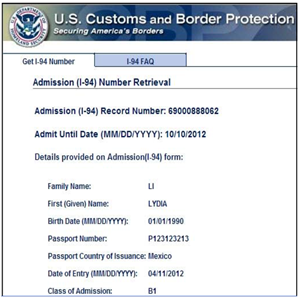

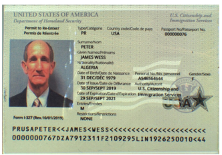
- An unexpired Form I-327, Reentry Permit,
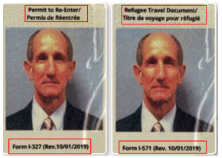
- Form N-560, Certificate of U.S. Citizenship or Form N-561, Replacement Certificate of Citizenship (PDF, 40.3 KB), or
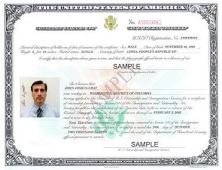
- Form N-550, Certificate of Naturalization or Form N-570, Replacement Certificate of Naturalization (PDF, 176.3 KB).
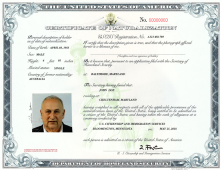
A Form I-797 issued to a conditional resident may be an acceptable List C document in combination with an expired Form I-551.
The Form I-9 contact center can assist with questions on DHS-issued documents.
Receipt for a replacement of a lost, stolen, or damaged List C document may be presented in lieu of a document listed above for a temporary period.
For receipt validity dates, see the M-274, Section 4.4 Acceptable Receipts.
14.0 Some Questions You May Have About Form I-9
Employers and employees can find more Form I-9 information on I-9 Central at uscis.gov/i-9-central.
1. Do citizens and noncitizen nationals of the United States need to complete Form I-9?
Yes. While citizens and noncitizen nationals of the United States are automatically eligible for employment, they too must present the required documents and complete Form I-9, Employment Eligibility Verification. U.S. citizens include persons born in the United States, Puerto Rico, Guam, the U.S. Virgin Islands, and the Commonwealth of the Northern Mariana Islands. U.S. noncitizen nationals are persons who owe permanent allegiance to the United States, which include those born in American Samoa, including Swains Island. Citizens of the Federated States of Micronesia (FSM) and the Republic of the Marshall Islands (RMI) are not noncitizen nationals, however they are eligible to work in the United States.
2. Do I need to complete Form I-9 for independent contractors or their employees?
No. For example, if you contract with a construction company to perform renovations on your building, you do not have to complete Form I-9 for that company’s employees. The construction company is responsible for completing Form I-9 for its own employees. However, you may not use a contract, subcontract, or exchange to obtain the labor or services of an employee you know is unauthorized to work.
3. What happens if I properly complete and retain a Form I-9 and DHS discovers that my employee is not actually authorized to work?
You will have a good faith defense against the imposition of employer sanctions penalties for knowingly hiring an unauthorized individual, unless the government can show you had knowledge of the employee’s unauthorized status.
4. Can I ask an employee to show a specific document when completing Form I-9?
No. The employee may choose which document(s) they present from the Lists of Acceptable Documents. You must accept any document (from List A) or combination of documents (one from List B and one from List C) listed on Form I-9 and found in Section 13.0 that reasonably appear to be genuine and to relate to the person presenting them. To do otherwise could be an unfair immigration-related employment practice that violates the anti-discrimination provision in the INA. You must not treat individuals who look and/or sound foreign differently in the recruiting, hiring, or verification process.
For more information about discrimination during the Form I-9 process, contact IER’s employer hotline at 800-255-8155 (TTY for the deaf or hard of hearing: 800-237-2515) or visit their website at justice.gov/ier.
Note: Employers who participate in E-Verify can only accept a List B document if it contains a photograph.
5. What is my responsibility concerning the authenticity of document(s) an employee presents to me?
You must examine the original documentation, and if it reasonably appears to be genuine and to relate to the person presenting them, you must accept it. To do otherwise could be an unfair immigration-related employment practice. If the documentation does not reasonably appear to be genuine or to relate to the person presenting it, you must not accept it.
However, you must provide the employee with an opportunity to present other documents from the Lists of Acceptable Documents.
6. May I accept a copy of a document from an employee?
Employers examining employees’ documents in person may only accept original documentation from employees. The only exception is that an employee may present a certified copy of a birth certificate. E-Verify participants in good standing that choose to remotely examine employees’ Form I-9 documentation may accept copies of documentation, but must then view original documentation in a live video interaction, as explained in the Form I-9 instructions and in Section 4.5, Remote Document Examination (Optional Alternative Procedure to Physical Document Examination).
7. When can employees present receipts for documents in place of actual documents from the Lists of Acceptable Documents?
The “receipt rule” is designed to cover situations in which an employee is authorized to work at the time of initial hire or reverification, but does not have the actual document listed on the Lists of Acceptable Documents. You cannot accept a receipt showing the employee has applied for an initial grant of employment authorization and/or an EAD. See Section 4.4, Acceptable Receipts, for more information.
8. My new employee presented two documents to complete Form I-9, each containing a different last name. One document matches the name she entered in Section 1. The employee explained that she had just gotten married and changed her last name, but had not yet changed the name on the other document. Can I accept the document with the different name?
You may accept a document with a different name than the name entered in Section 1 if the document reasonably relates to the employee. You also may attach a brief memo to the employee’s Form I-9 stating the reason for the name discrepancy, along with any supporting documentation she provides. An employee may provide documentation to support a name change, but is not required to do so. If you determine the document containing a different name does not reasonably appear to be genuine and to relate to the employee, you may ask her to provide other documents from the Lists of Acceptable Documents on Form I-9.
9. The name on the document my employee presented to me is spelled slightly differently than the name they entered in Section 1 of Form I-9. Can I accept this document?
If the document contains a slight spelling variation, and the employee has a reasonable explanation for the variation, the document is acceptable if you are satisfied that the document otherwise reasonably appears to be genuine and to relate to the employee.
10. My employee’s EAD expired and now they want to show me a Social Security card. Do I need to see a current DHS document?
No. During reverification, you must allow an employee to choose what document to present from either List A or List C. If the employee presents an unrestricted Social Security card, the employee does not also need to present a current DHS document. However, if the employee presents a restricted Social Security card, you must reject it since it is not an acceptable Form I-9 document and ask the employee to choose a different document from List A or C.
Appendix A: Common Abbreviations for Document Entry in Section 2
This appendix includes common abbreviations for some of the documents that employees may present from the Lists of Acceptable Documents. This appendix is not an exhaustive list of all the documents an employee may choose to present. See the Lists of Acceptable Documents on Form I-9 for a complete list.
| Full name of List A Document | Common Abbreviation |
|---|---|
| Permanent Resident Card (Form I-551) | Form I-551 or PRC |
| Alien Registration Receipt Card (Form I-551) | Form I-551 or PRC |
| Foreign passport containing a temporary I-551 stamp, also known as Alien Documentation, Identification and Telecommunication (ADIT) stamp. |
1. Foreign Passport 2. I-551 or ADIT Stamp |
|
Foreign passport containing a temporary I-551 printed notation on a machine-readable immigrant visa (MRIV) |
1. Foreign Passport 2. MRIV |
|
Employment Authorization Document (Form I-766) |
Form I-766 or EAD |
| For a nonimmigrant noncitizen authorized to work for a specific employer because of his or her status, a foreign passport with Form I-94 that contains an endorsement of the noncitizen’s nonimmigrant status. |
1. Foreign Passport 2. Form I-94 3. Form I-20 or Form DS-2019 Note: In limited circumstances, certain J-1 students may be required to present a letter from their Responsible Officer to work. Enter the document title, issuing authority, document number and expiration date from this document in the Additional Information field. |
|
Passport from the Federated States of Micronesia (FSM) with Form I-94 |
1. FSM Passport with Form I-94 2. Form I-94 |
|
Passport from the Republic of the Marshall Islands (RMI) with Form I-94 |
1. RMI Passport with Form I-94 2. Form I-94 |
|
Receipt: The arrival portion of Form I-94 containing a temporary I-551 (ADIT) stamp and photograph |
Receipt: Form I-94 w/I-551 stamp, photo |
|
Receipt: The departure portion of Form I-94 with an unexpired refugee admission stamp |
Receipt: Form I-94 w/refugee stamp |
|
For receipts, indicate Receipt in the field along with the appropriate abbreviation above, if provided. For example, to document a receipt for the application to replace a lost, stolen or damaged, Permanent Resident Card (Form I-551), you could enter the following: |
Receipt replacement Form I-551 or PRC |
| Full name of List B Document | Abbreviations |
|---|---|
| Driver's license issued by a State or outlying possession of the United States | DL plus the state. For example, enter VA DL for a driver’s license issued by the Commonwealth of Virginia |
|
ID card issued by a State or outlying possession of the United States |
ID plus the state. For example, enter NY ID for an ID Card issued by the State of New York |
|
ID card issued by federal, state, or local government agencies or entities |
Government ID |
| School ID card with photograph | School ID |
| U.S. Coast Guard Merchant Mariner Card | USCG Merchant Mariner card |
|
Driver's license issued by a Canadian government authority |
Canadian DL |
|
School record (for persons under age 18 who are unable to present a document listed above) |
School record (under age 18) |
|
Report card (for persons under age 18 who are unable to present a document listed above) |
Report card (under age 18) |
|
Clinic record (for persons under age 18 who are unable to present a document listed above) |
Clinic record (under age 18) |
|
Doctor record (for persons under age 18 who are unable to present a document listed above) |
Doctor record (under age 18) |
|
Hospital record (for persons under age 18 who are unable to present a document listed above) |
Hospital record (under age 18) |
|
Day-care record (for persons under age 18 who are unable to present a document listed above) |
Day-care record (under age 18) |
|
Nursery school record (for persons under age 18 who are unable to present a document listed above) |
Nursery school record (under age 18) |
|
Individual under age 18 endorsement by parent or guardian |
Individual under Age 18 |
|
Special placement endorsement for persons with disabilities |
Special Placement |
| For receipts, indicate Receipt in the field along with the appropriate abbreviation above, if provided. For example, to document a receipt for the application to replace a lost, stolen or damaged Driver's License issued by a State or outlying possession of the United States, you could enter the following: | Receipt: Replacement VA DL |
| Full name of List C Document | Abbreviations |
|---|---|
|
Social Security Account Number card without restriction |
SS Card |
| Certification of Birth Abroad (Form FS-545) | Form FS-545 |
|
Certification of Report of Birth (Form DS-1350) |
Form DS-1350 |
|
Consular Report of Birth Abroad (Form FS-240) |
Form FS-240 |
| Original or certified copy of a U.S. birth certificate bearing an official seal | Birth Certificate |
| U.S. Citizen ID Card (Form I-197) | Form I-197 |
|
Identification Card for use of Resident Citizen in the United States (Form I-179) |
Form I-179 |
|
Employment authorization document issued by DHS (List C #7) |
Employment Auth. document (DHS) List C #7 |
|
For receipts, indicate Receipt in the field along with the appropriate abbreviation above, if provided. For example, to document a receipt for the application to replace a lost, stolen or damaged Social Security Account Number Card without restrictions, you could enter the following: |
Receipt: Replacement SS Card |
Summary of Changes
The purpose of this document is to outline significant changes made to the M-274, Handbook for Employers: Guidance for Completing Form I-9.
Updates Based on Form I-9 Revision 07/31/2023
- Removed all references to previous enhancements and completing the form using a computer.
- Changed all instances of “alien authorized to work” to “noncitizen authorized to work” throughout the Handbook.
- Revised Section 3.0 to reflect the new Supplement A, Preparer and/or Translator Certification and added guidance regarding its use.
- Added a new Section 4.5 as well as guidance throughout the handbook on implementing the alternative procedure for examining Form I-9 documentation remotely, including use of the checkbox on Form I-9 and new document retention requirements.
- Revised Section 6 to remove references to the former Section 3 and incorporate the new title, placement and usage guidance for Supplement B, Reverification and Rehire, that replaces Section 3.
- Added list of acceptable receipts in Section 13 to mirror the addition of acceptable receipts on the new Lists of Acceptable Documents for Form I-9.
- Added appendix with the lists of common abbreviations for Section 2 document entry that was removed from the previous Form I-9 instructions.
New Guidance
- Section 4.4: Added acceptable receipts for certain Afghan and Ukrainian parolees.
- Section 5: In 2022, USCIS revised the Automatic Extensions of Employment Authorization and/or Employment Authorization Documents (EADs) in Certain Circumstances section to reflect the 540-day automatic extension temporary final rule. In this revision, USCIS made further changes to reflect parts of the temporary final rule that have expired or will expire soon.
- Section 5.3: Provided new guidance in the Automatic EAD Extensions for Temporary Protected Status (TPS) Beneficiaries section to reflect USCIS’s use of individual notices to extend certain EADs.
- Section 10: Added link to new Form I-9 retention calculator.
- Updated Section 13 to include descriptions and images of newly designed Form I-551, Permanent Resident Cards and Form I-766, Employment Authorization Documents.
Clarifications
- Section 2.0: Clarified that authorized representatives who are also notaries do not act as notaries when completing Forms I-9 for an employer.
- Section 4: Added a table to help employers more quickly find information on special situations they may encounter when verifying documentation for certain employees.
- Section 7.3: Added two tables to clarify documents that refugees and asylees may present for Form I-9 and whether those documents require reverification.
- Section 7.4.2: Clarified Form I-9 documentation that F-I students are required to present for on-campus employment.
